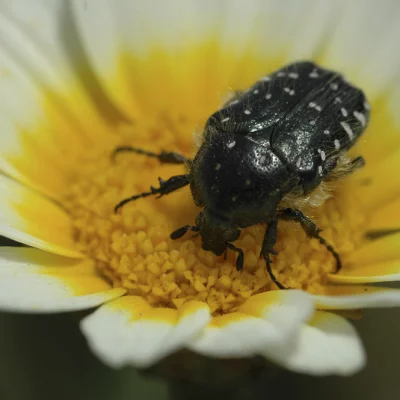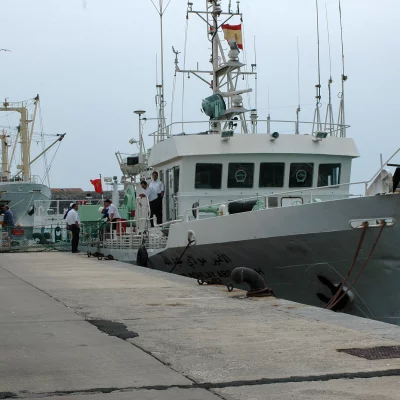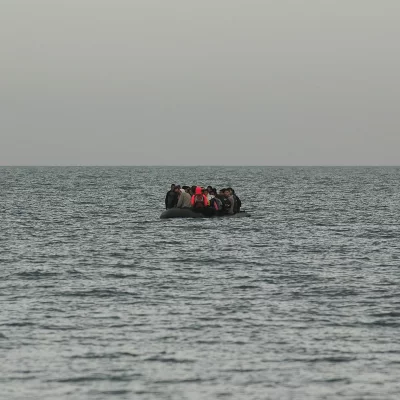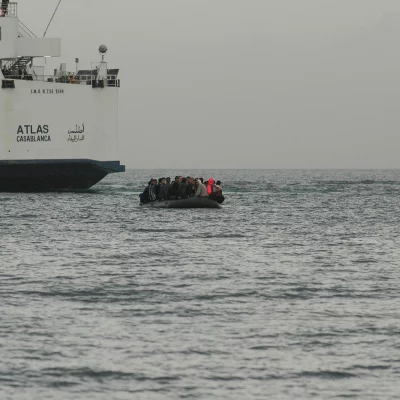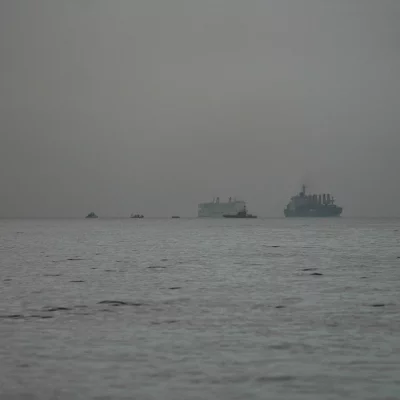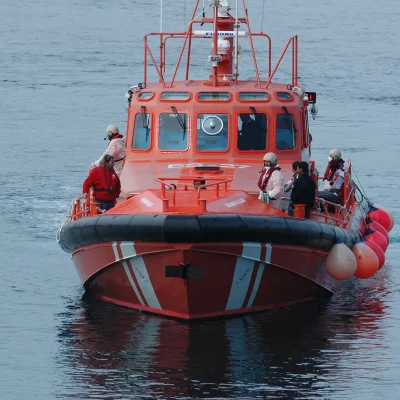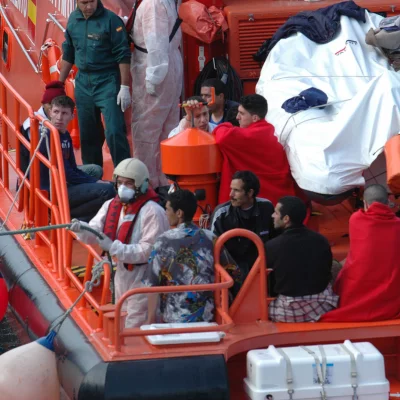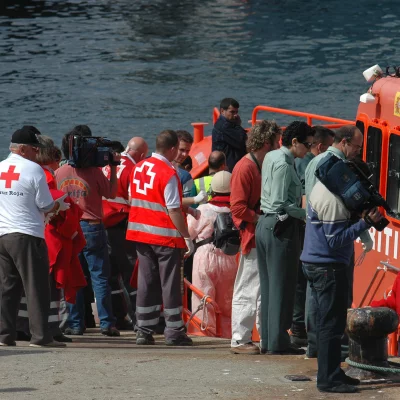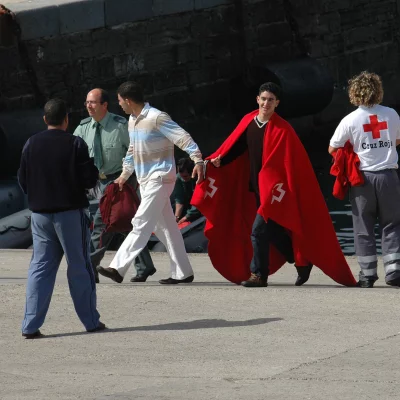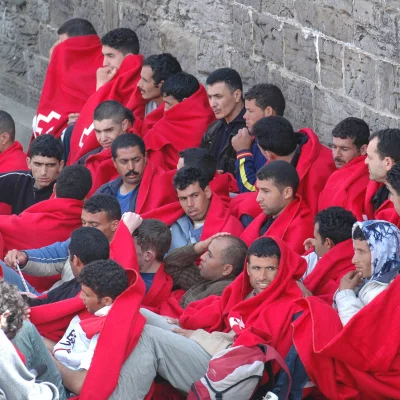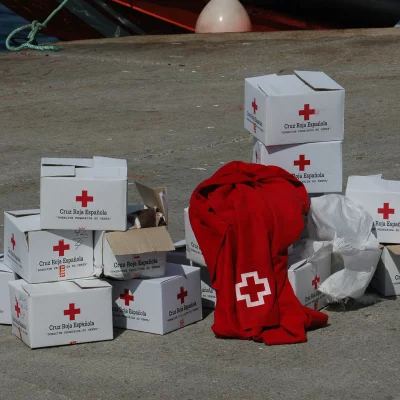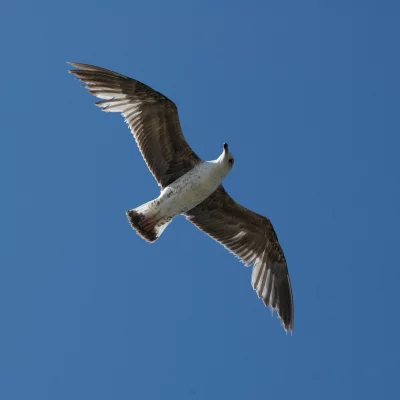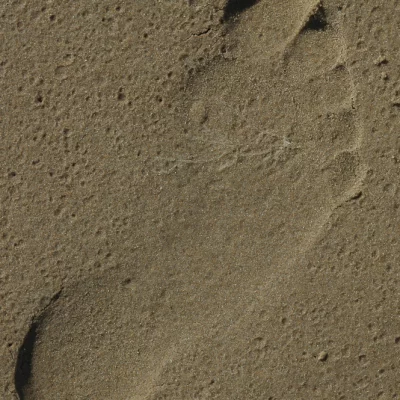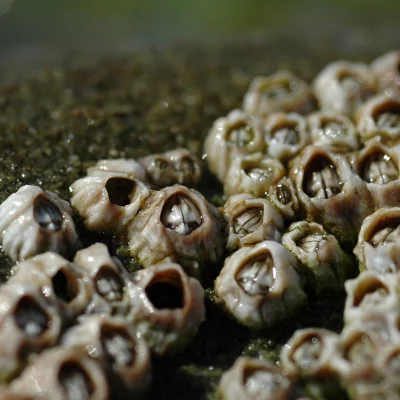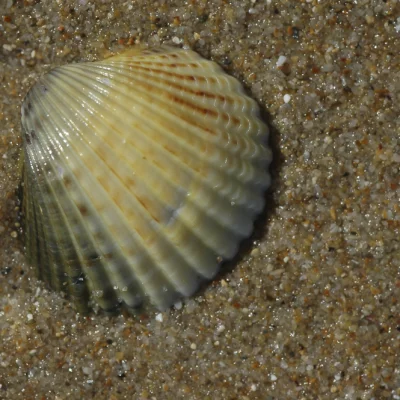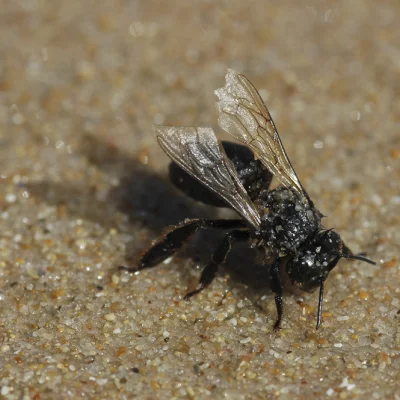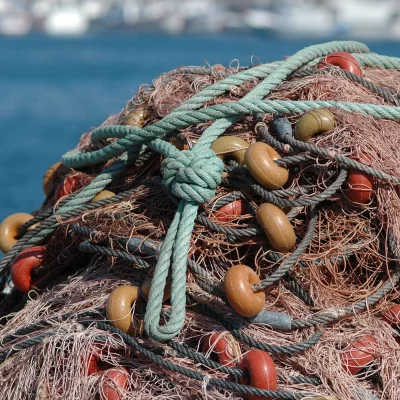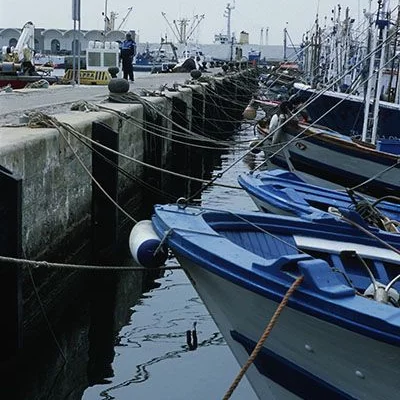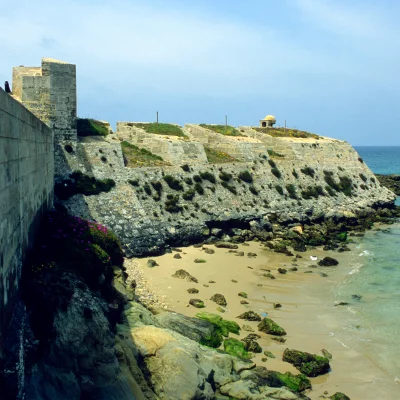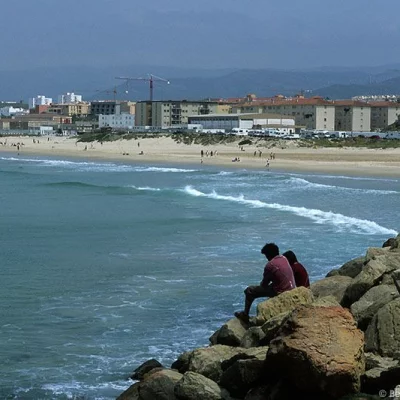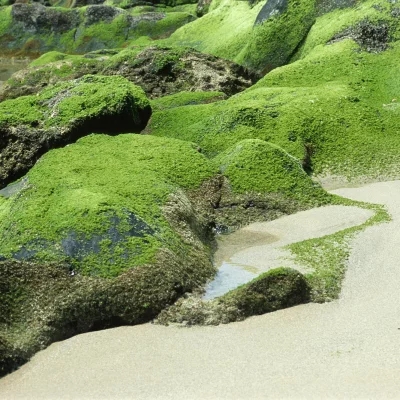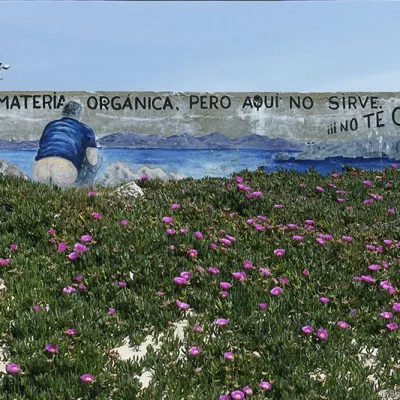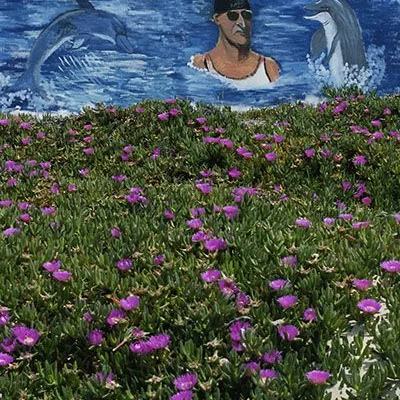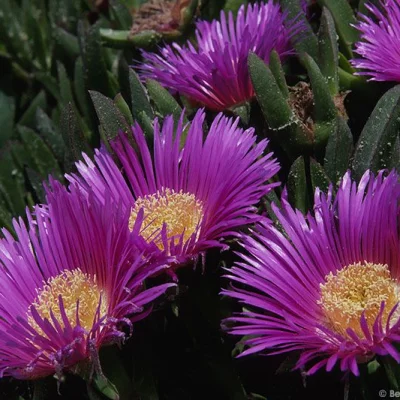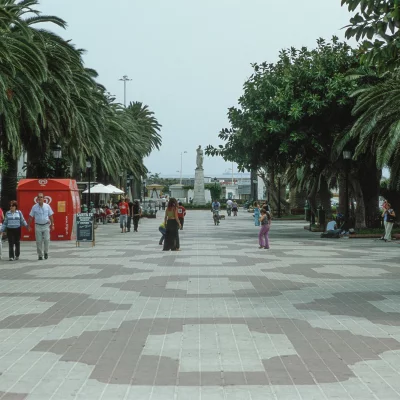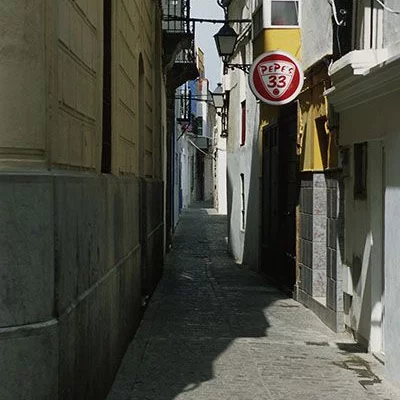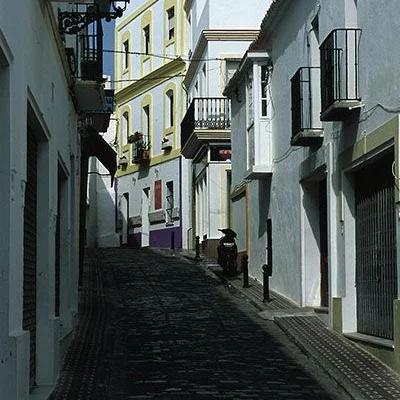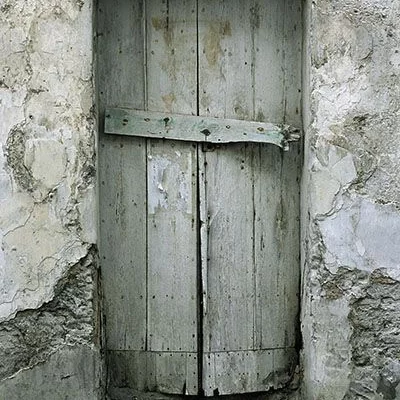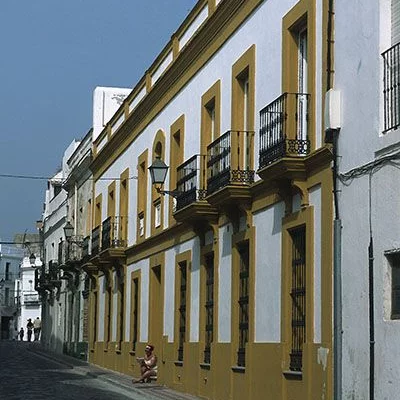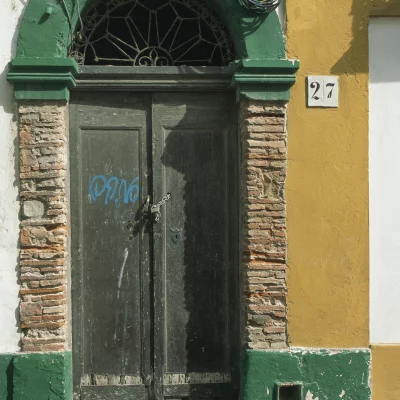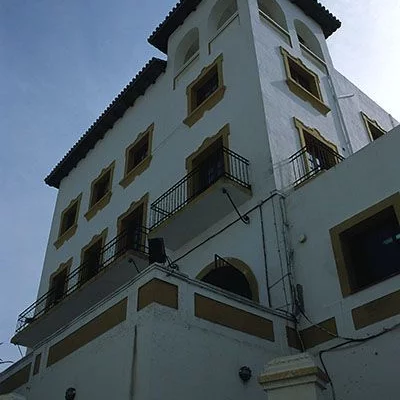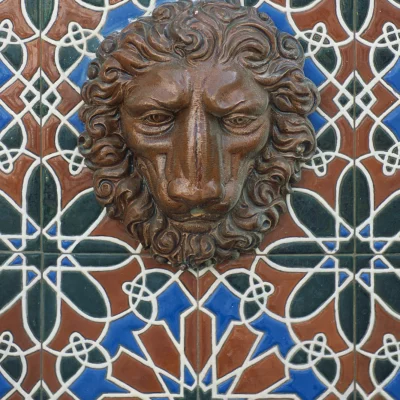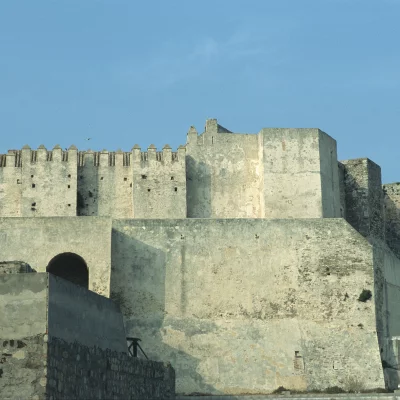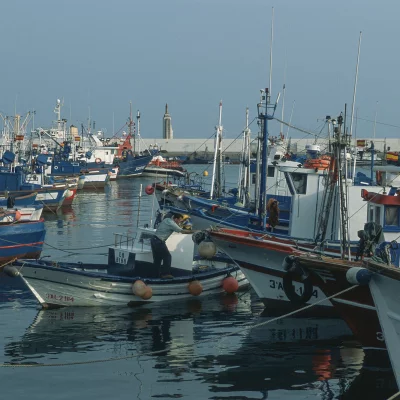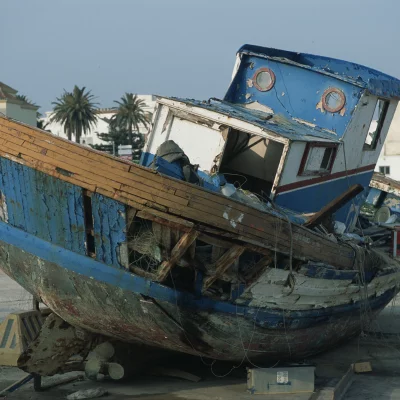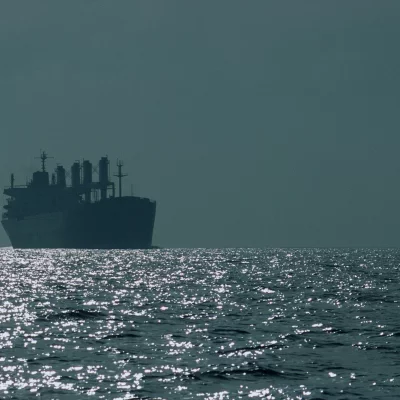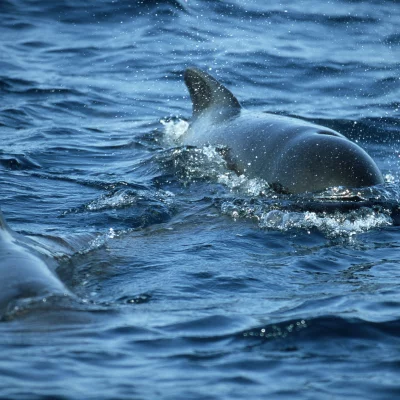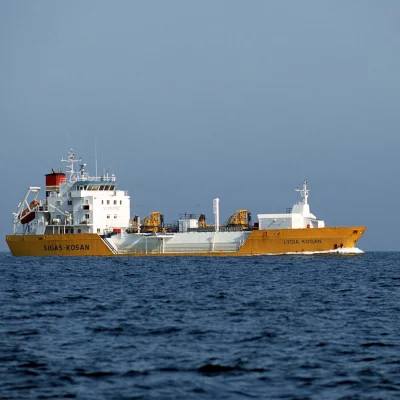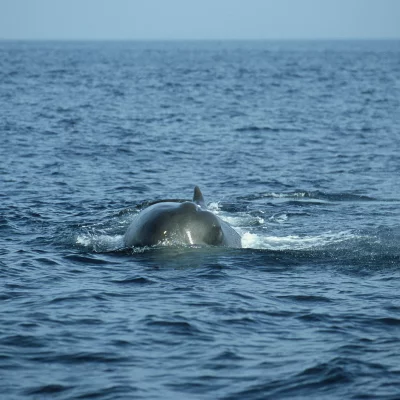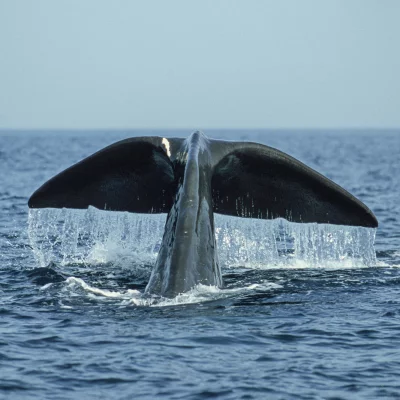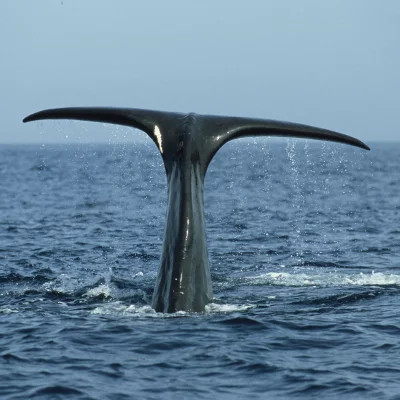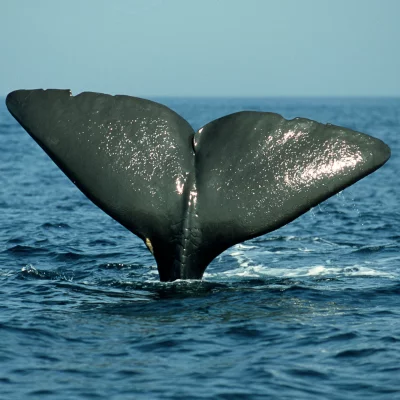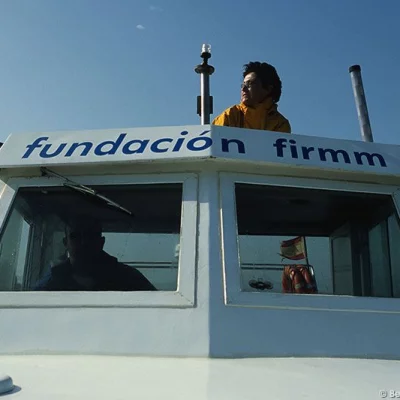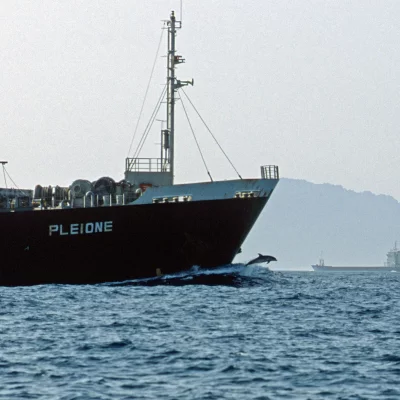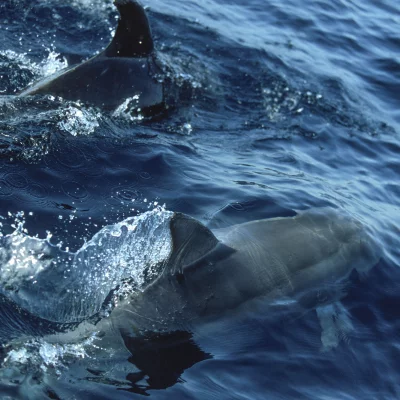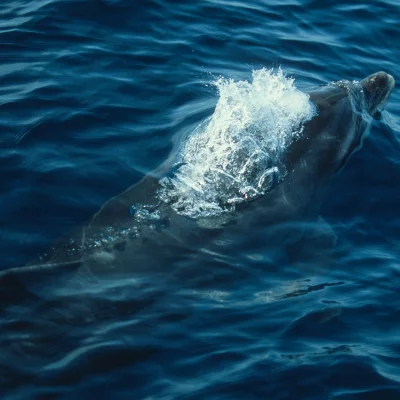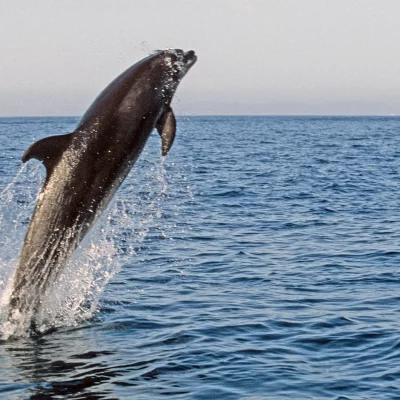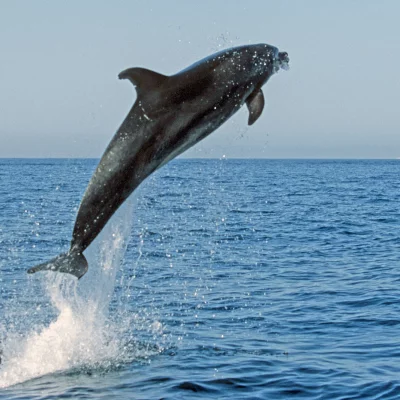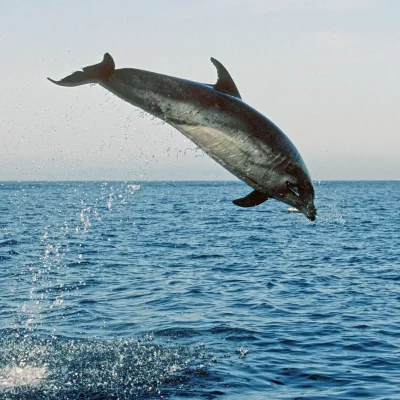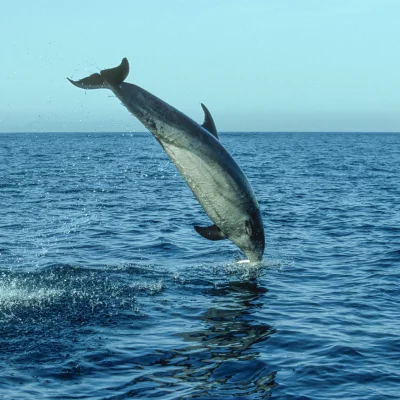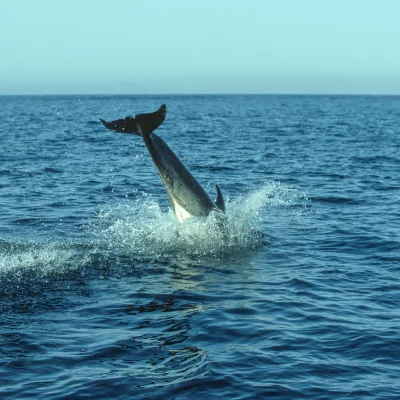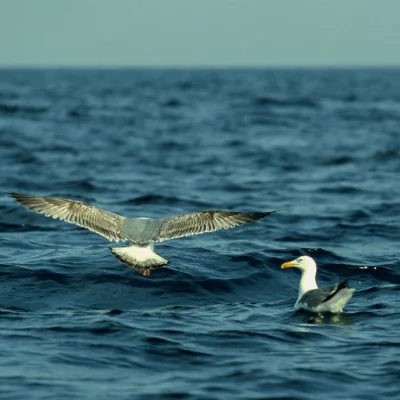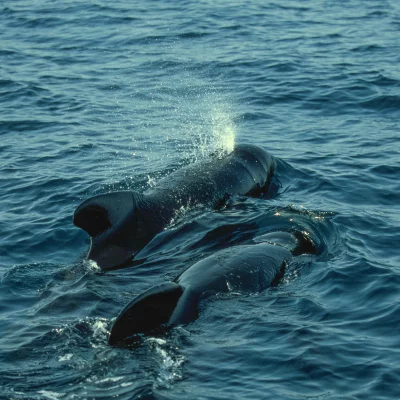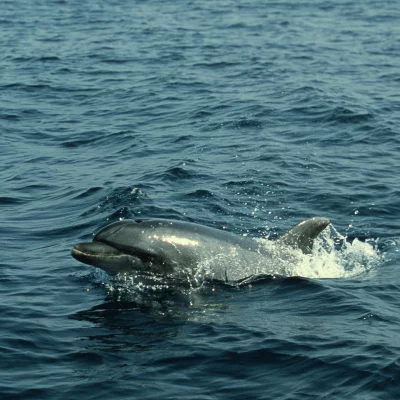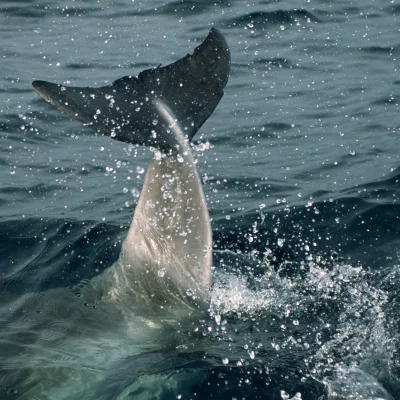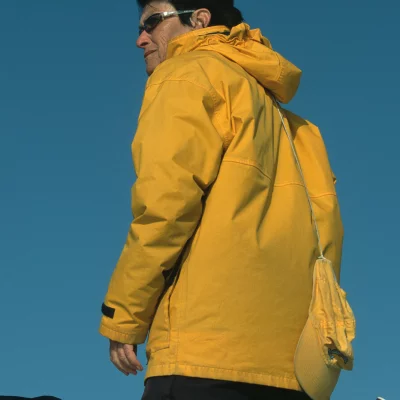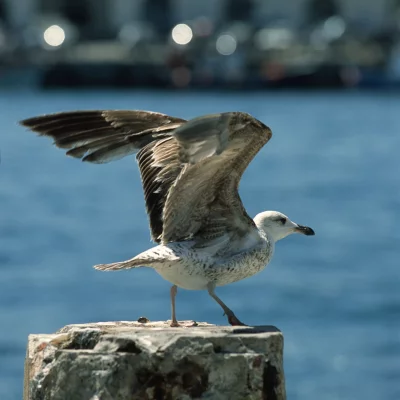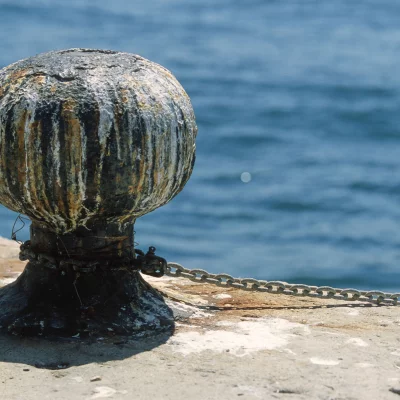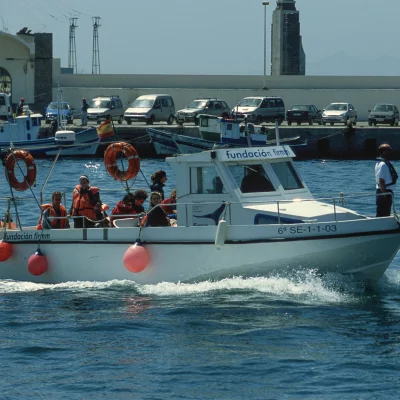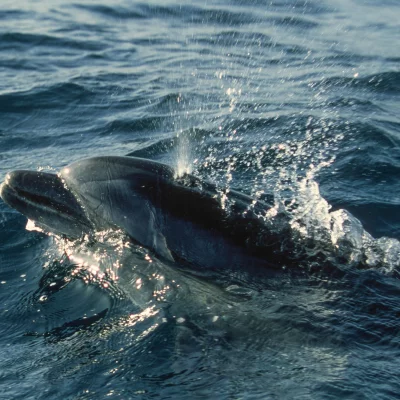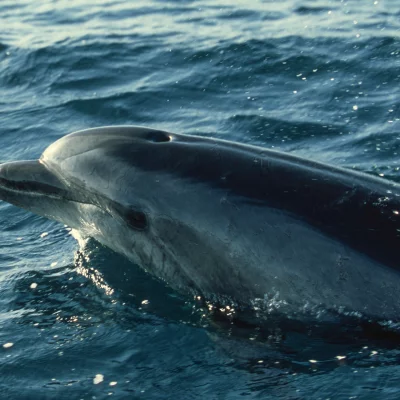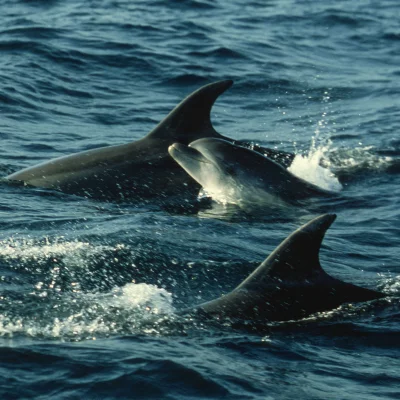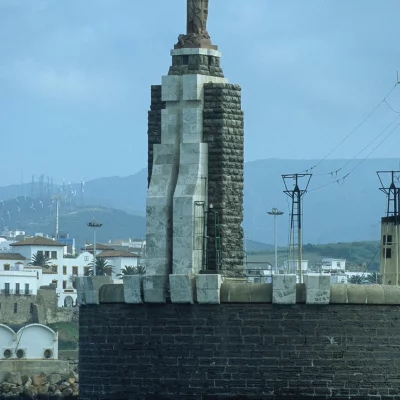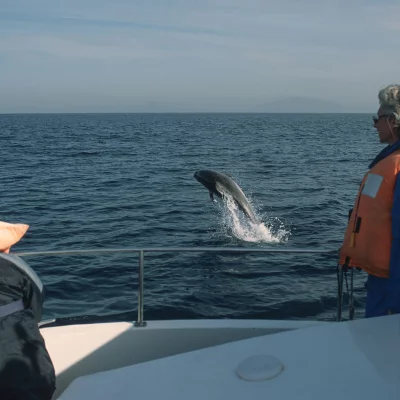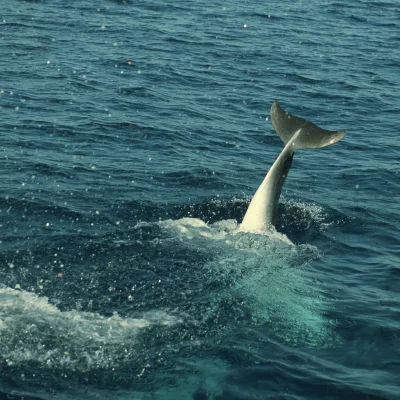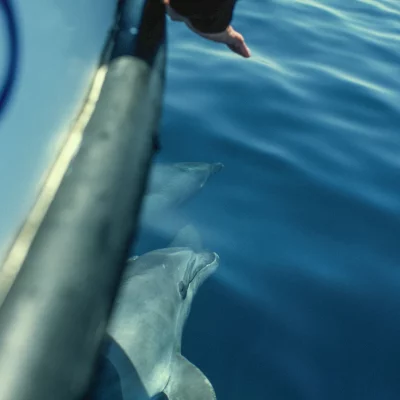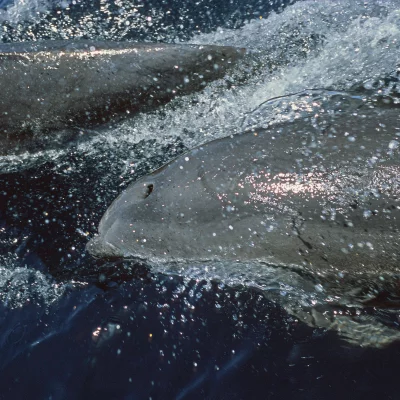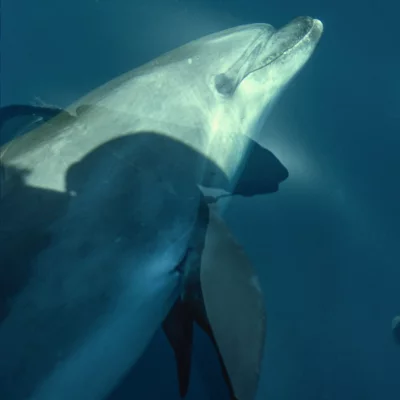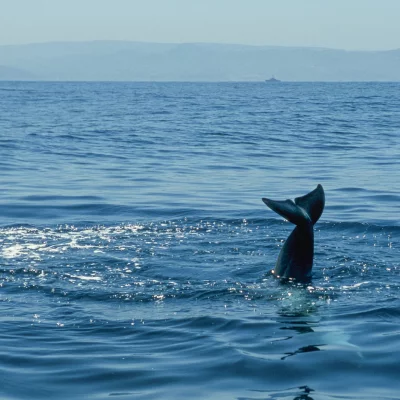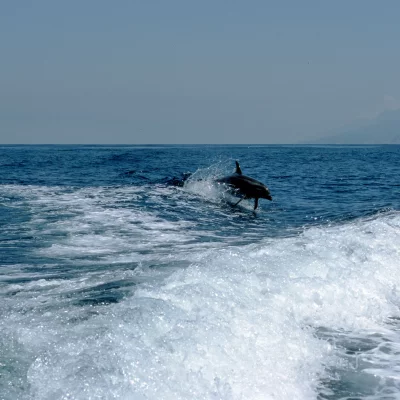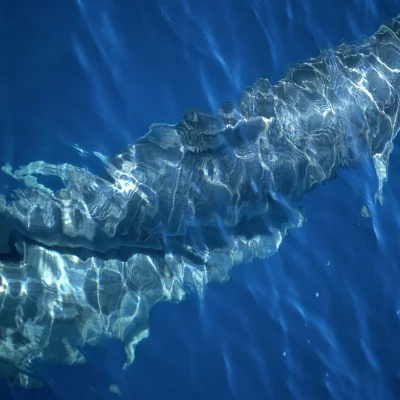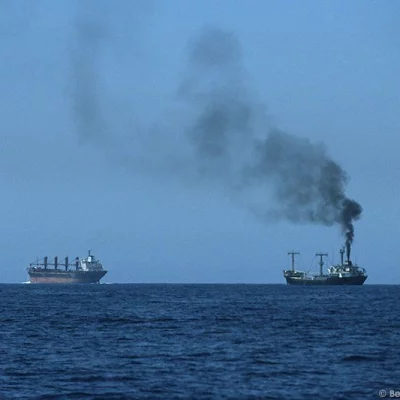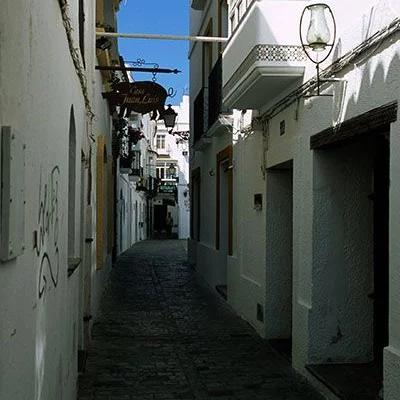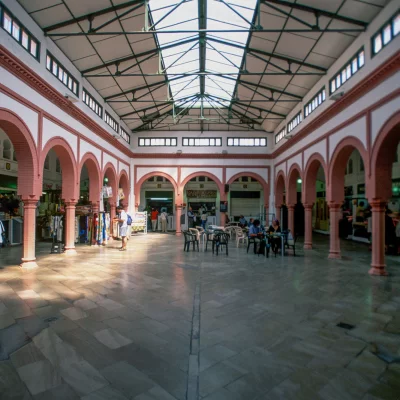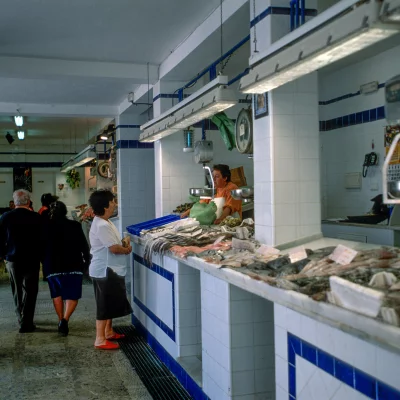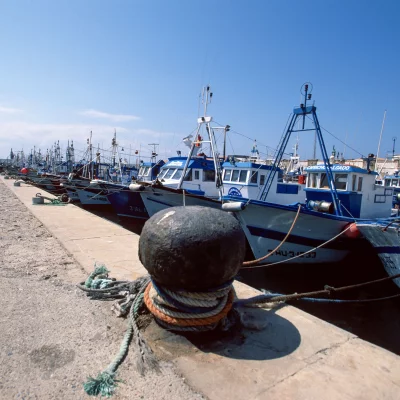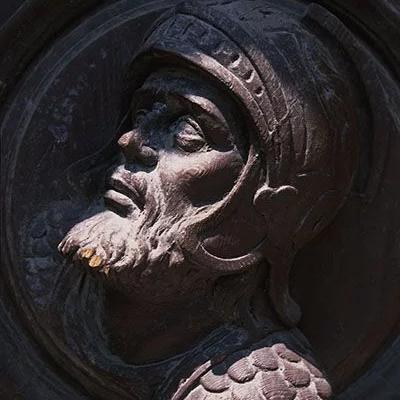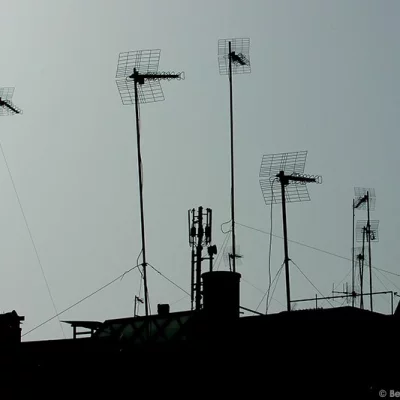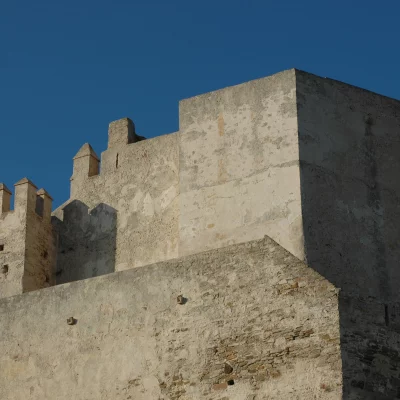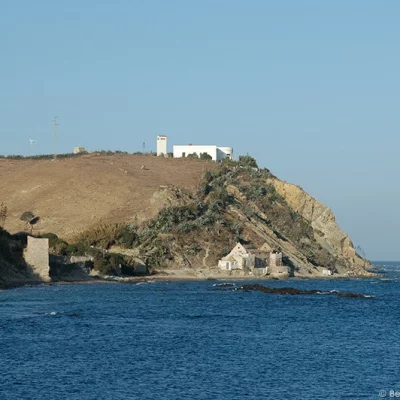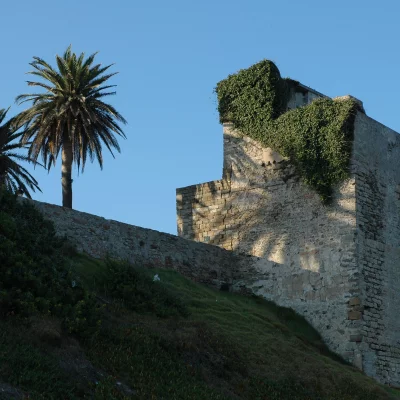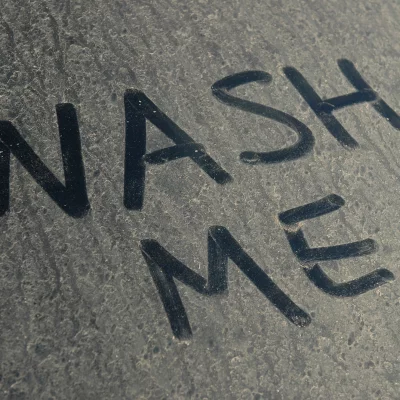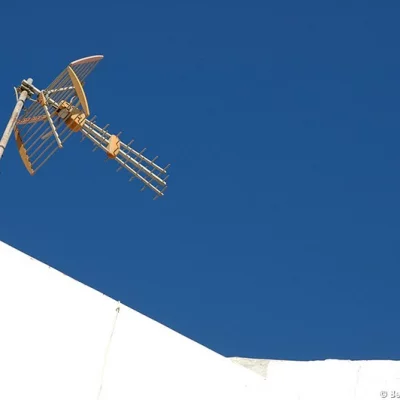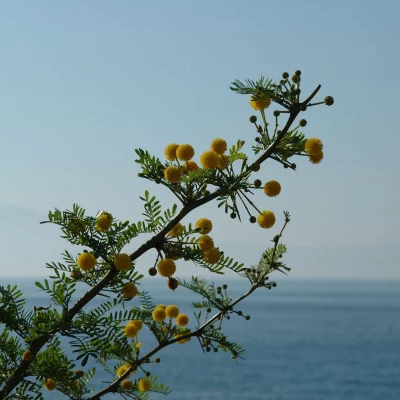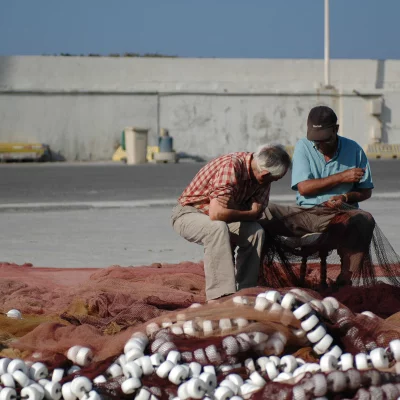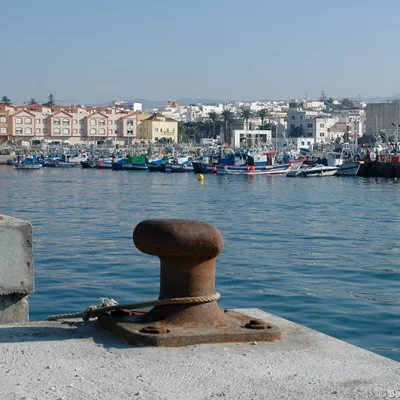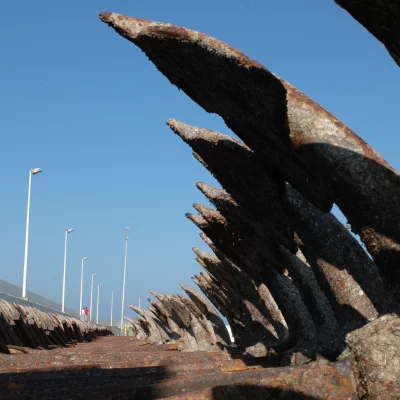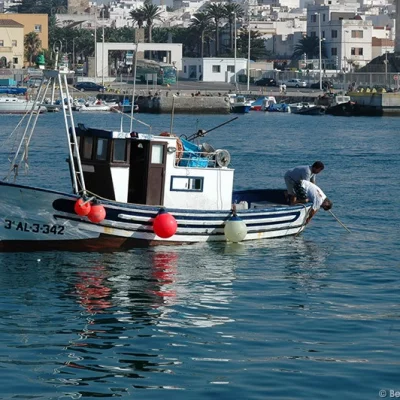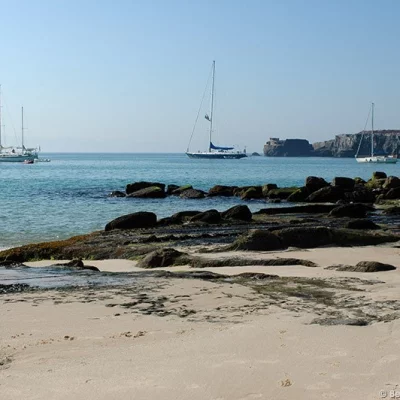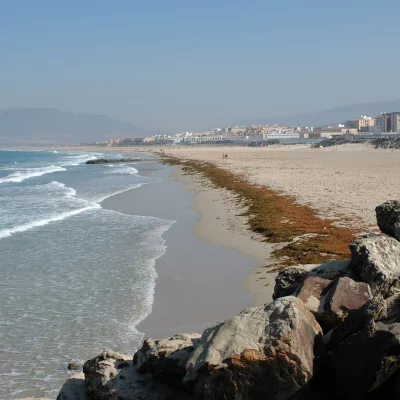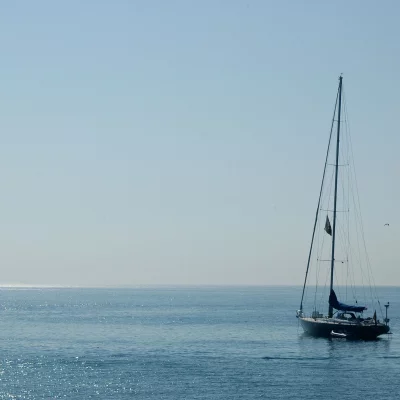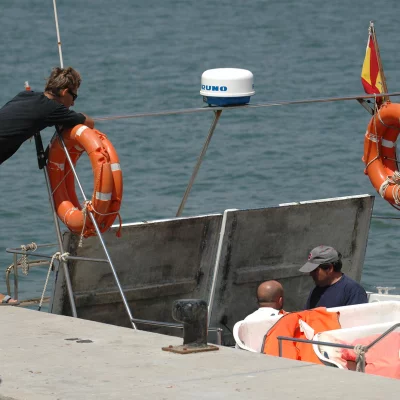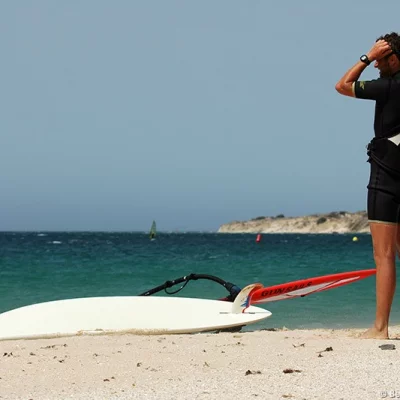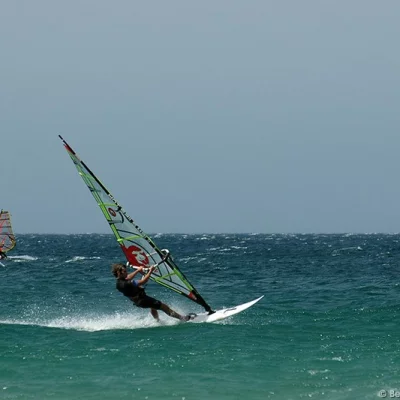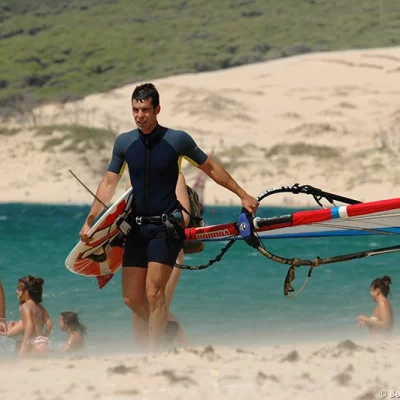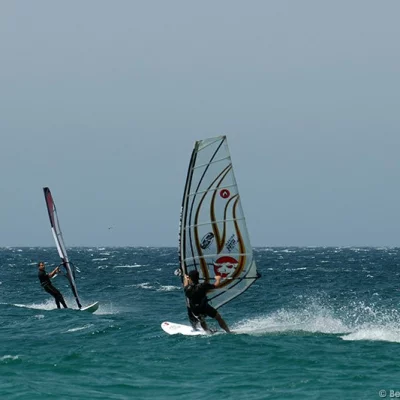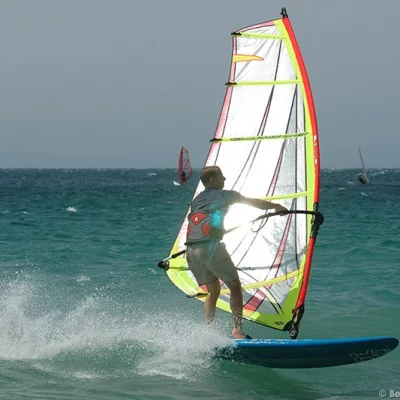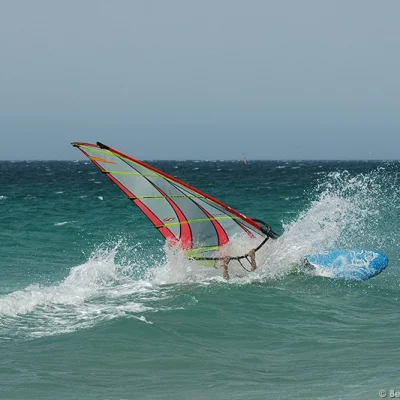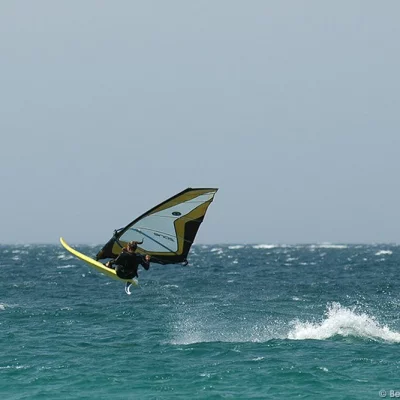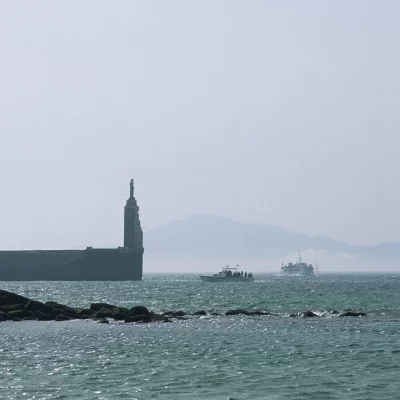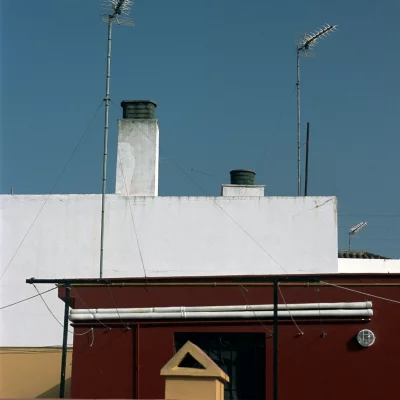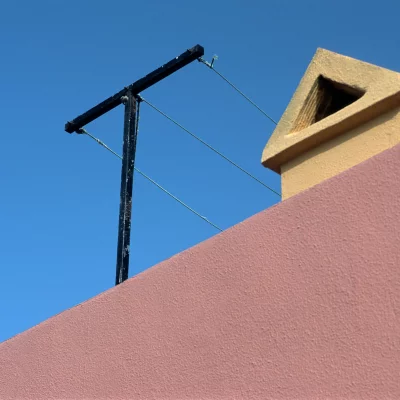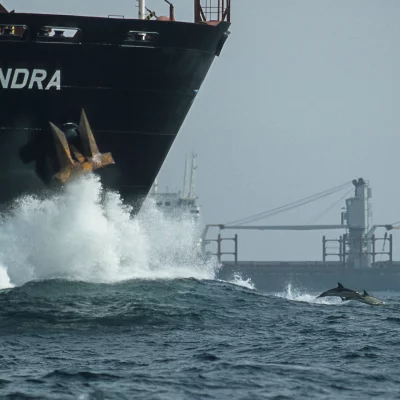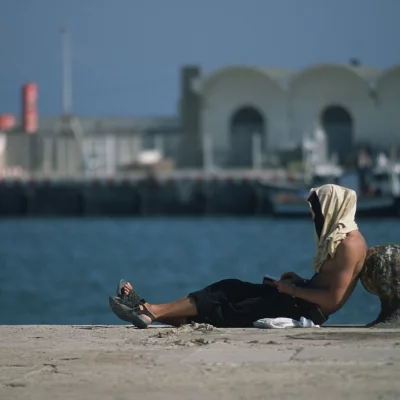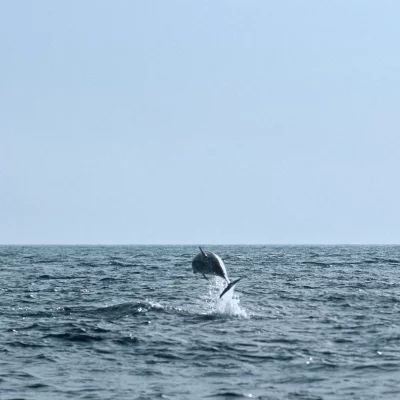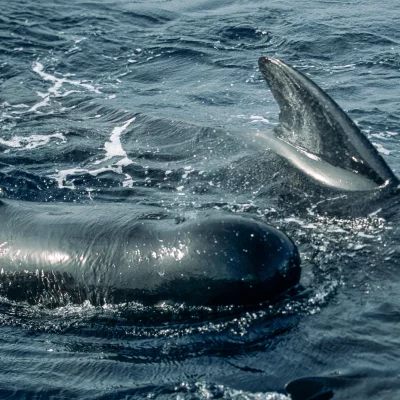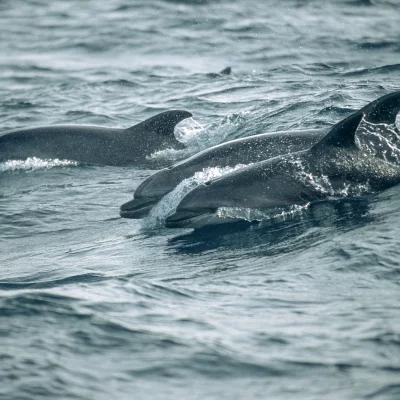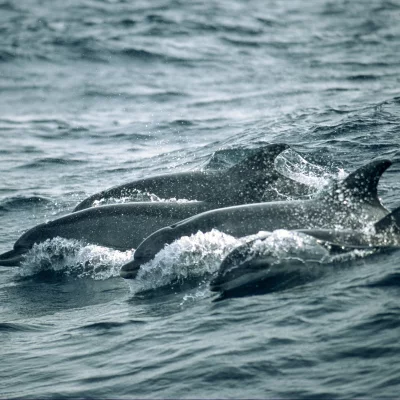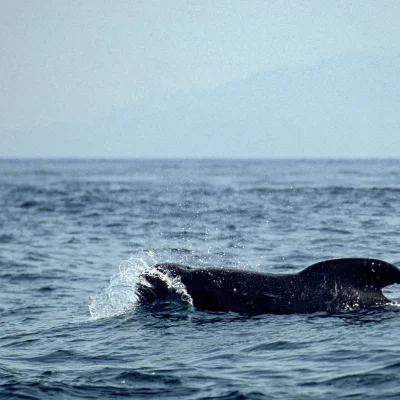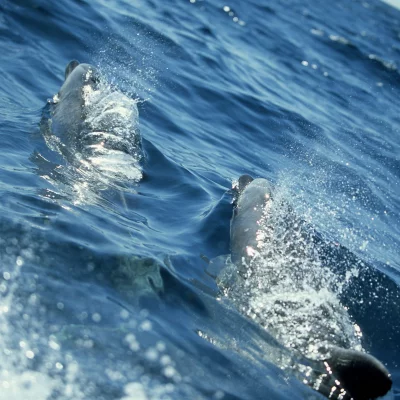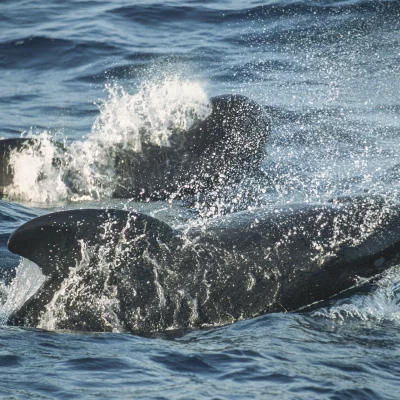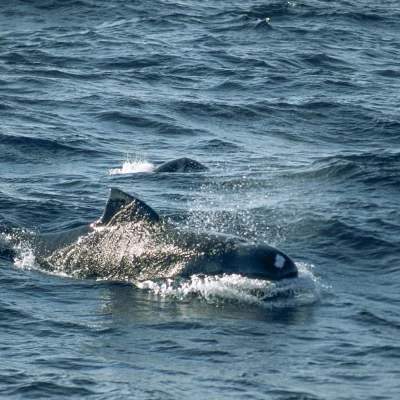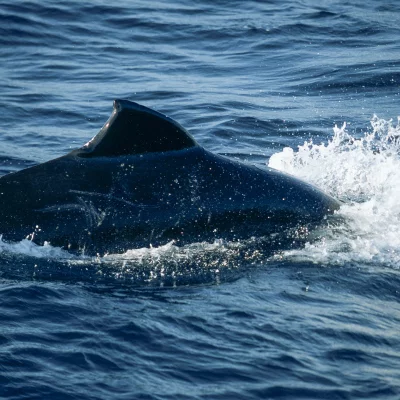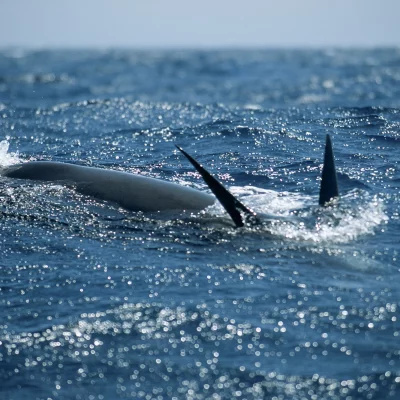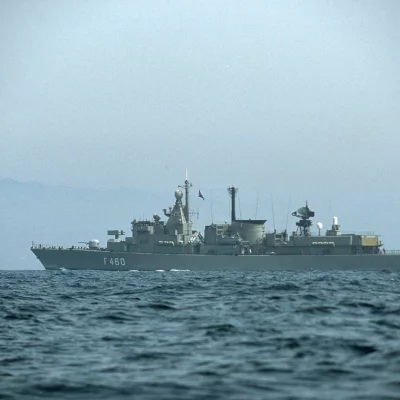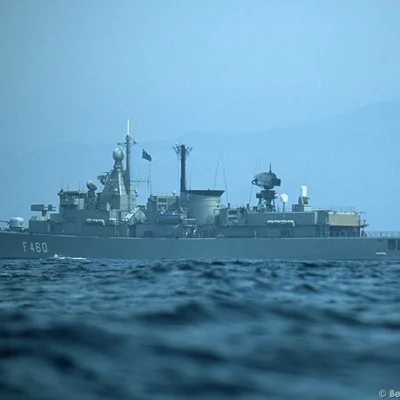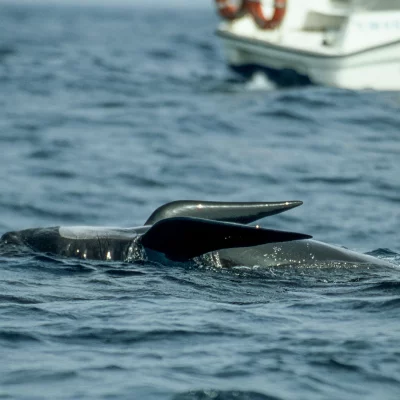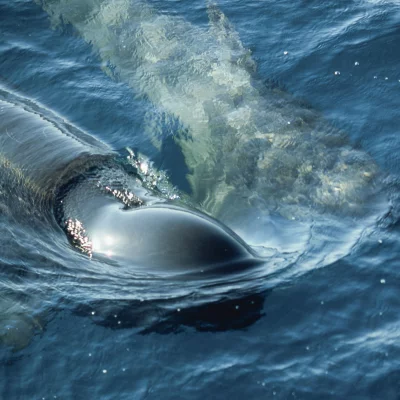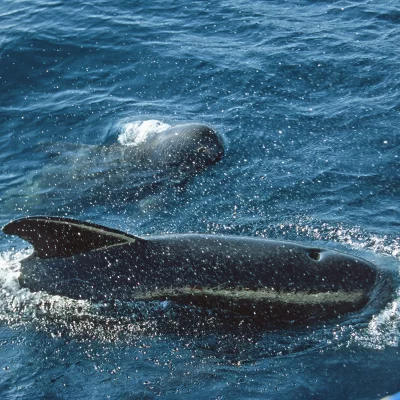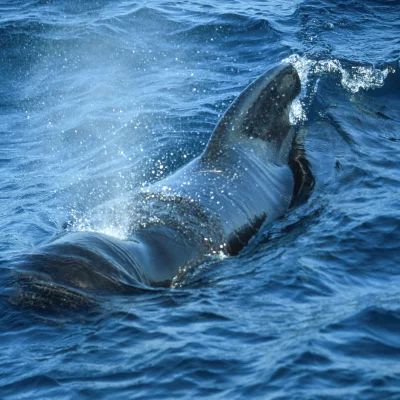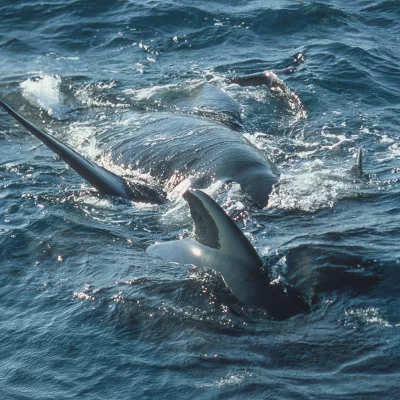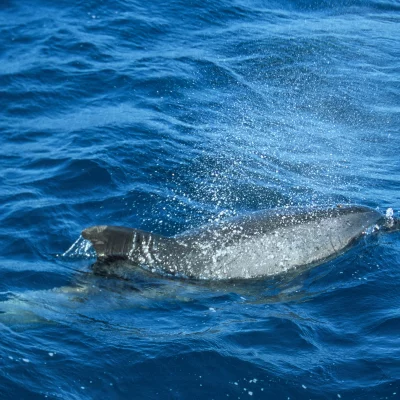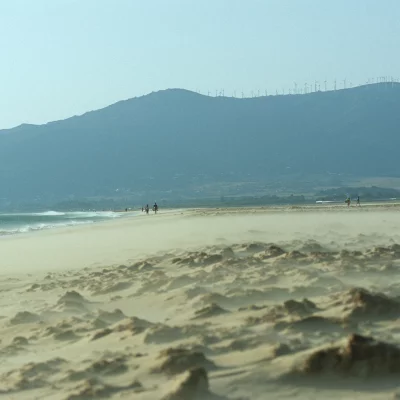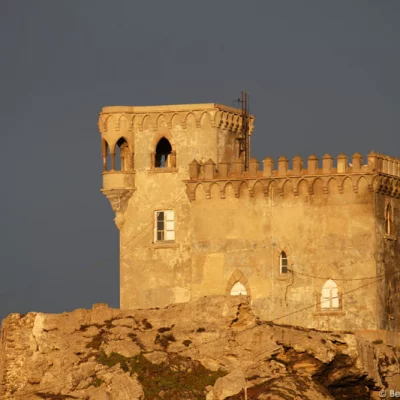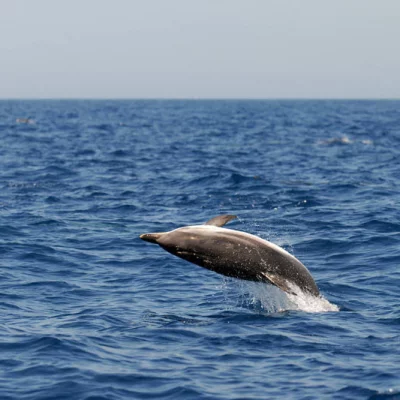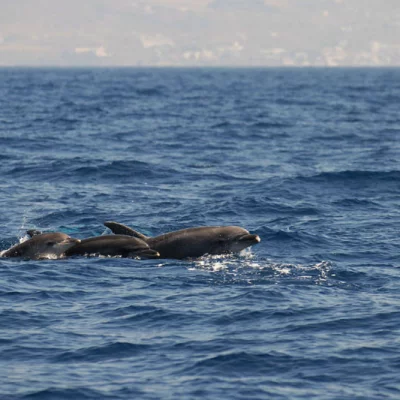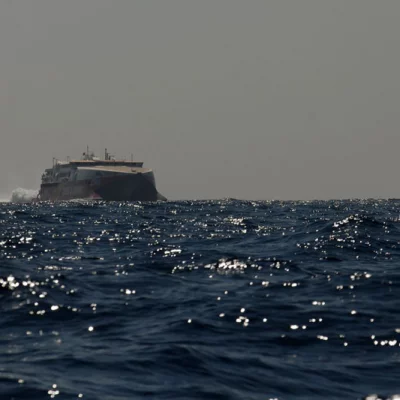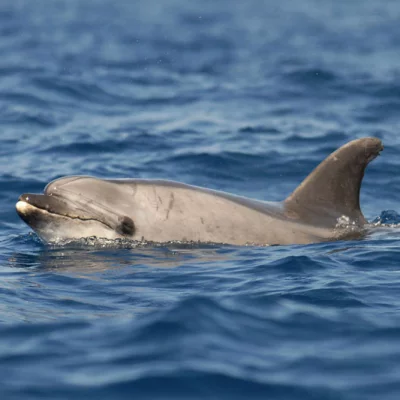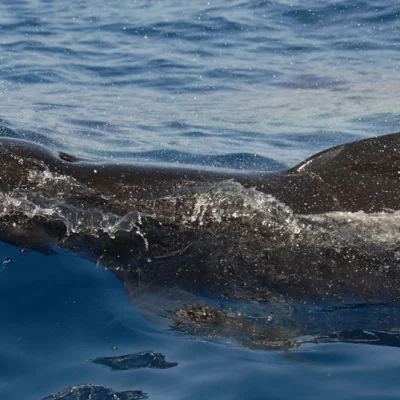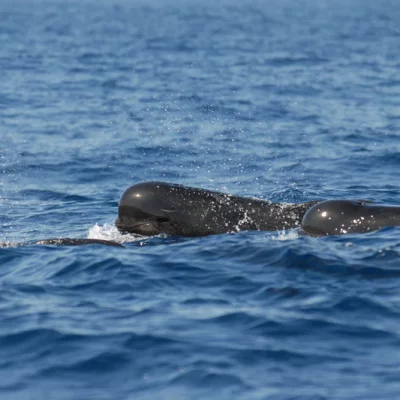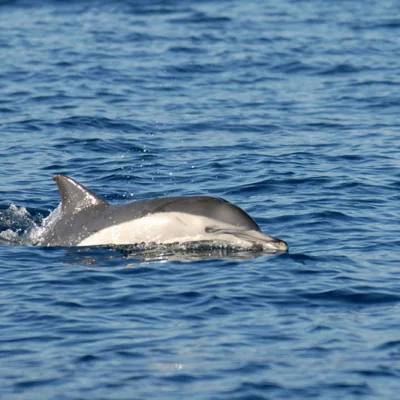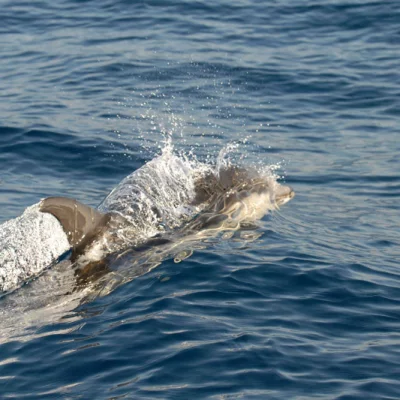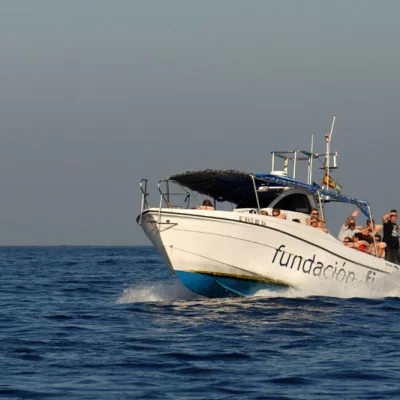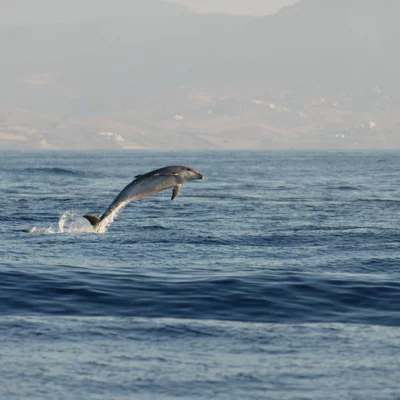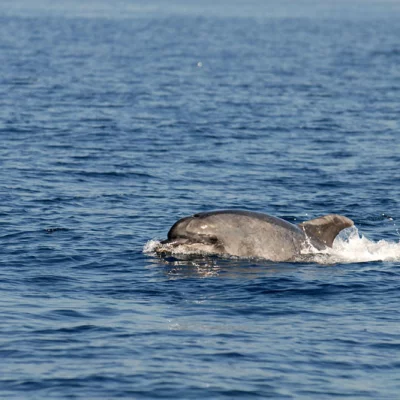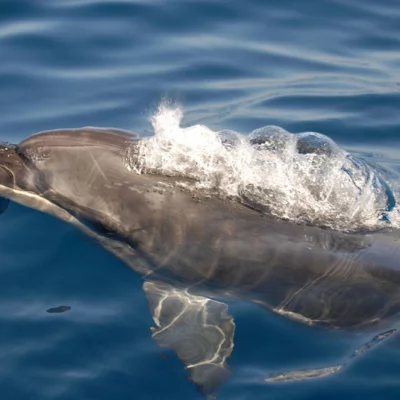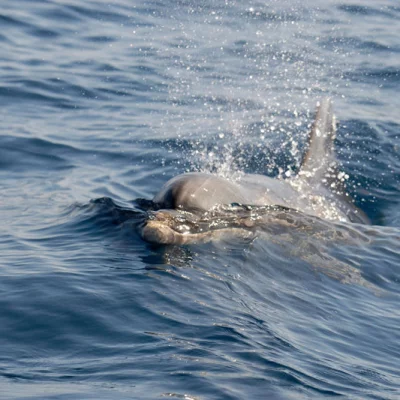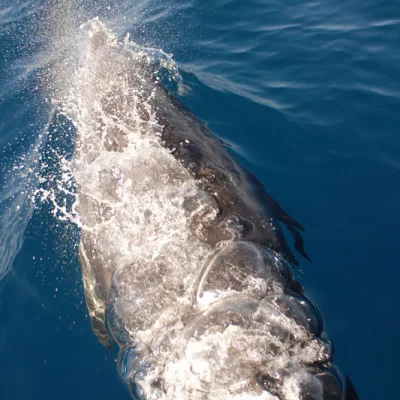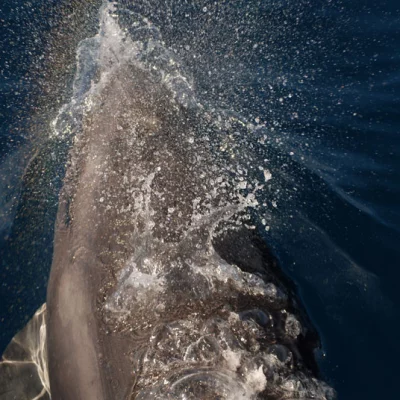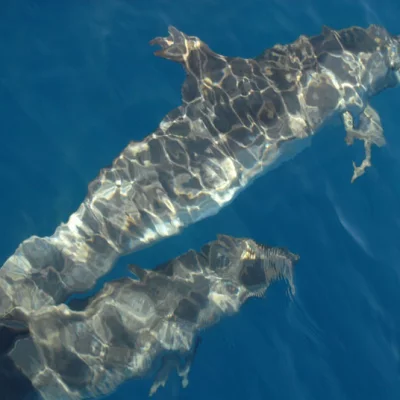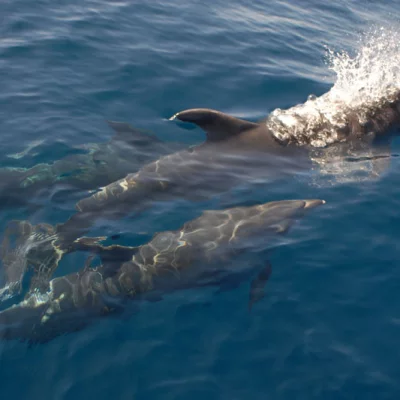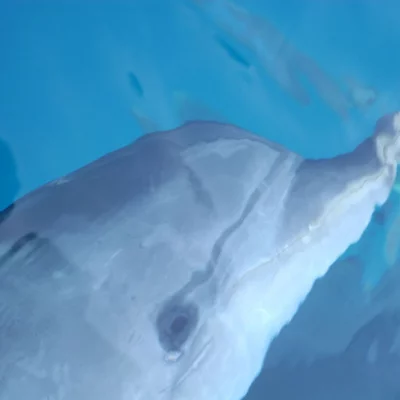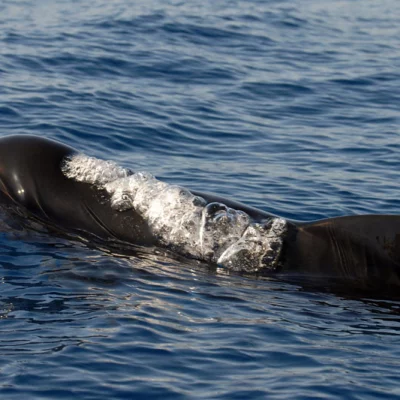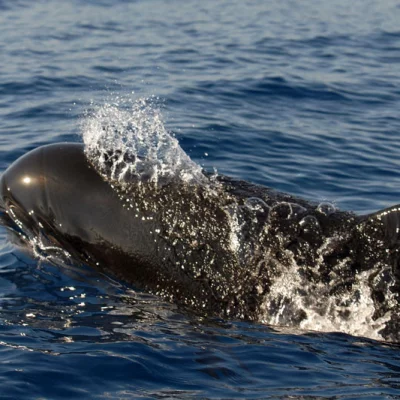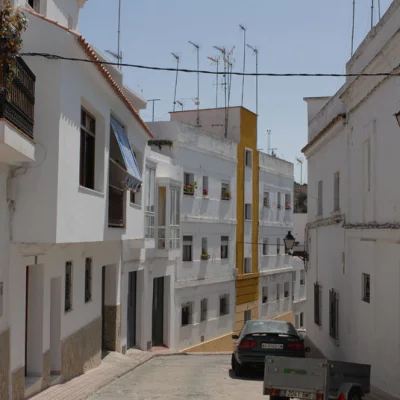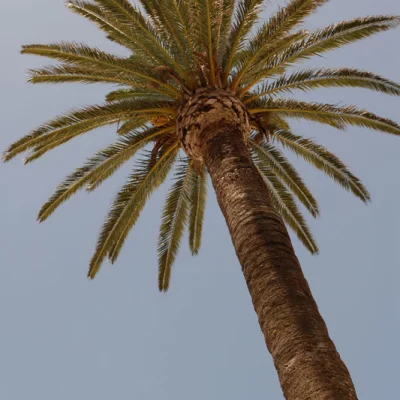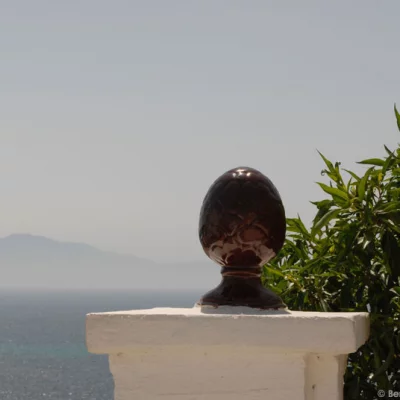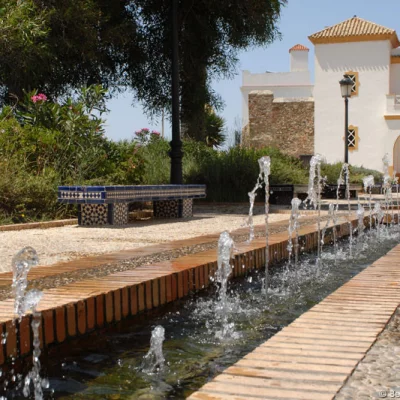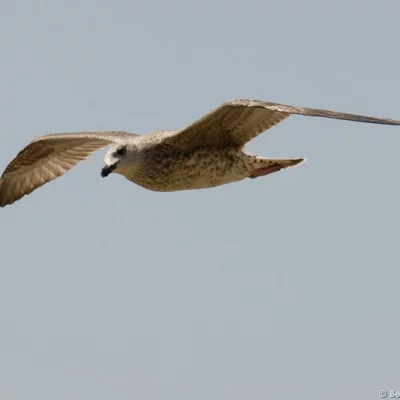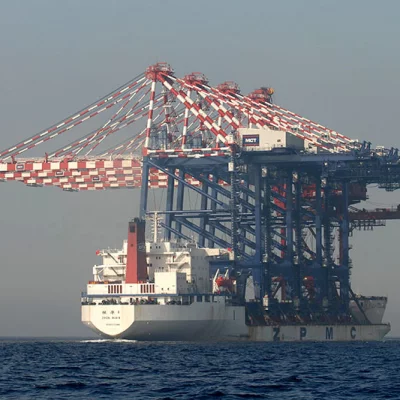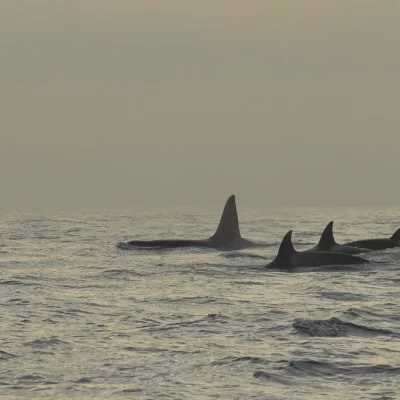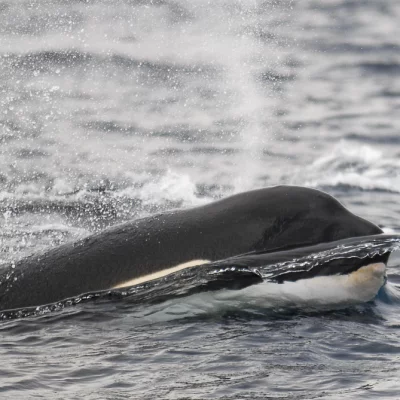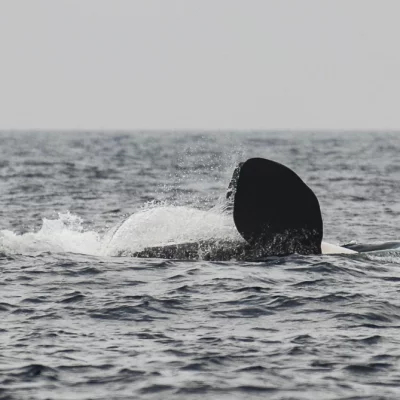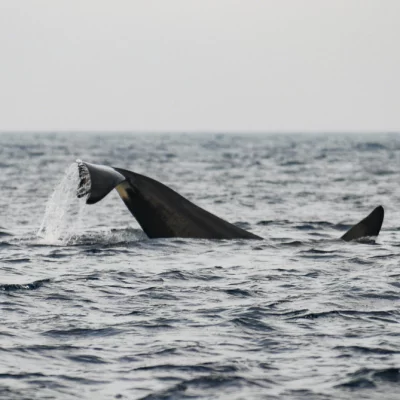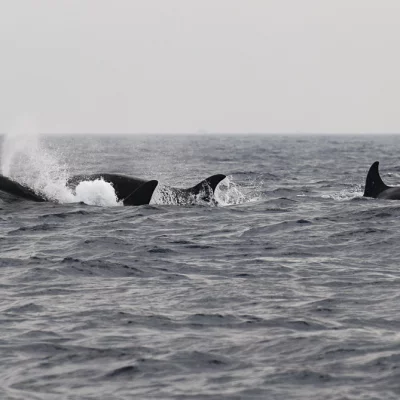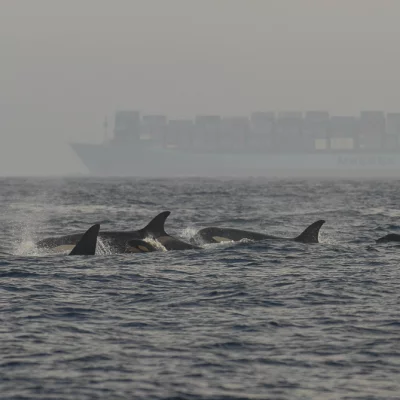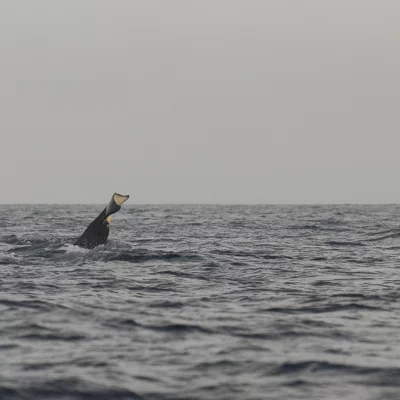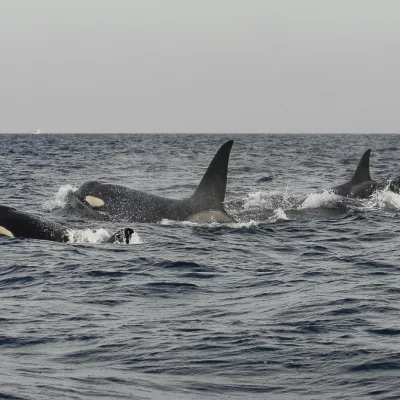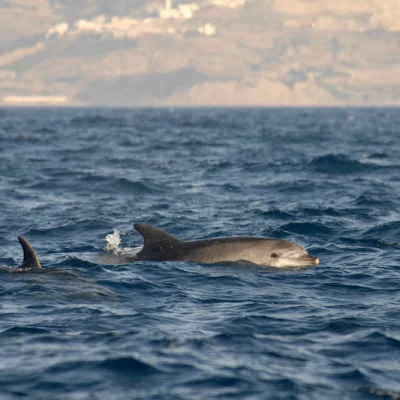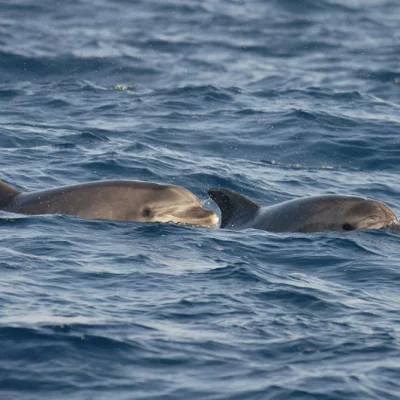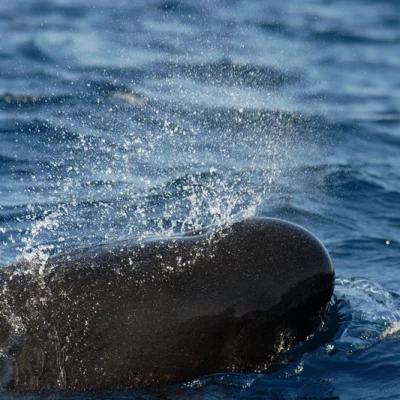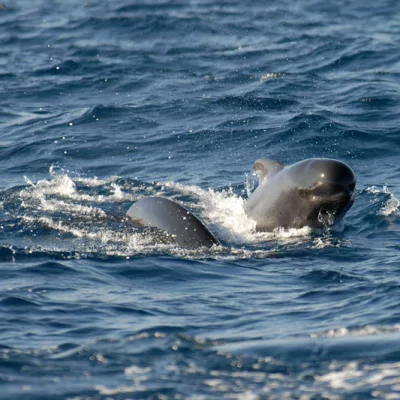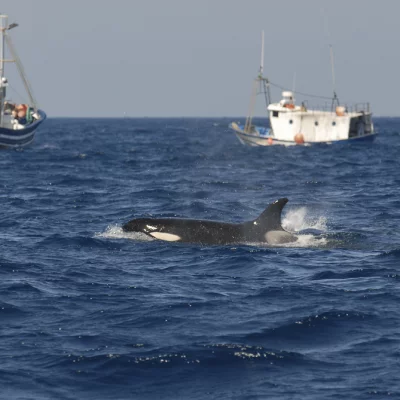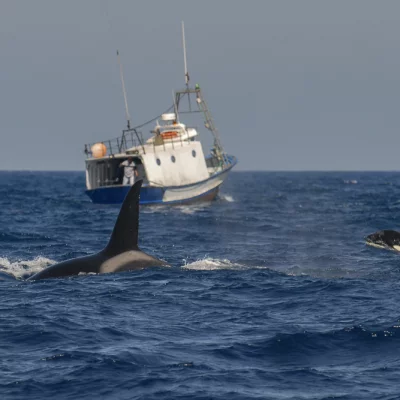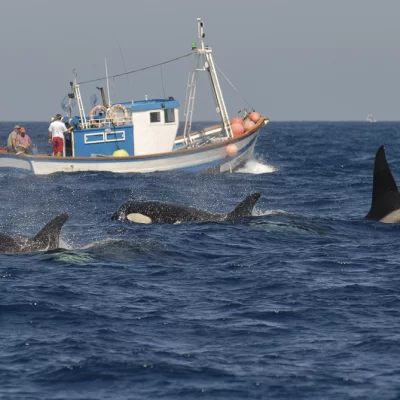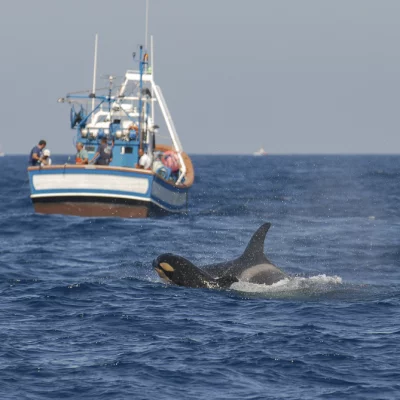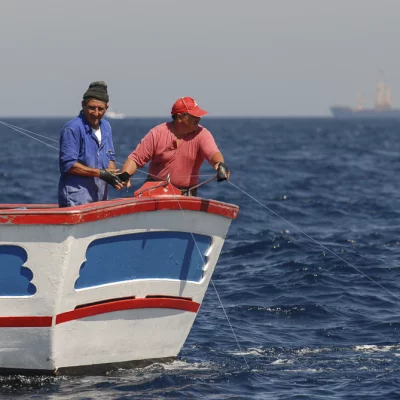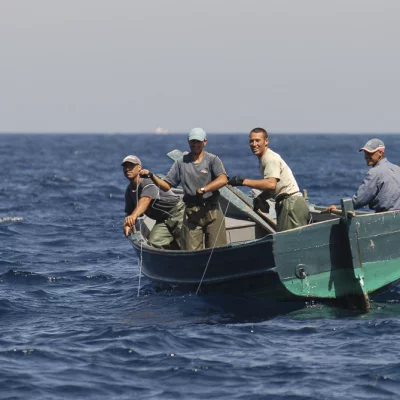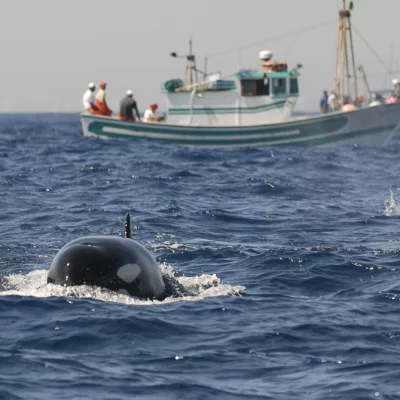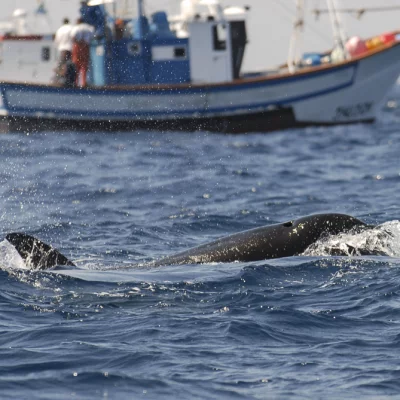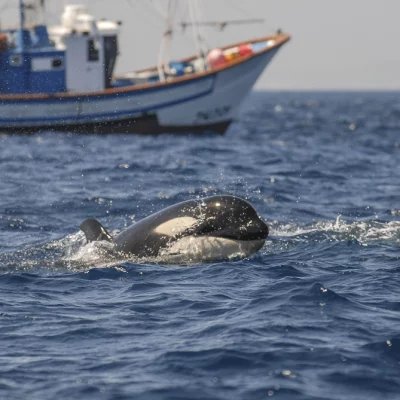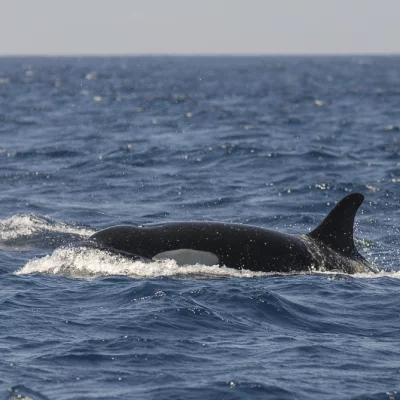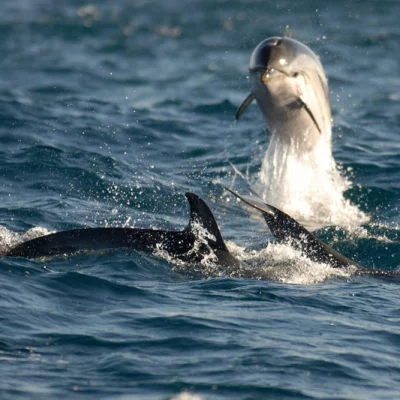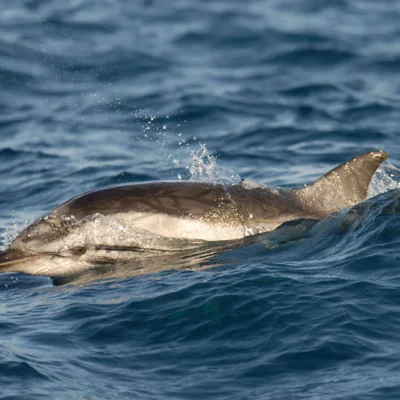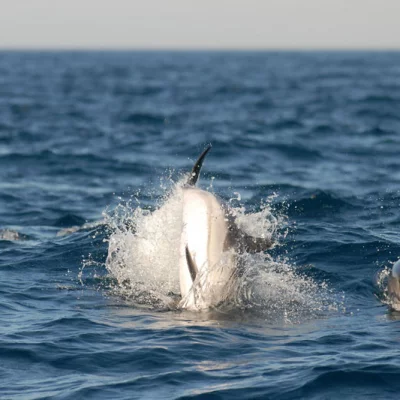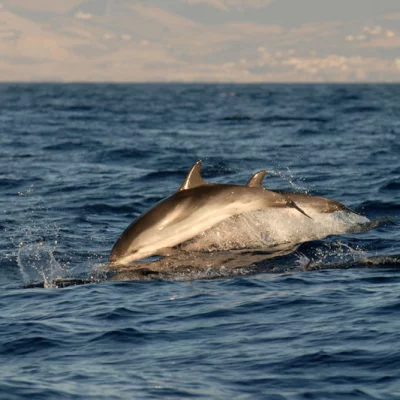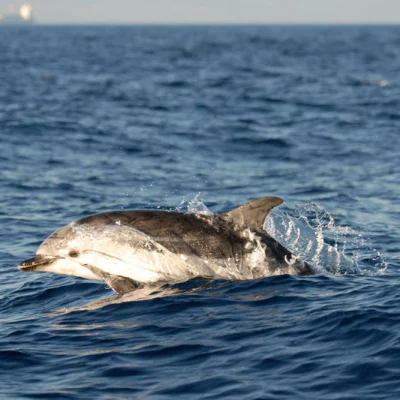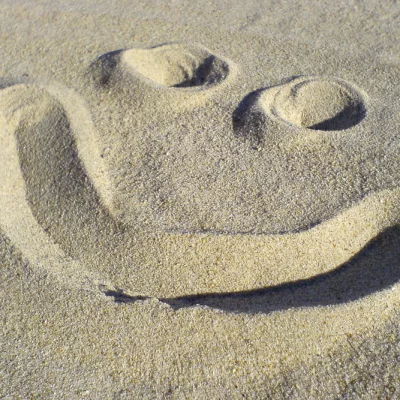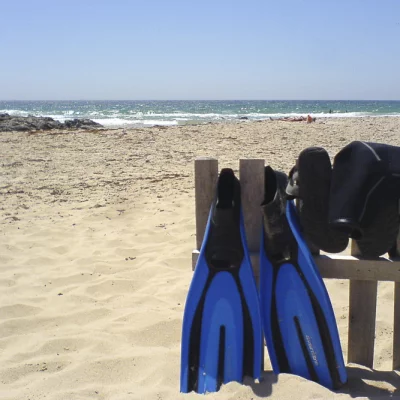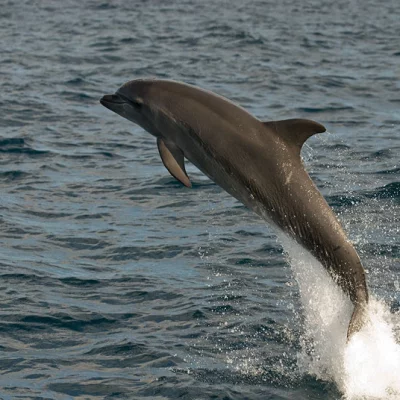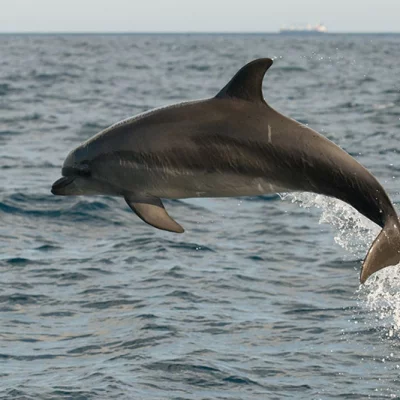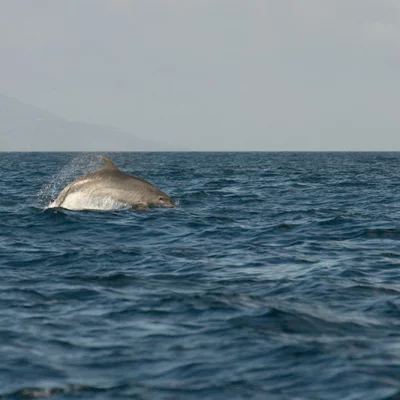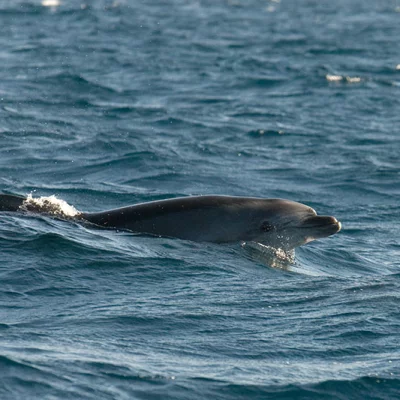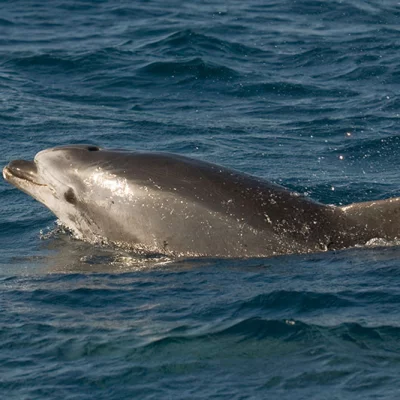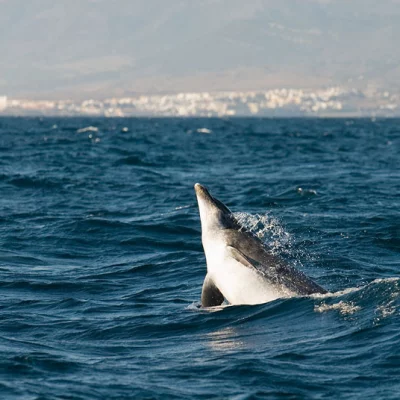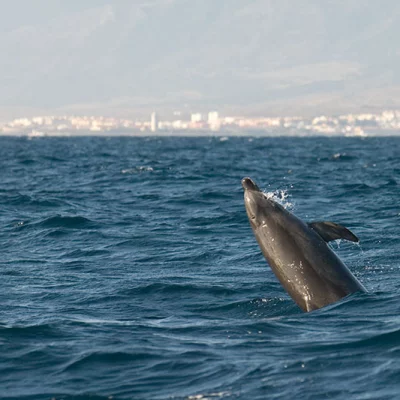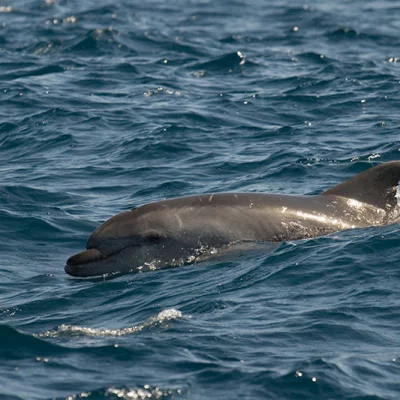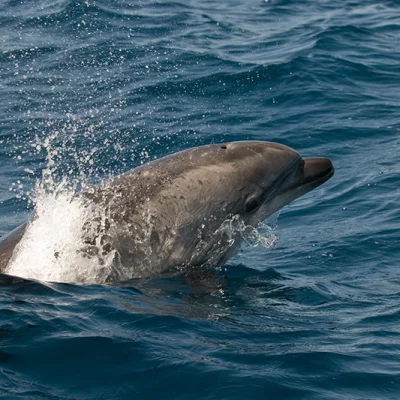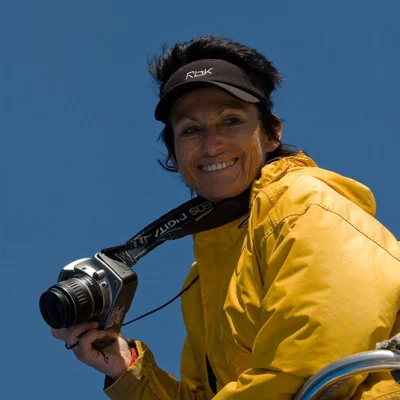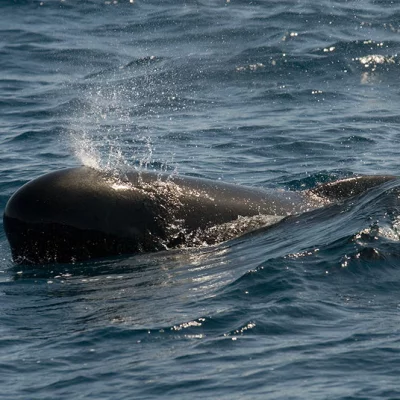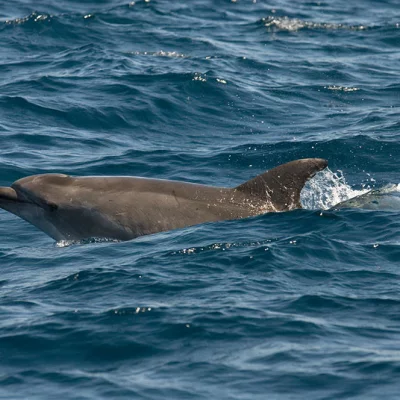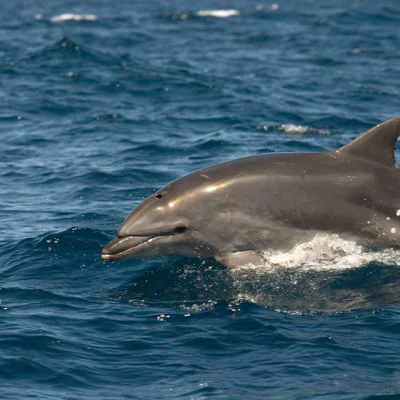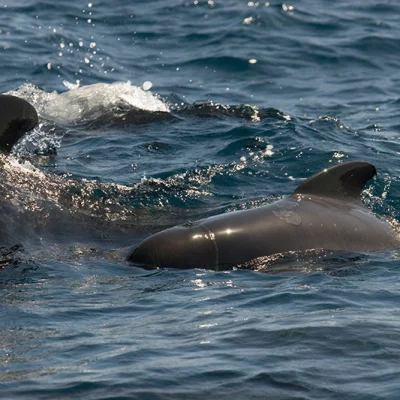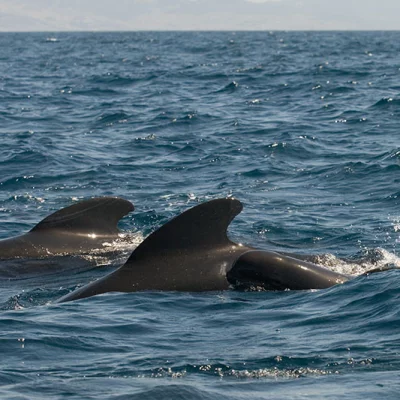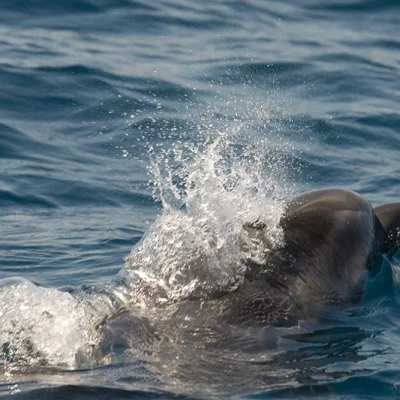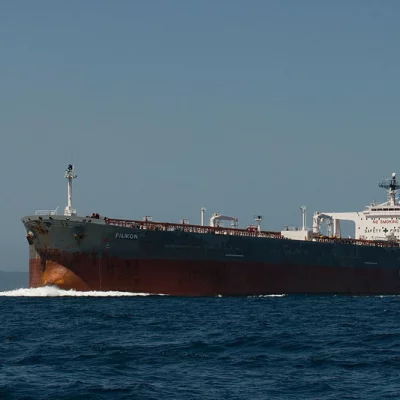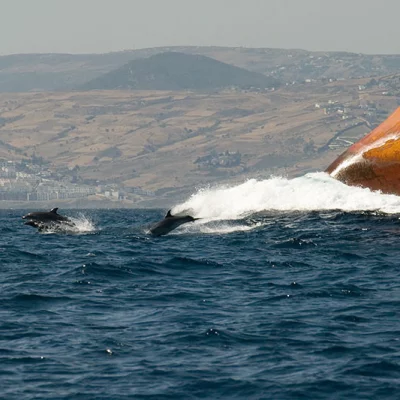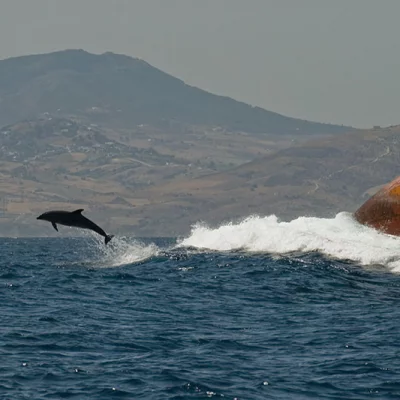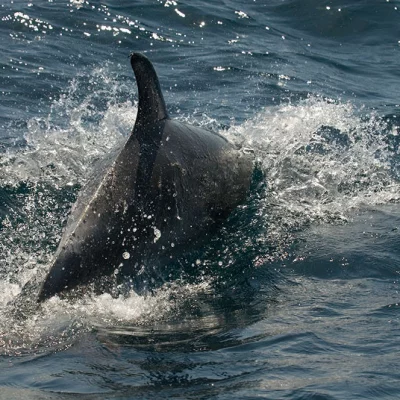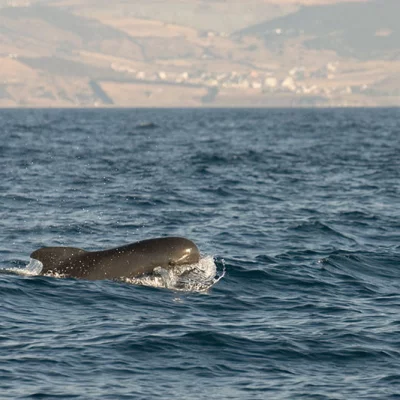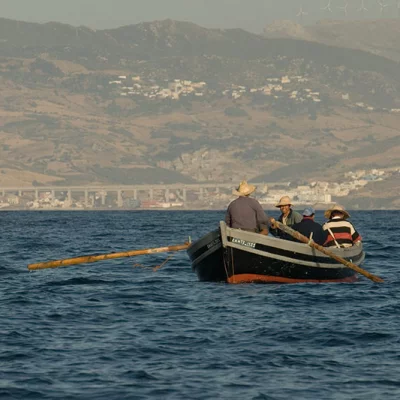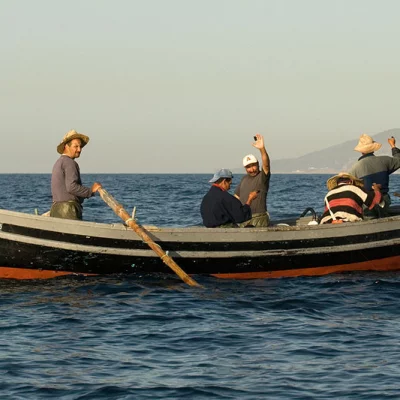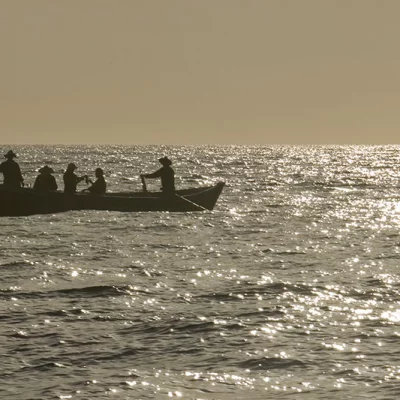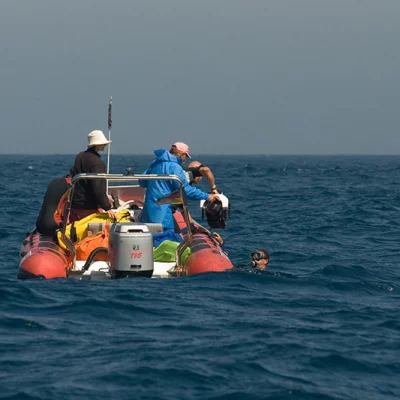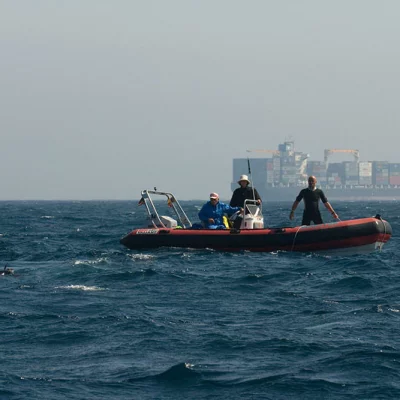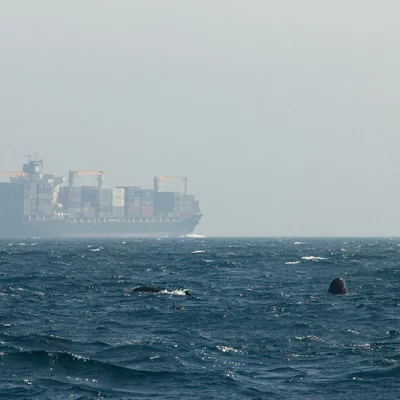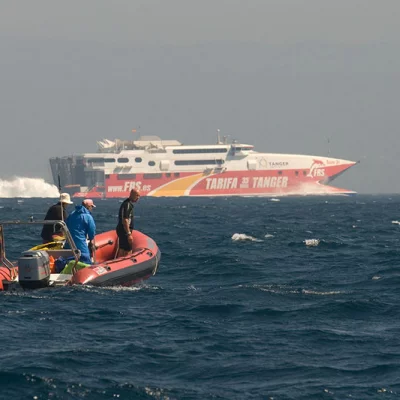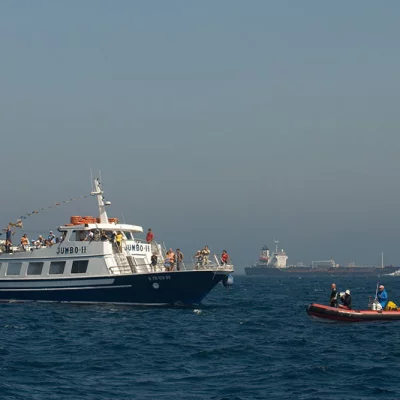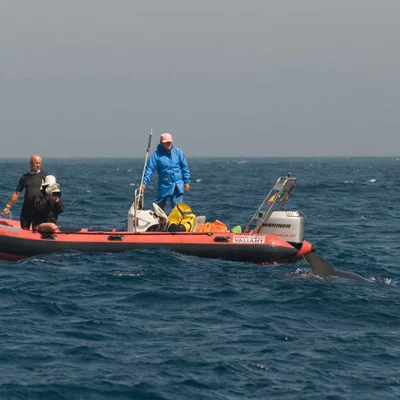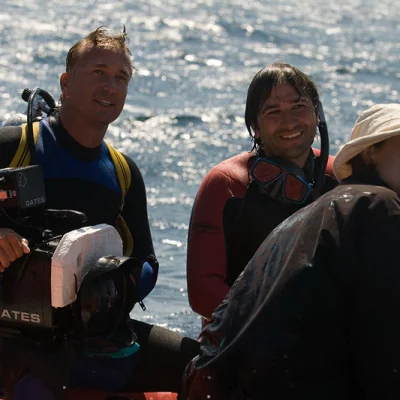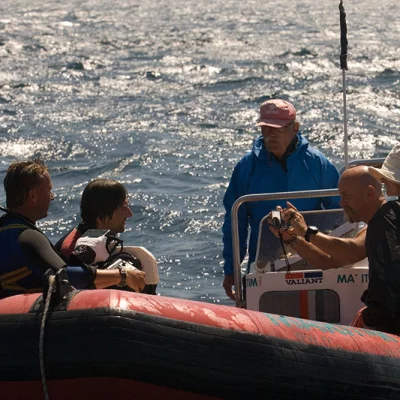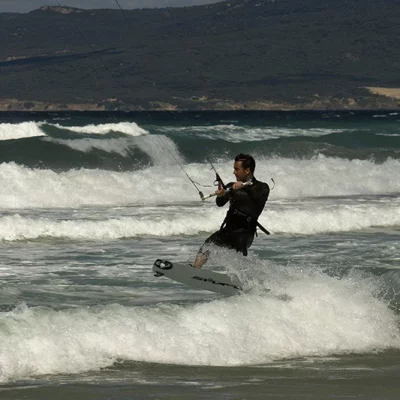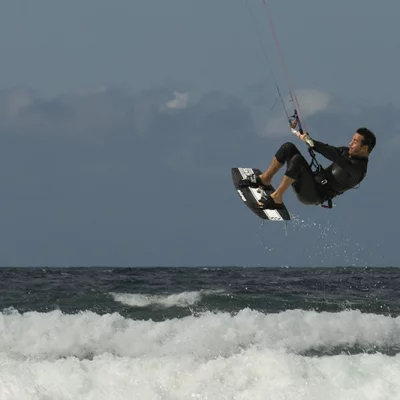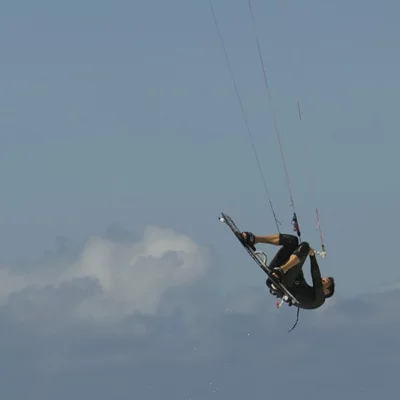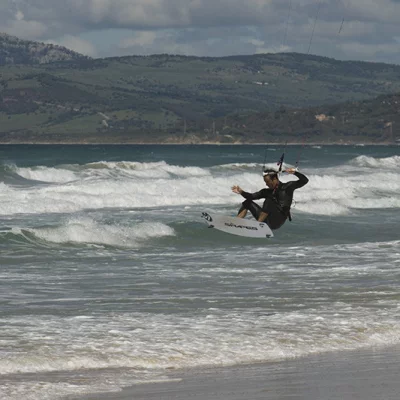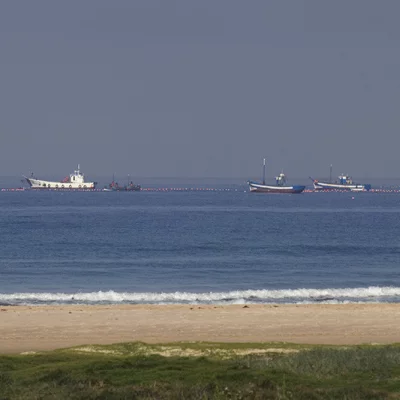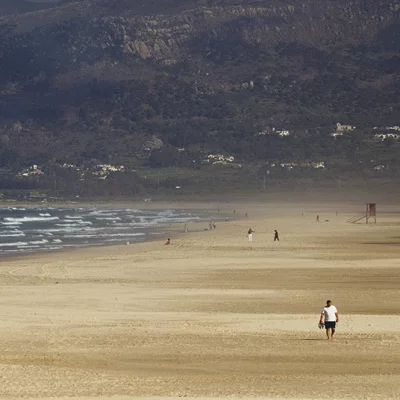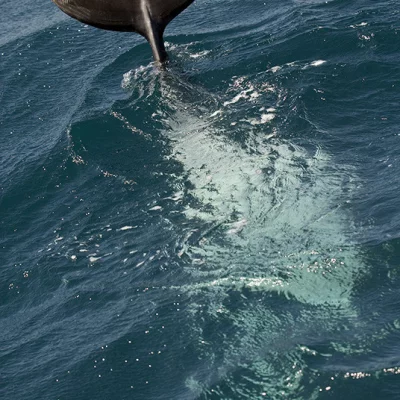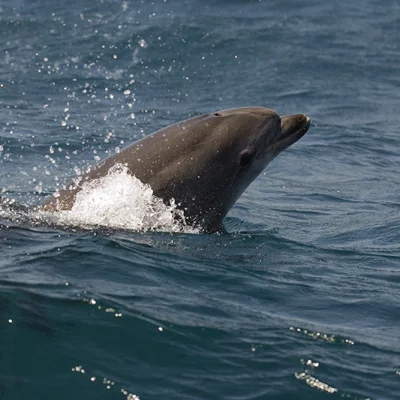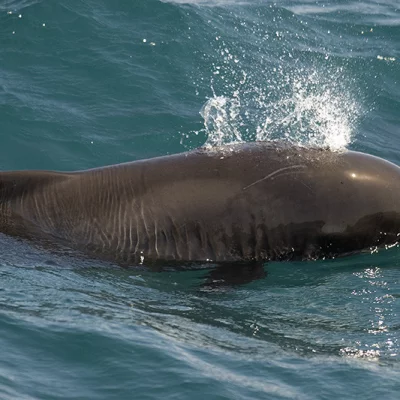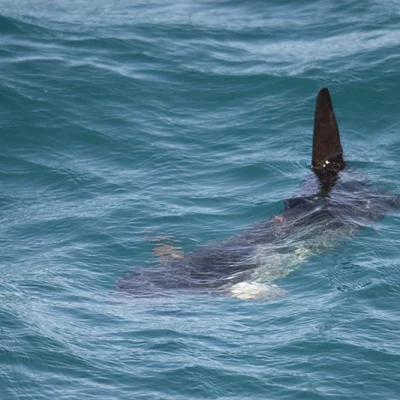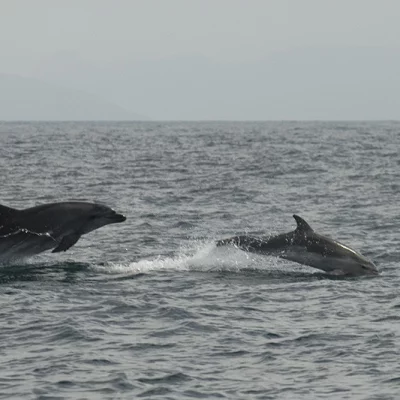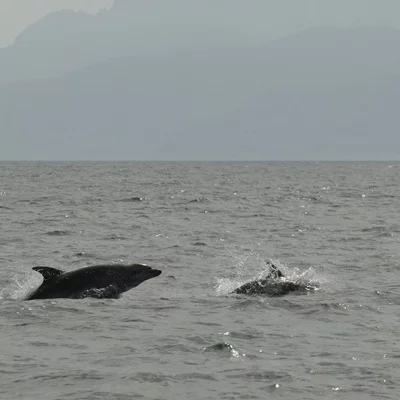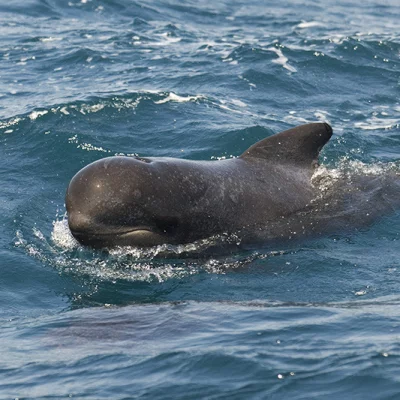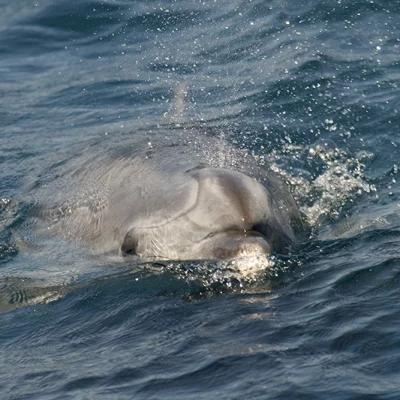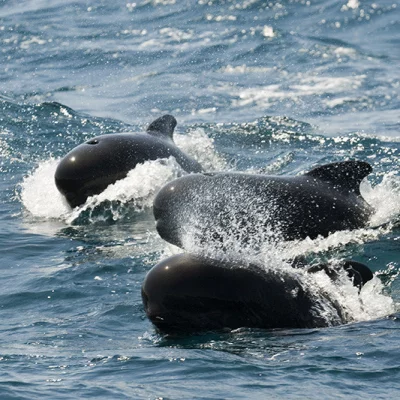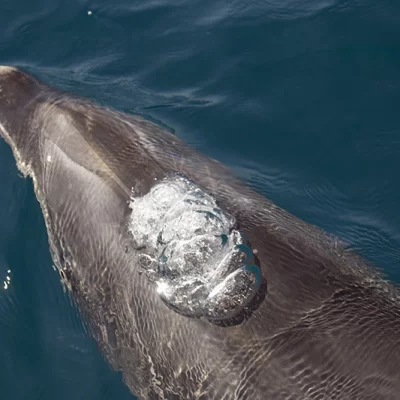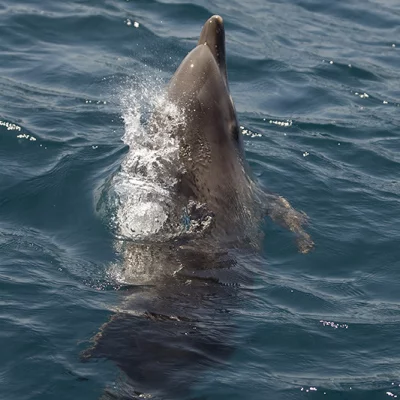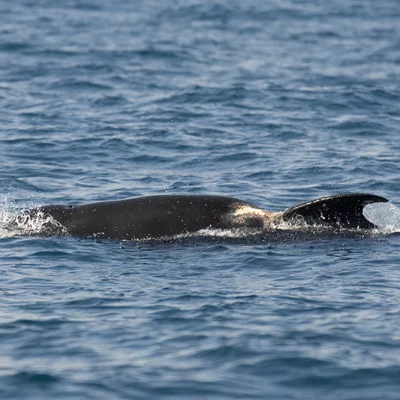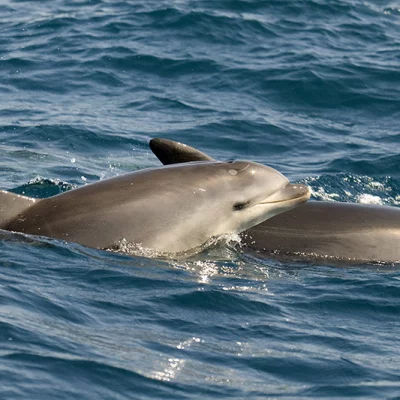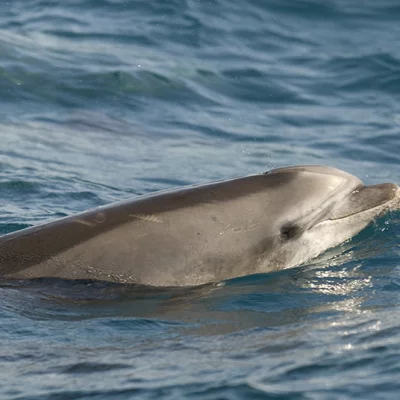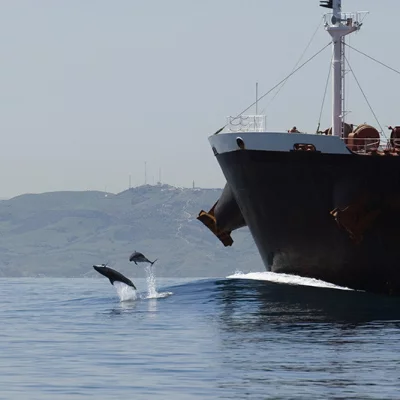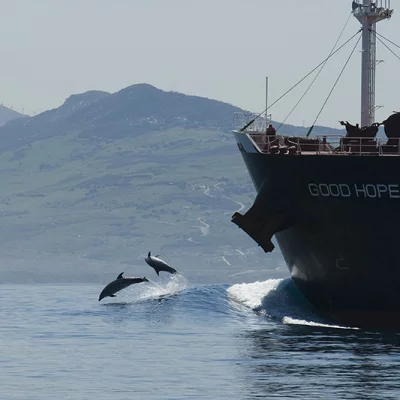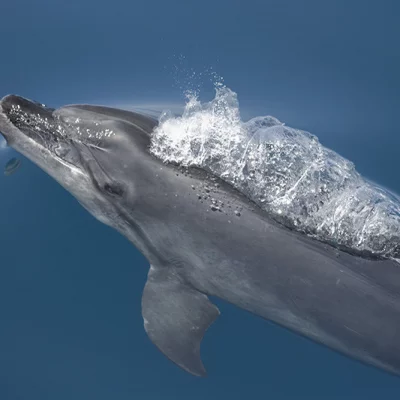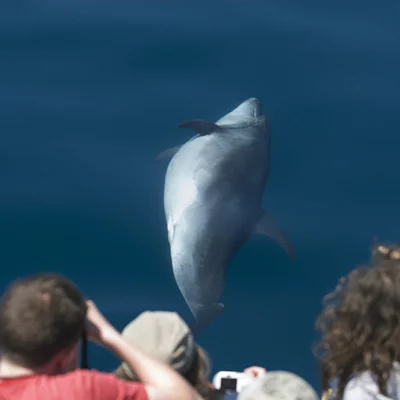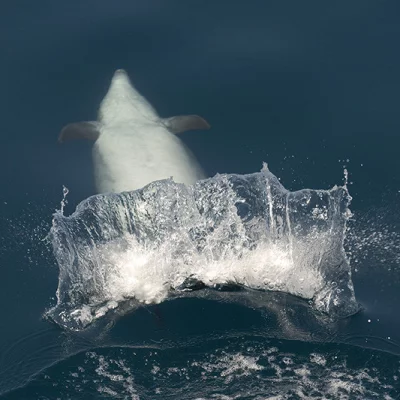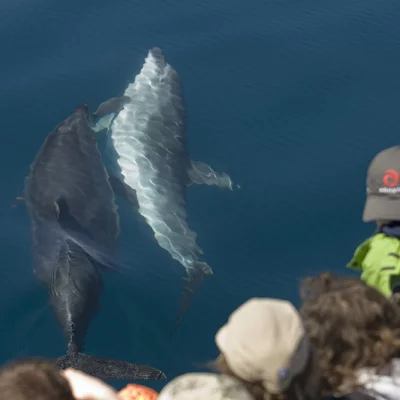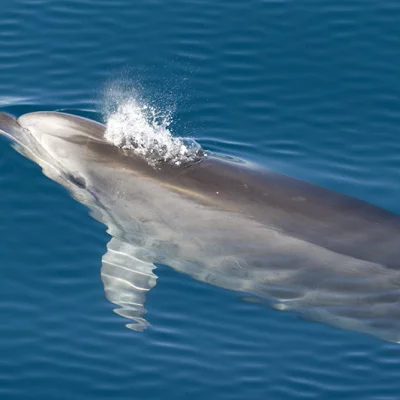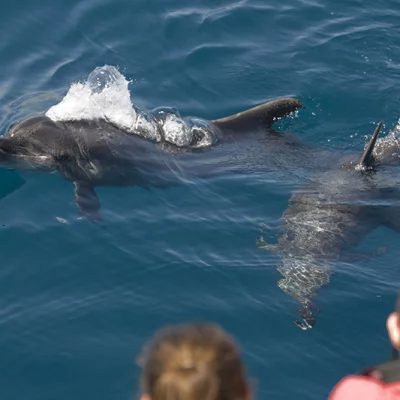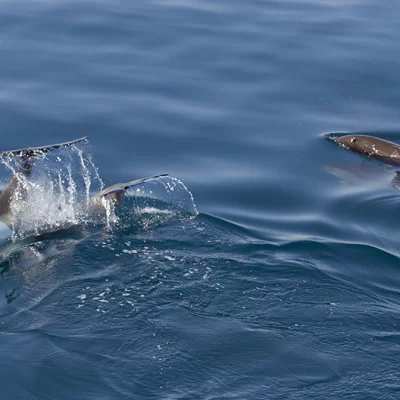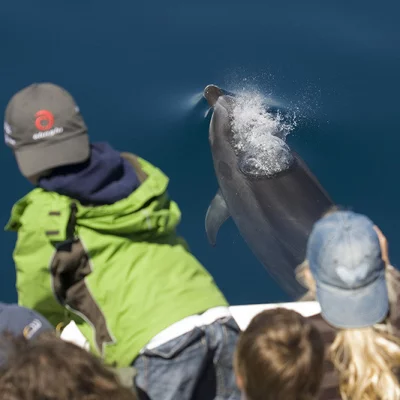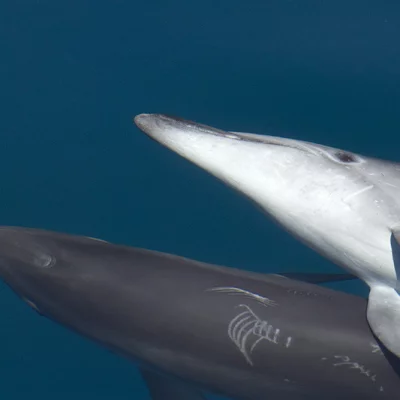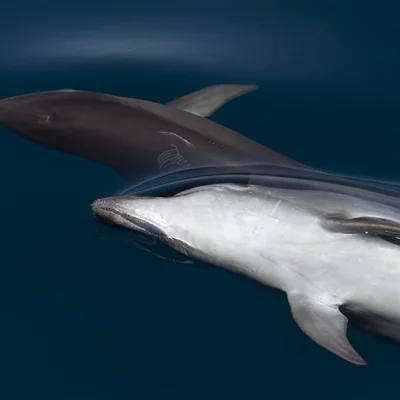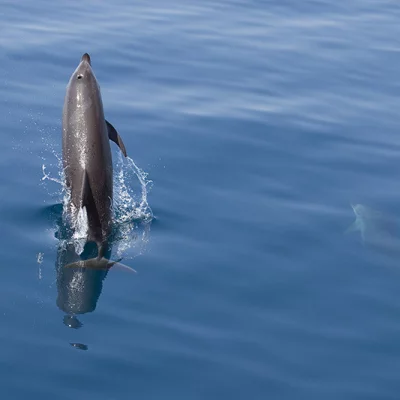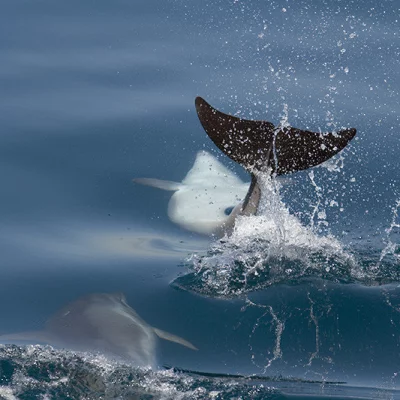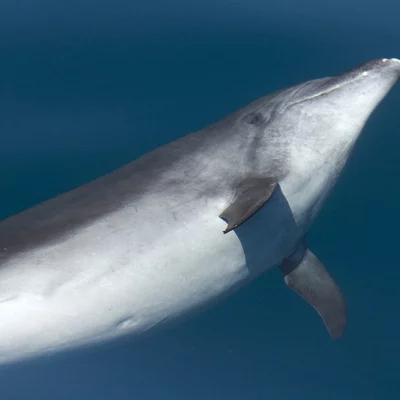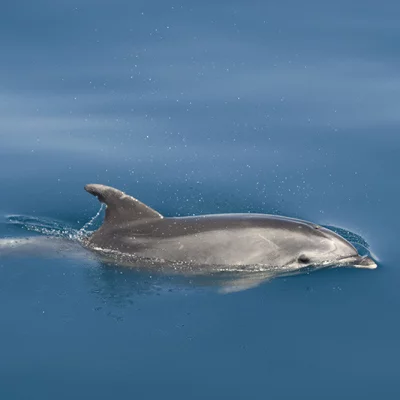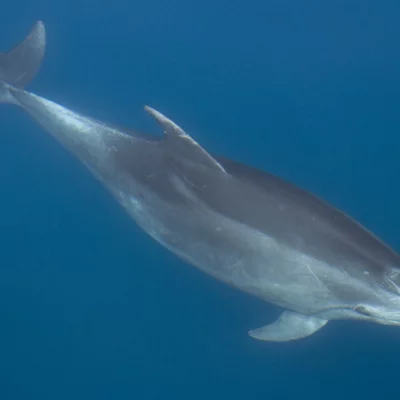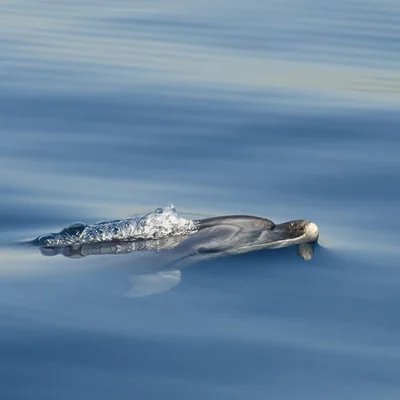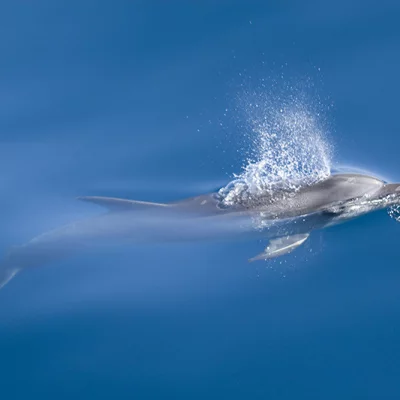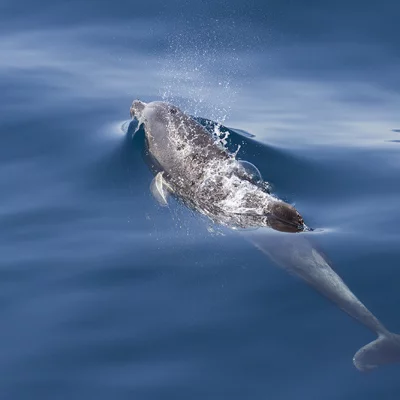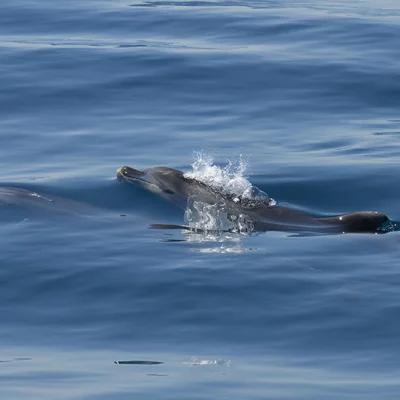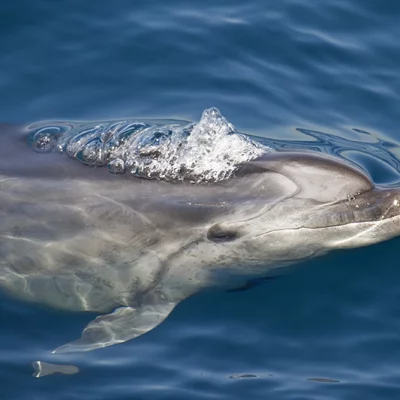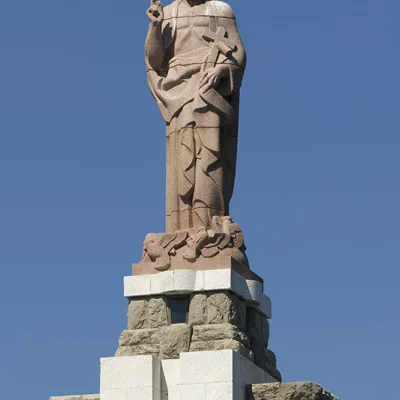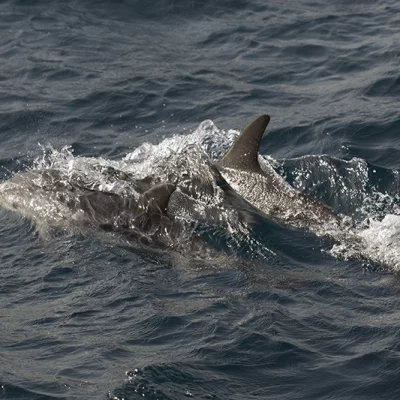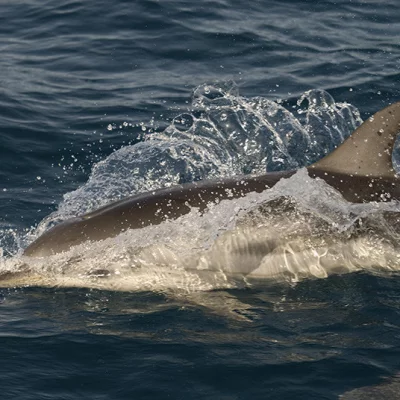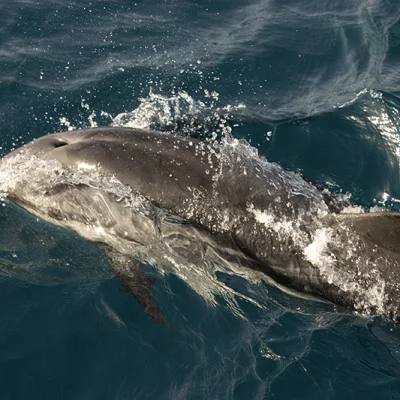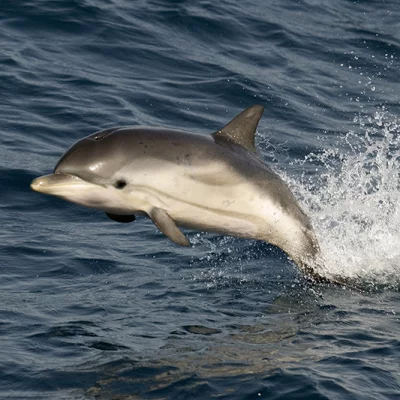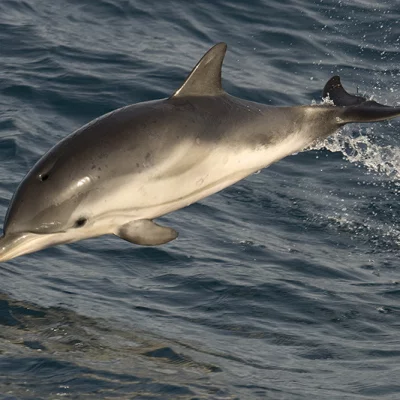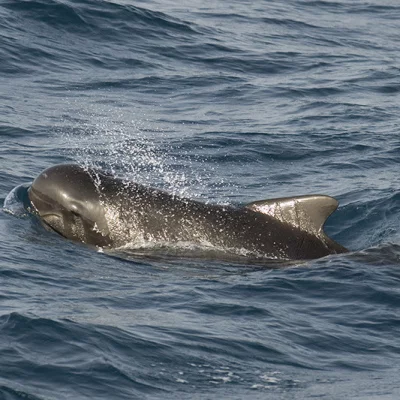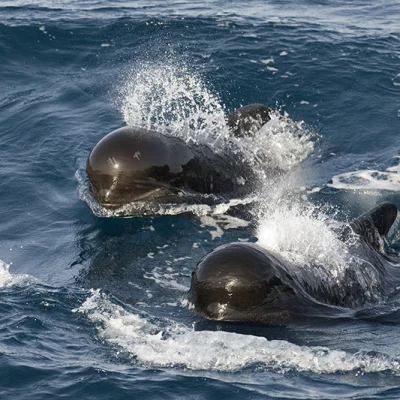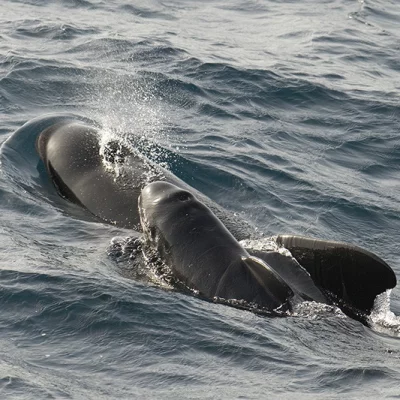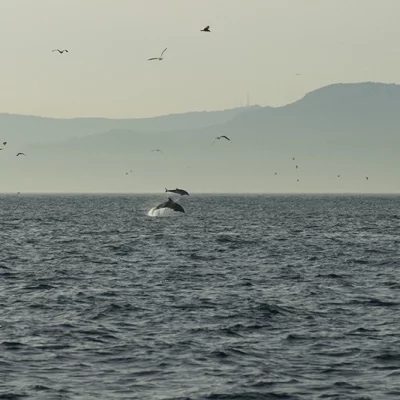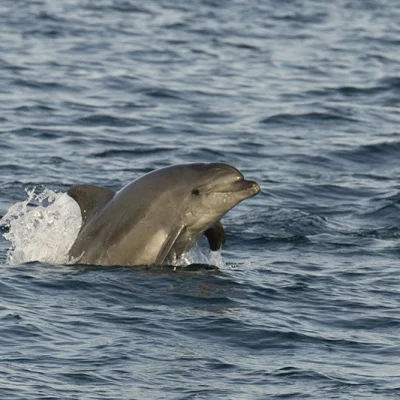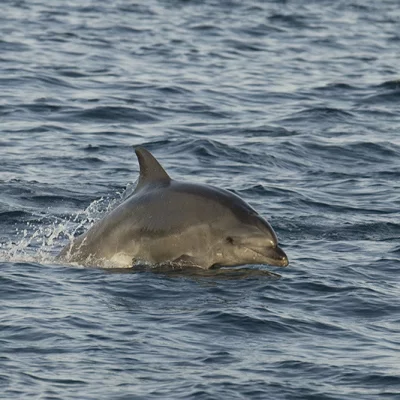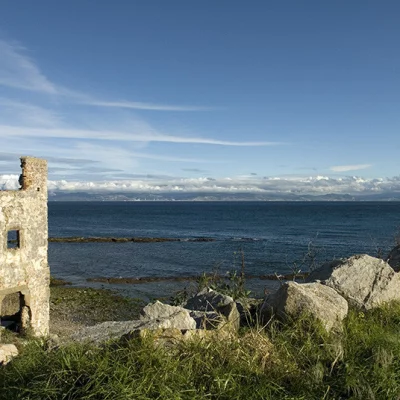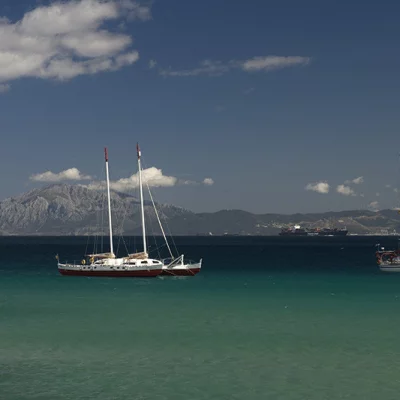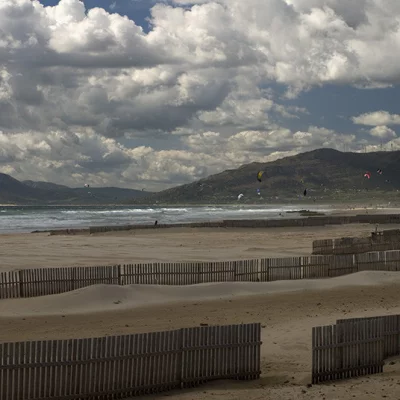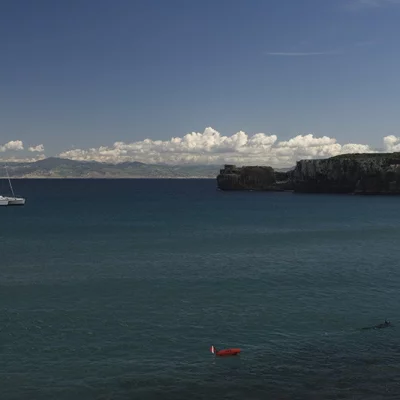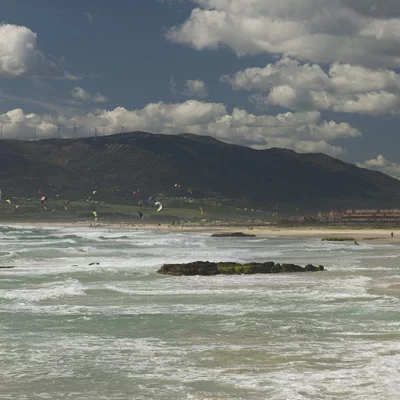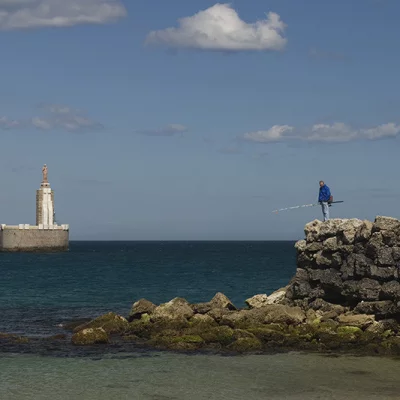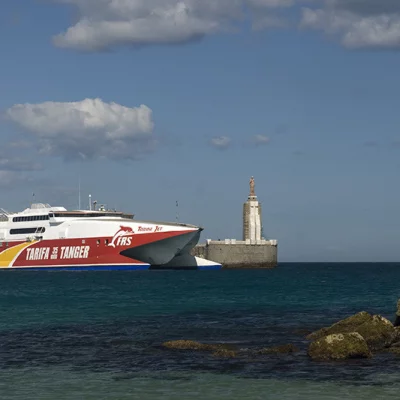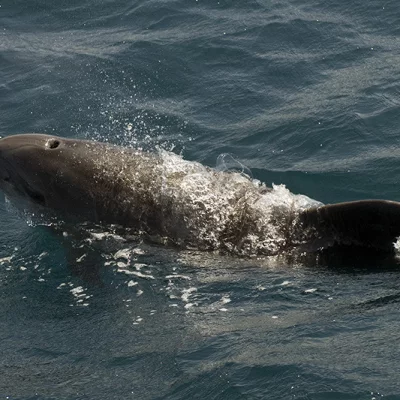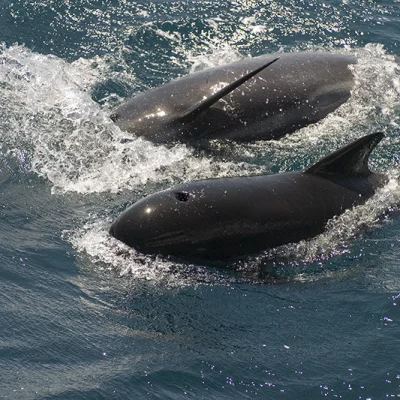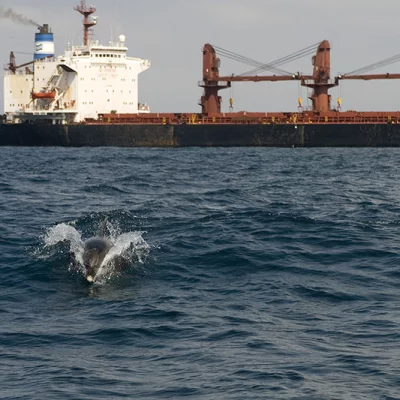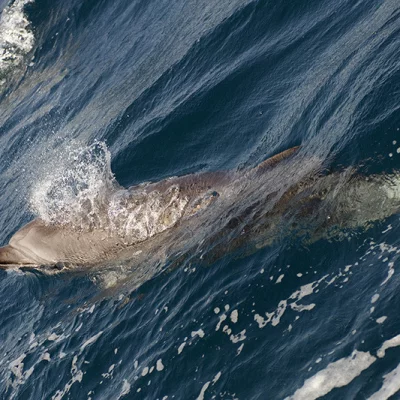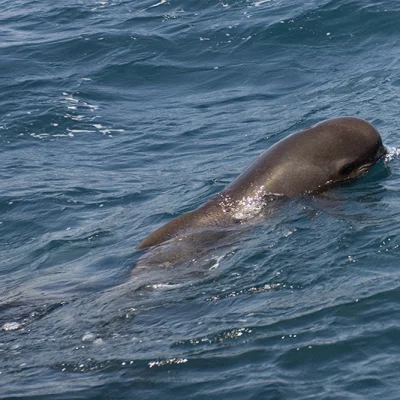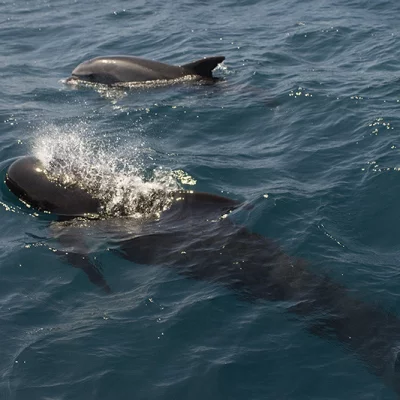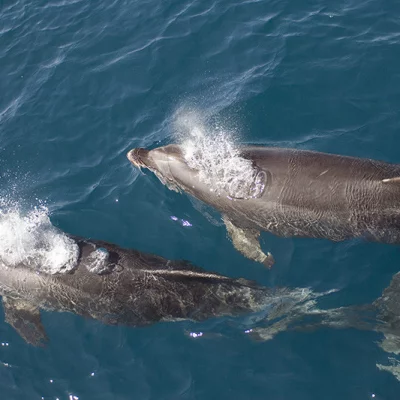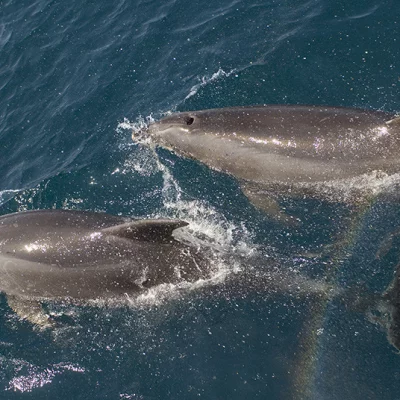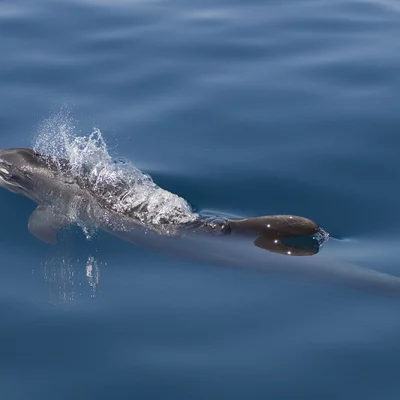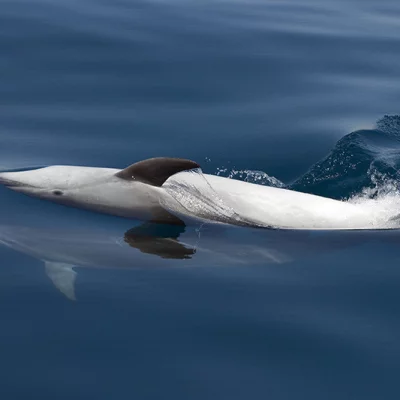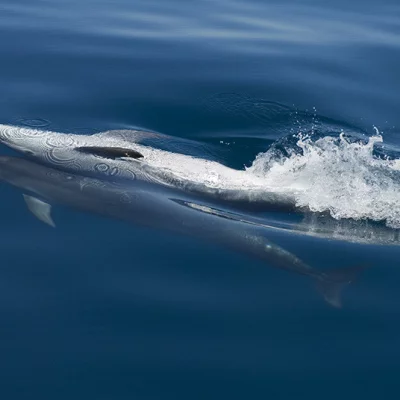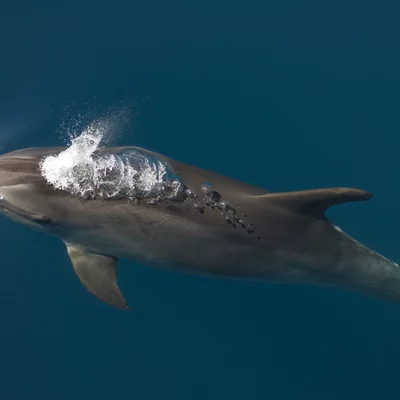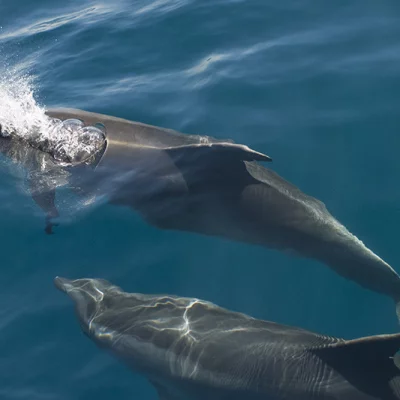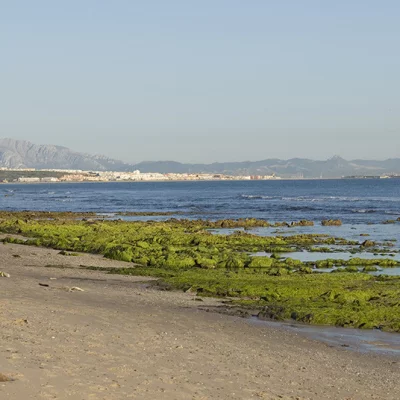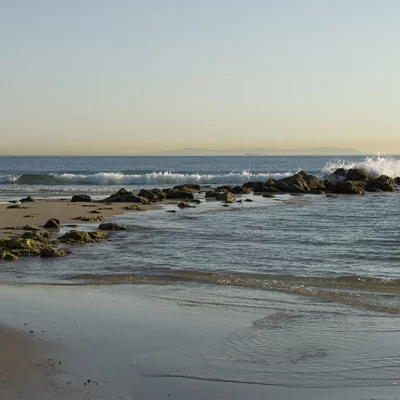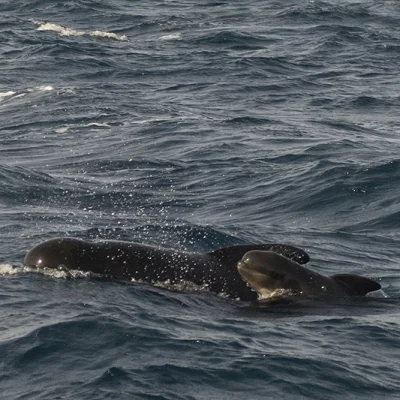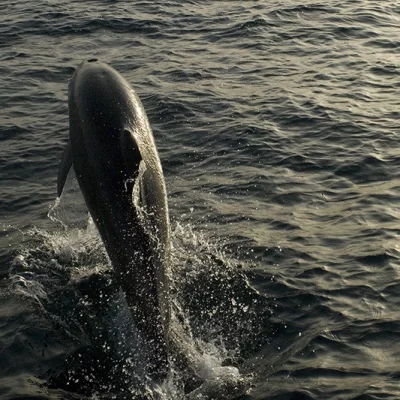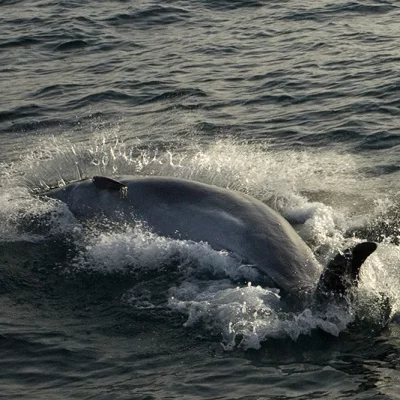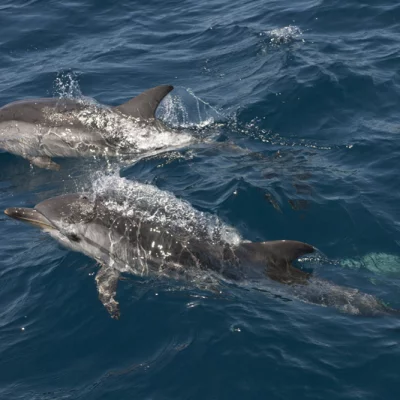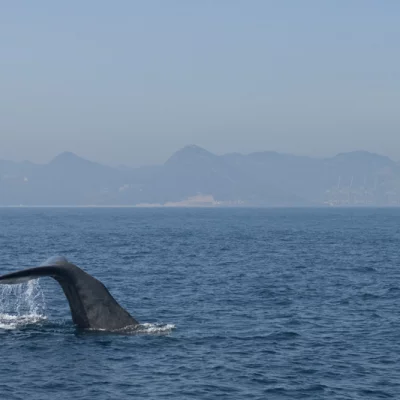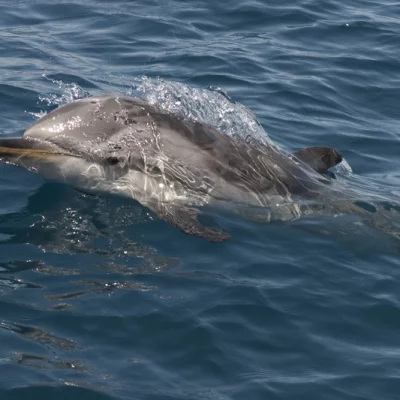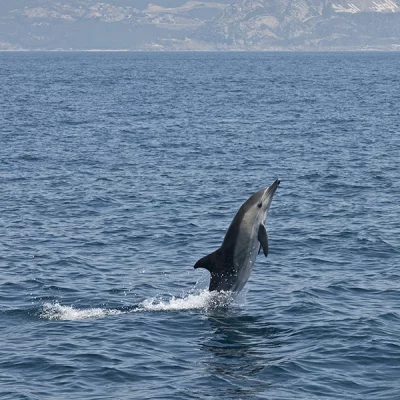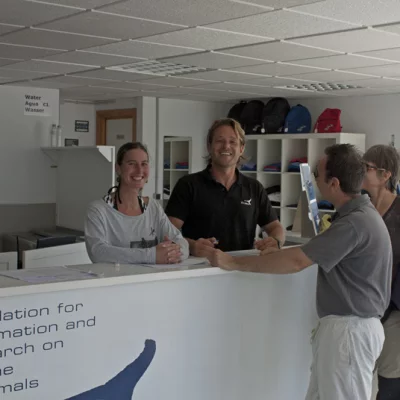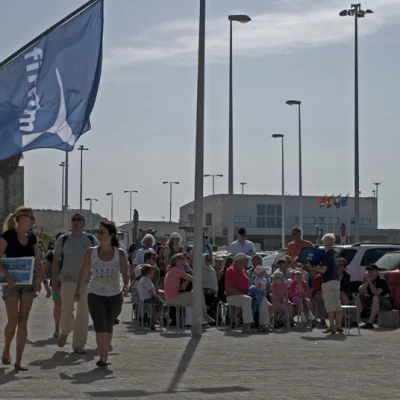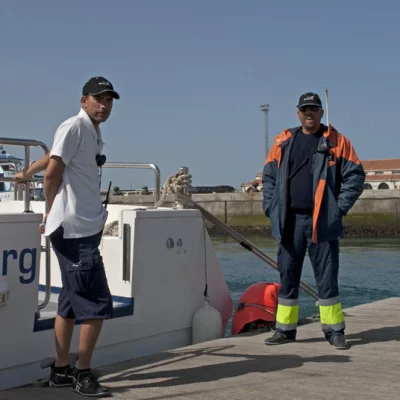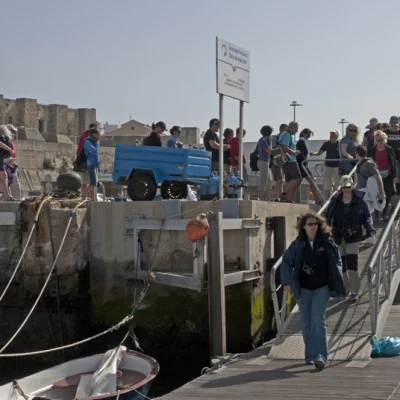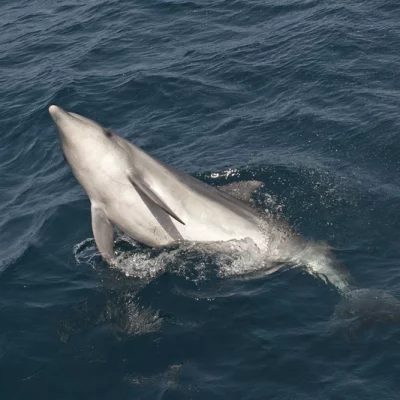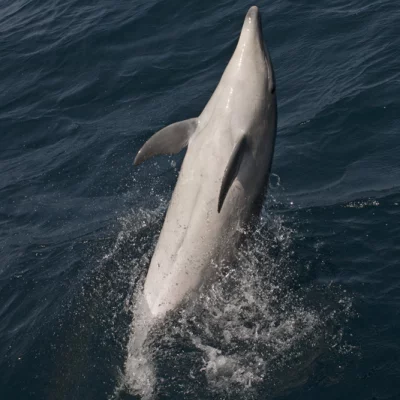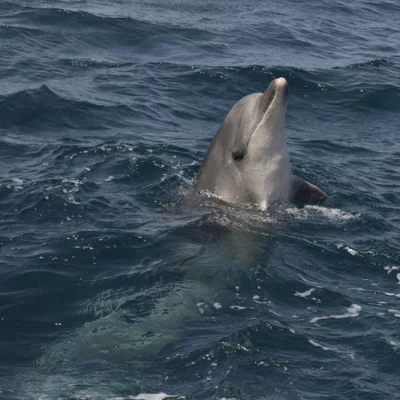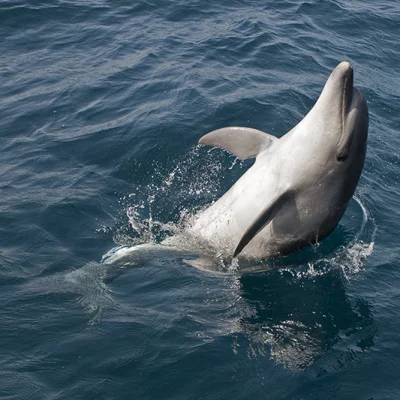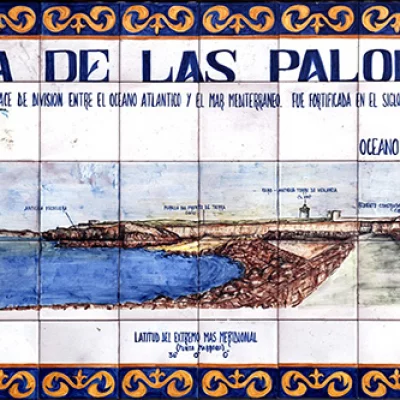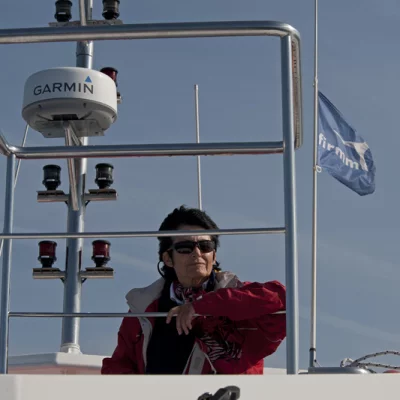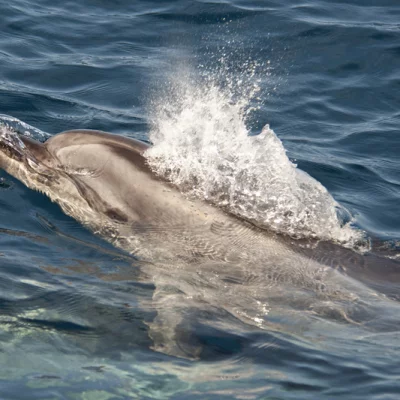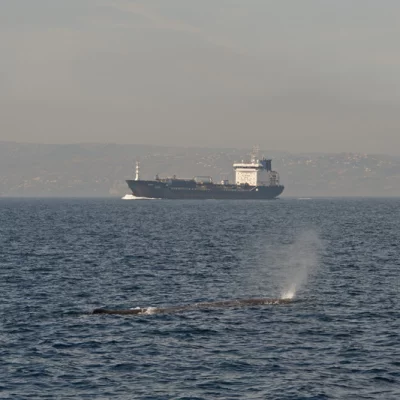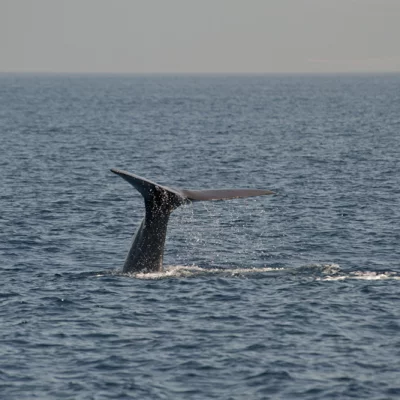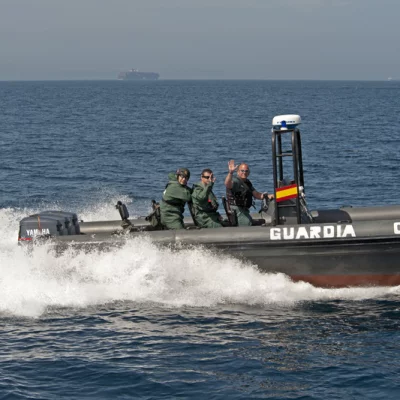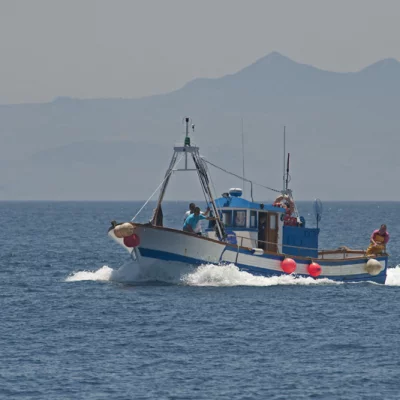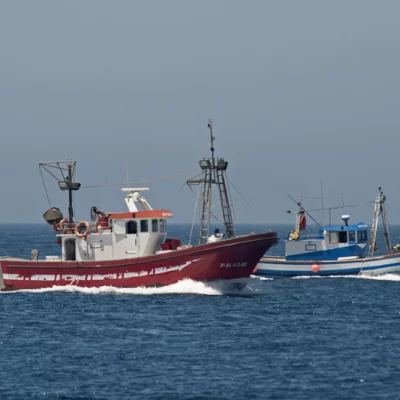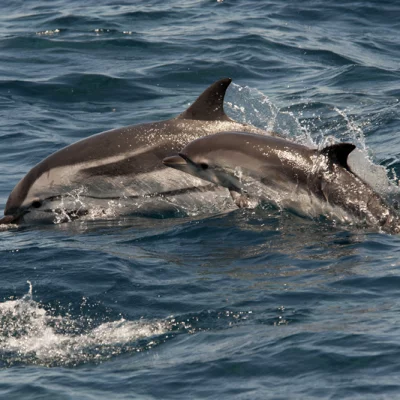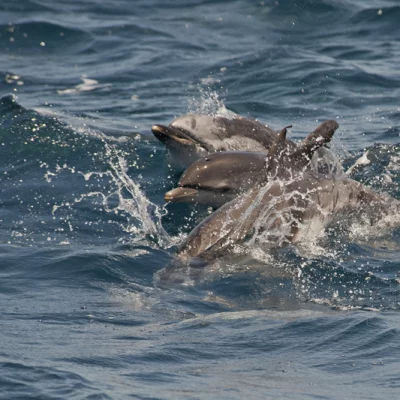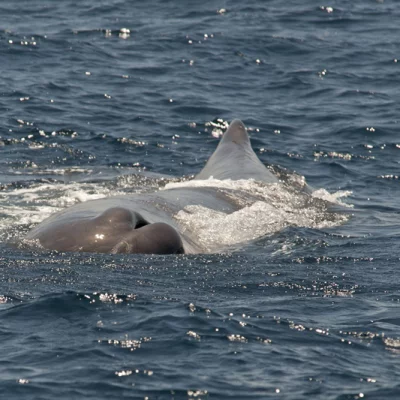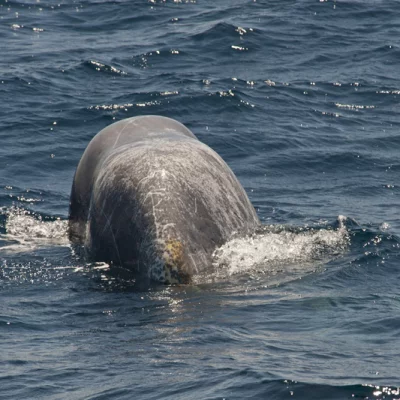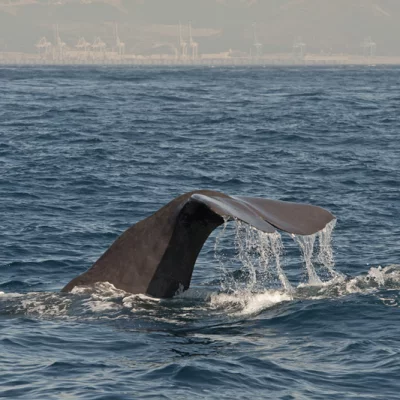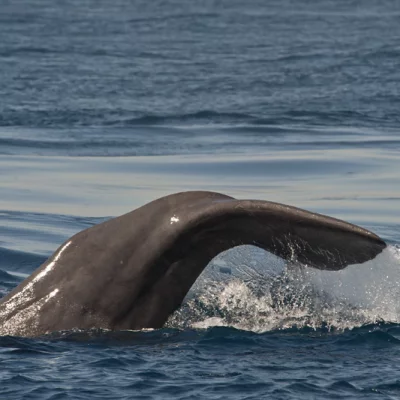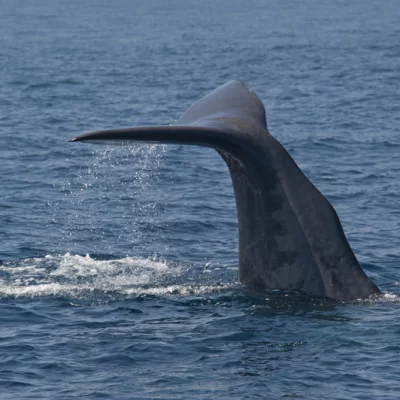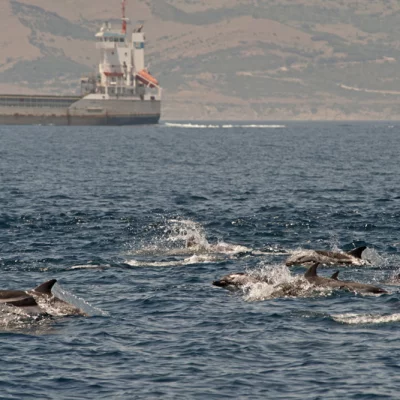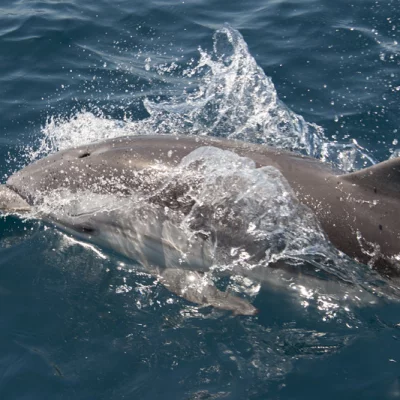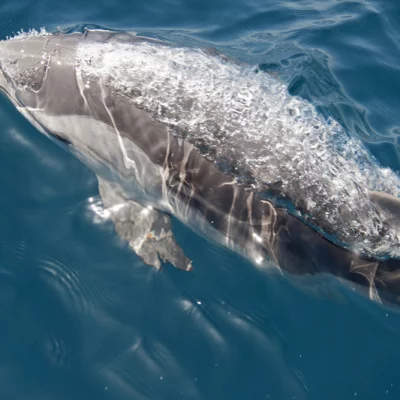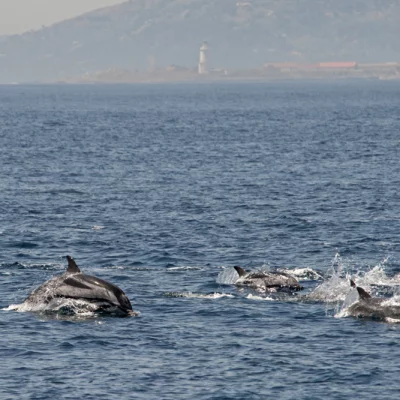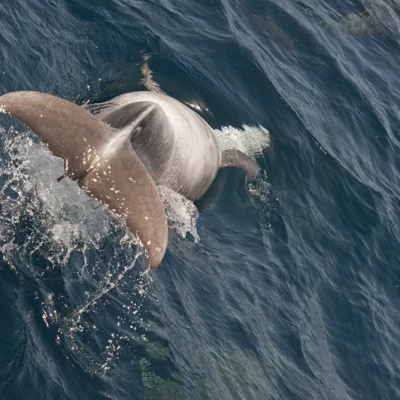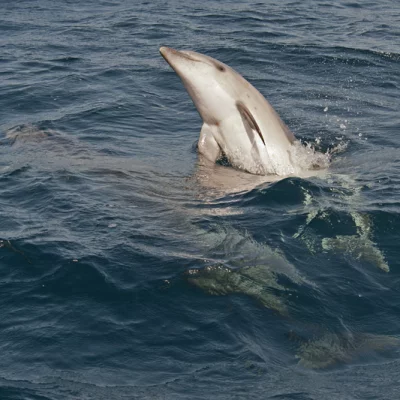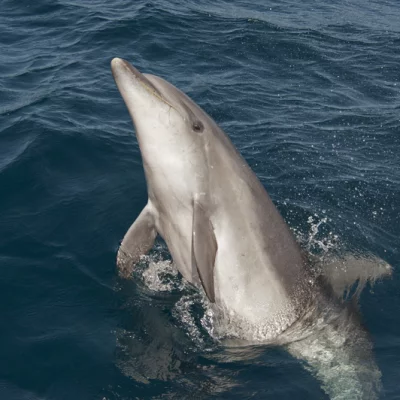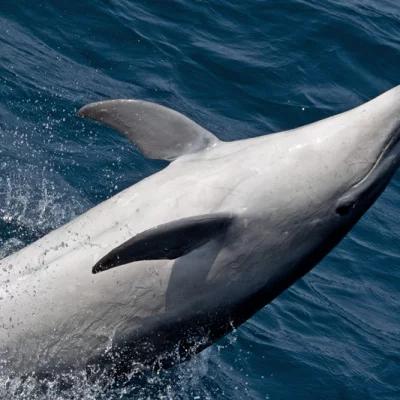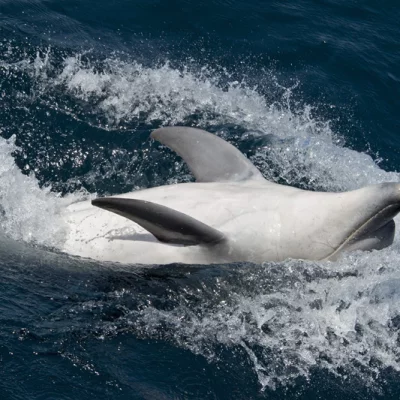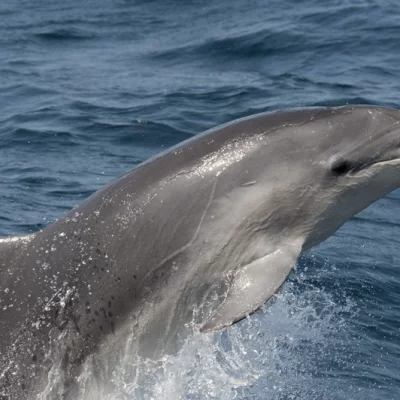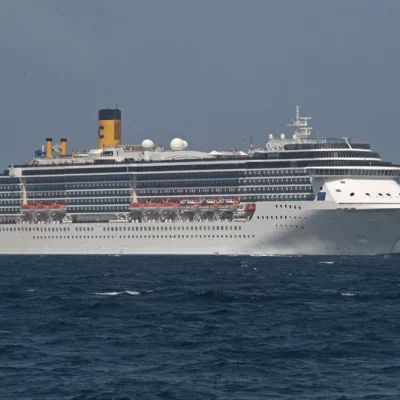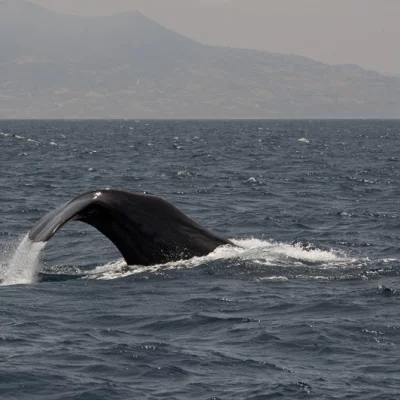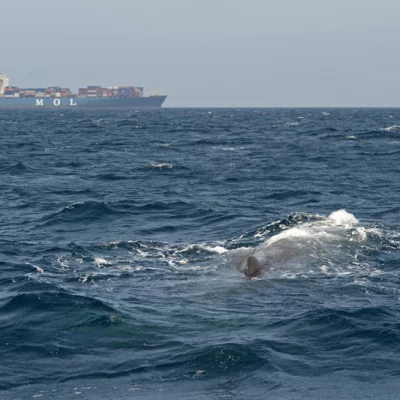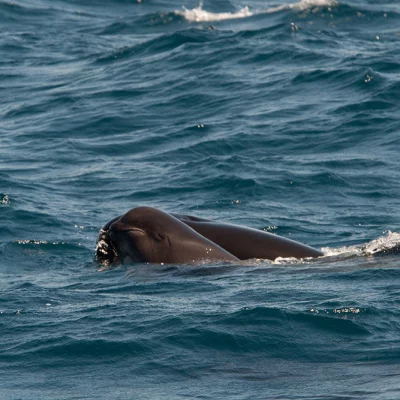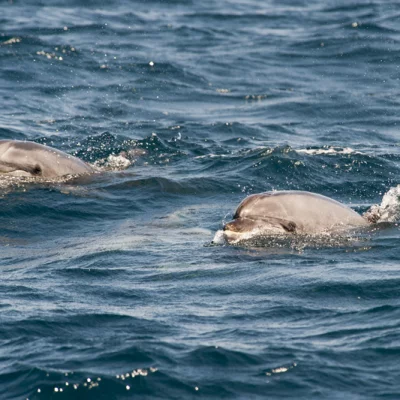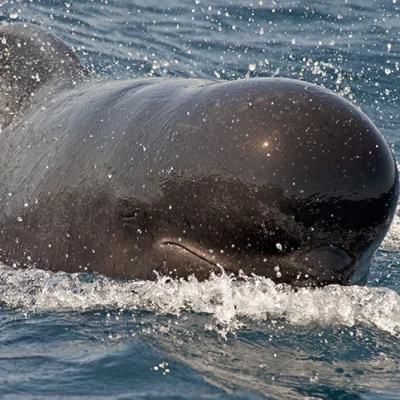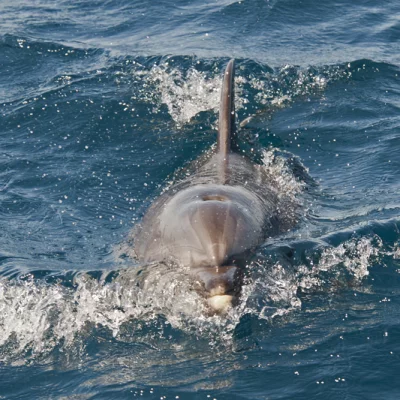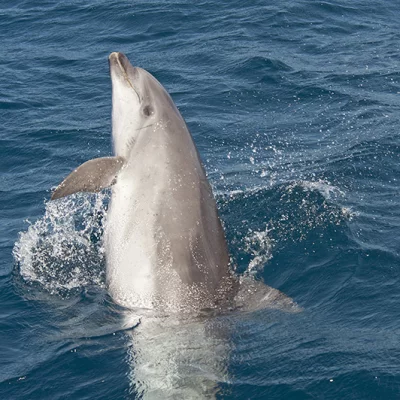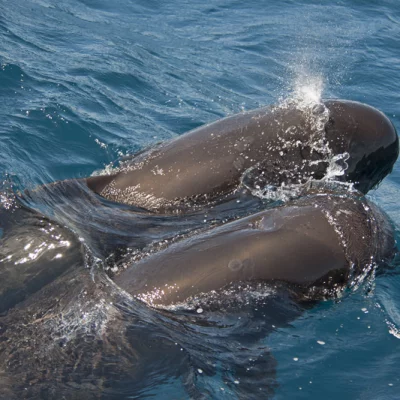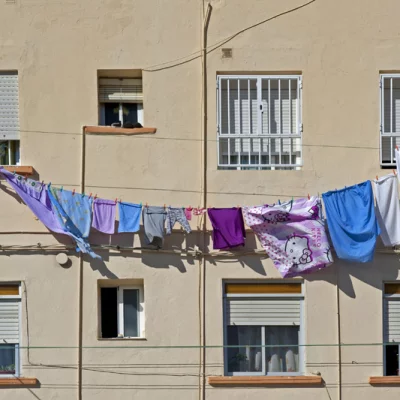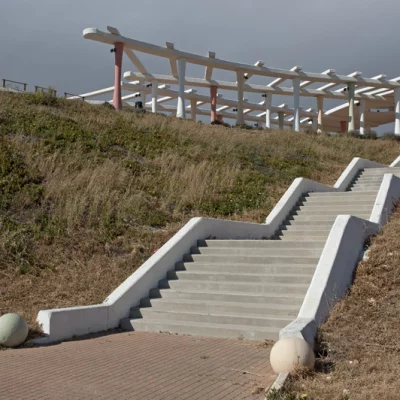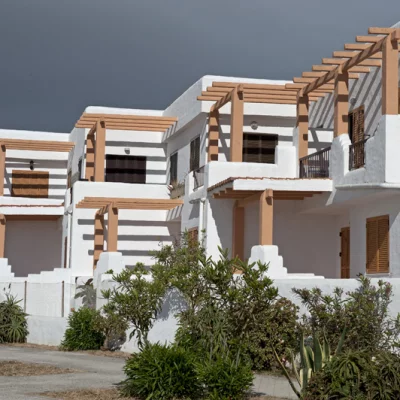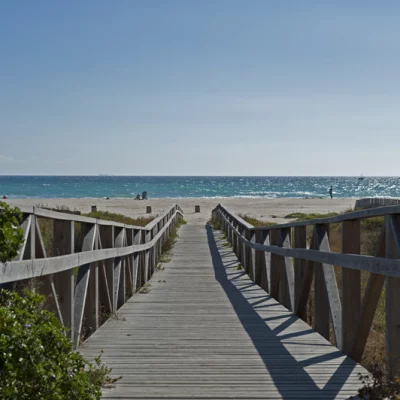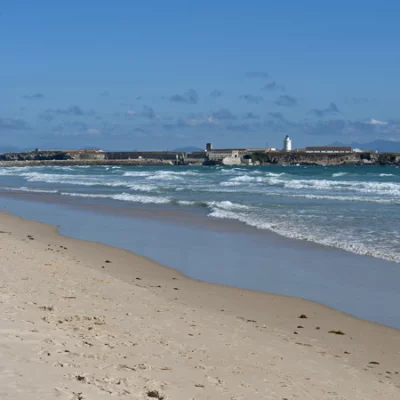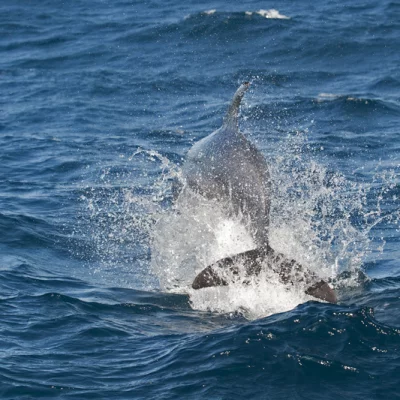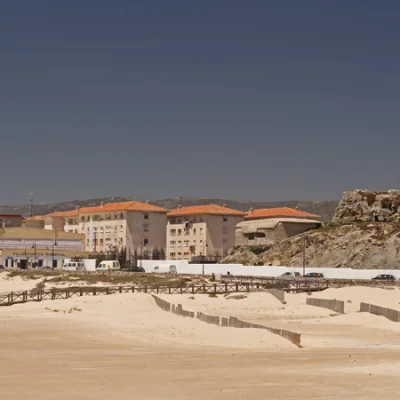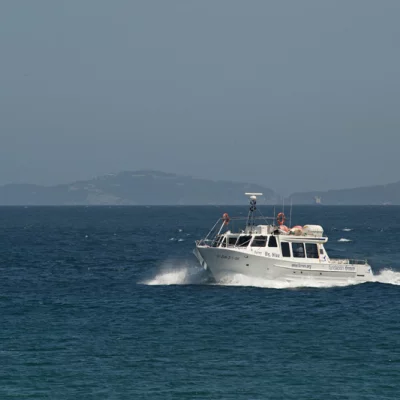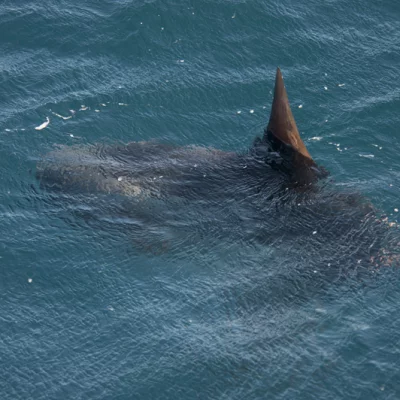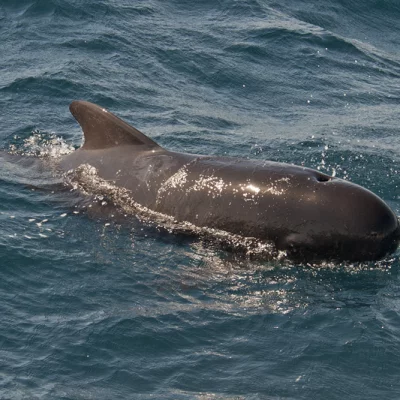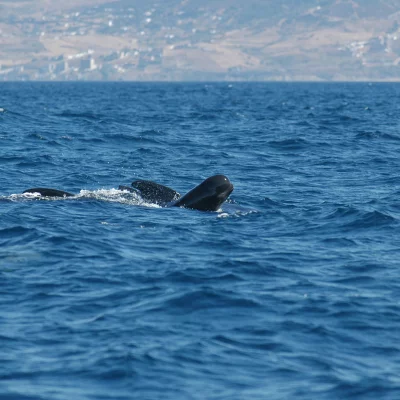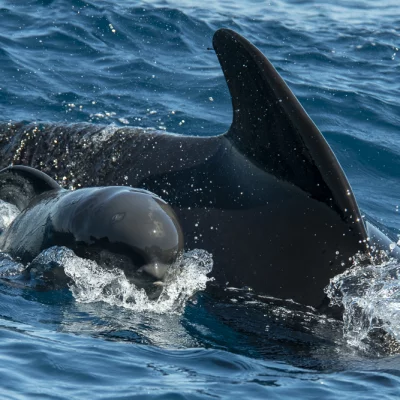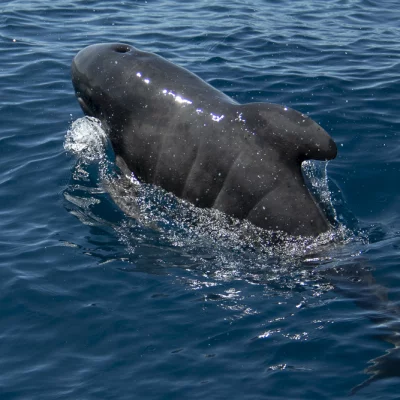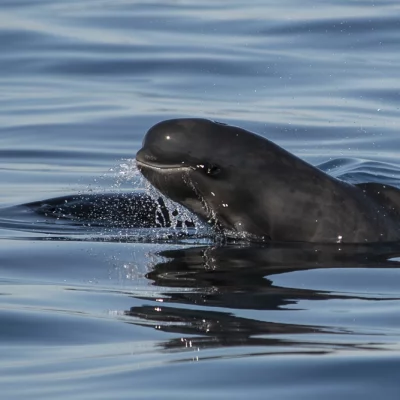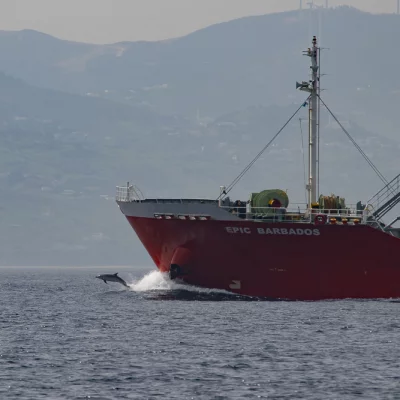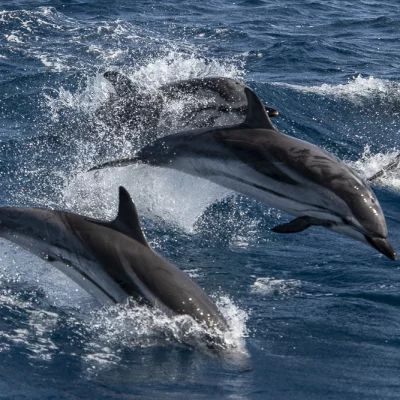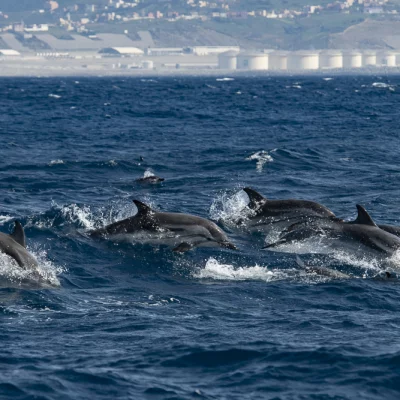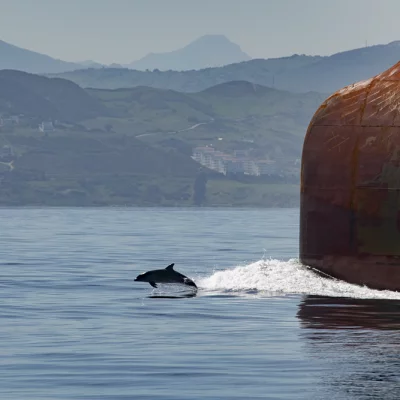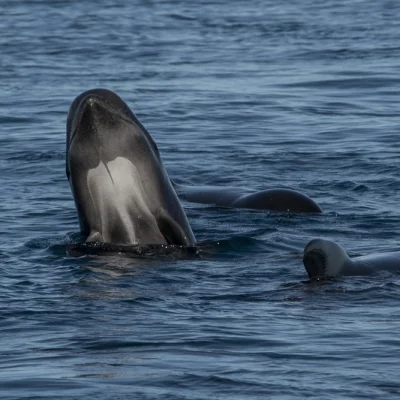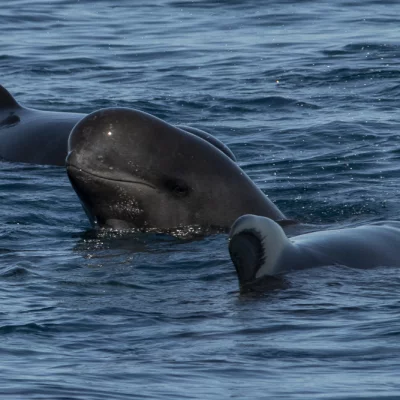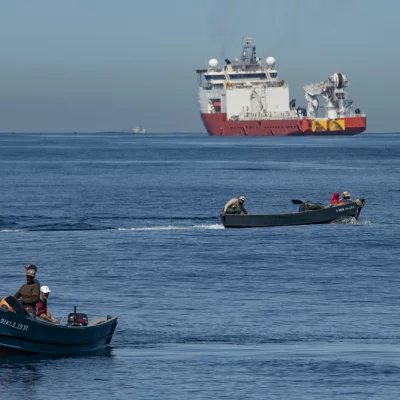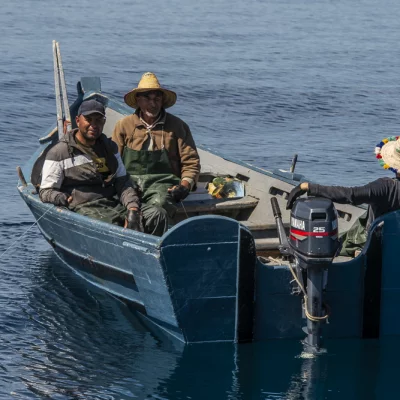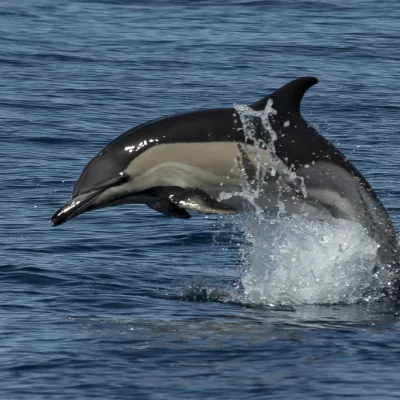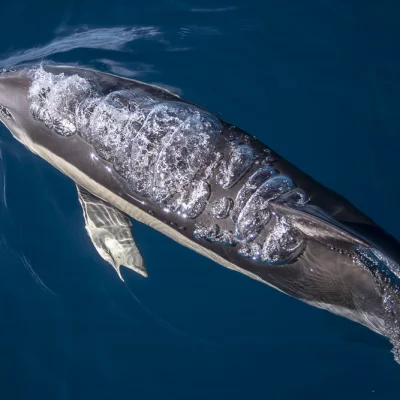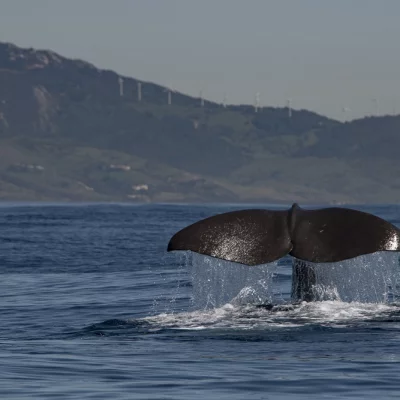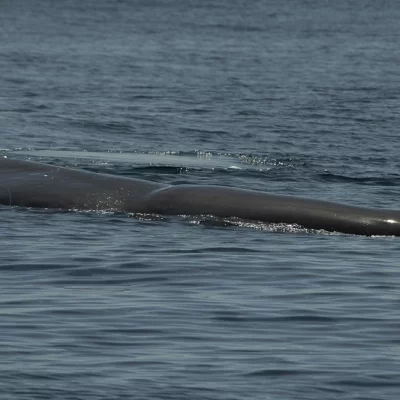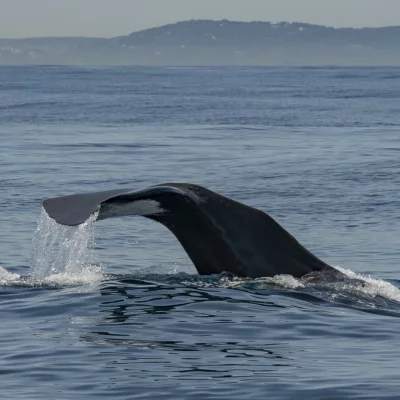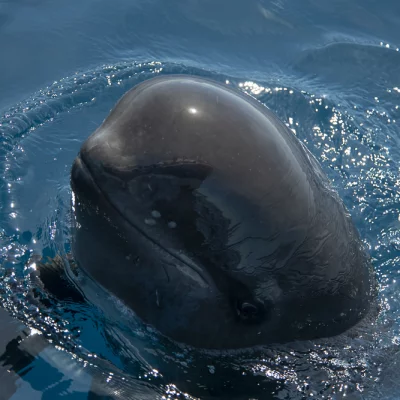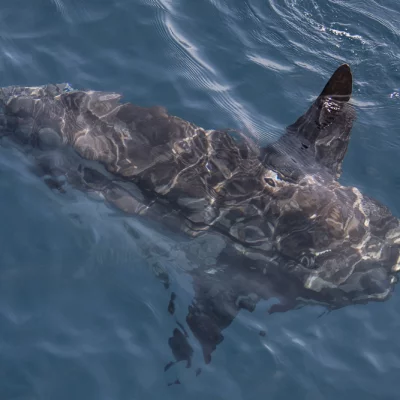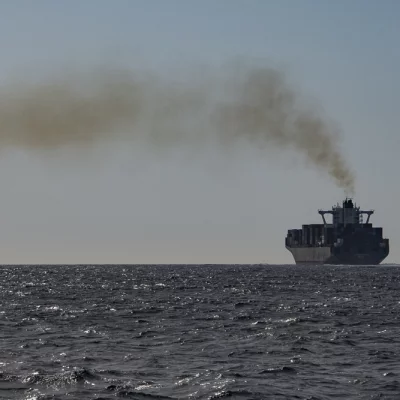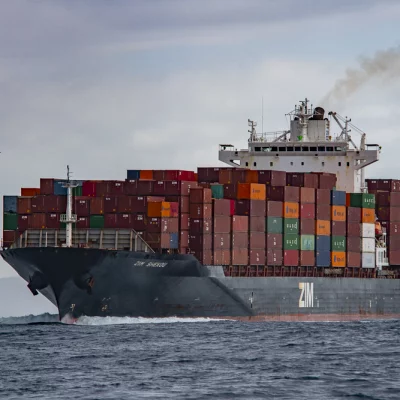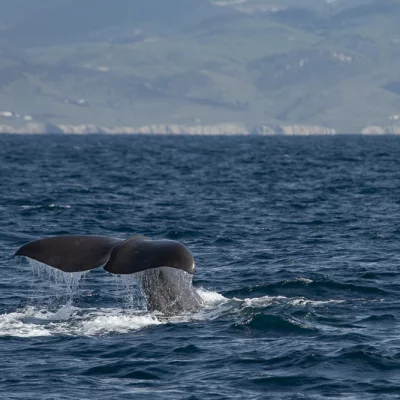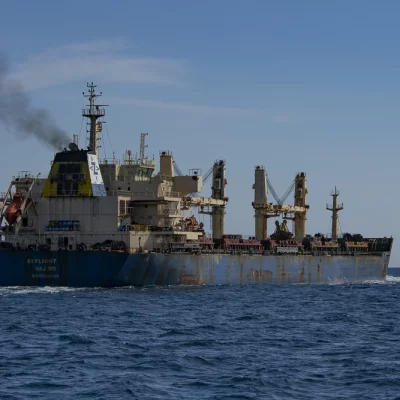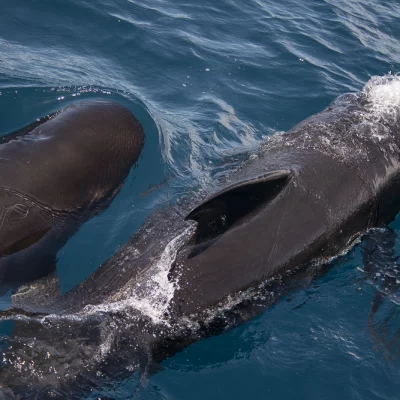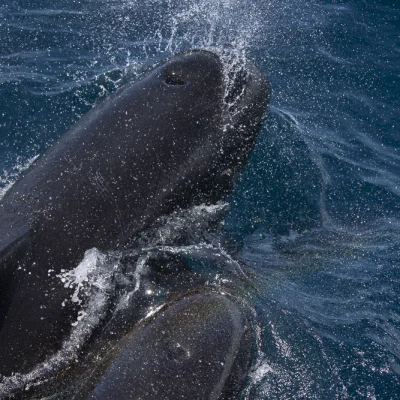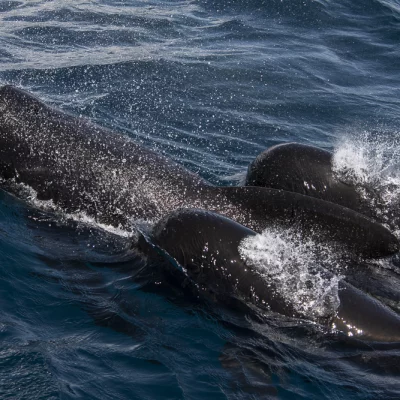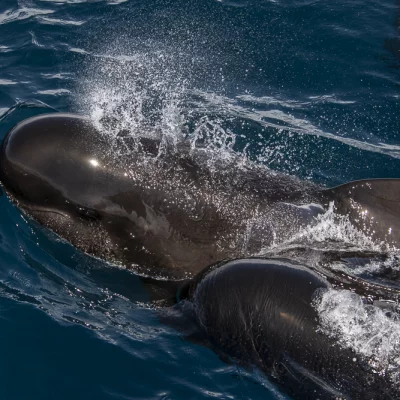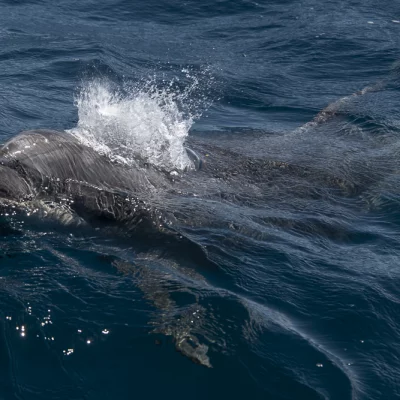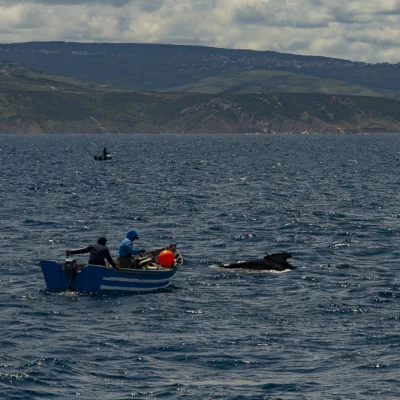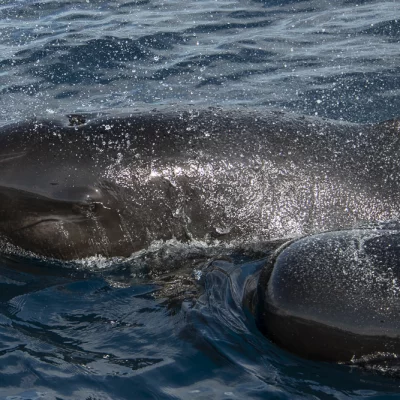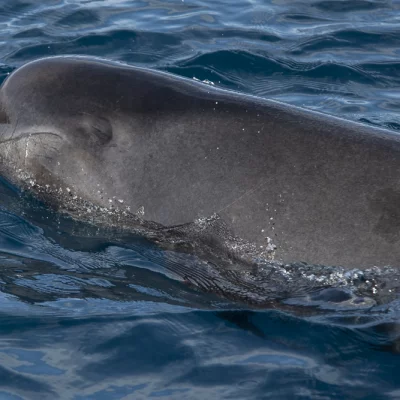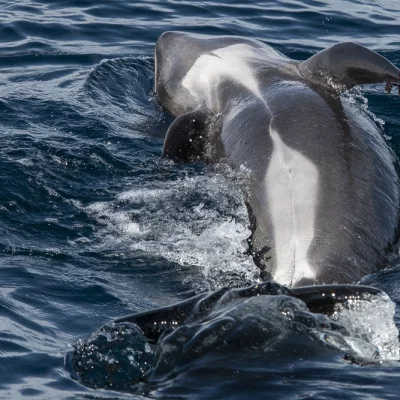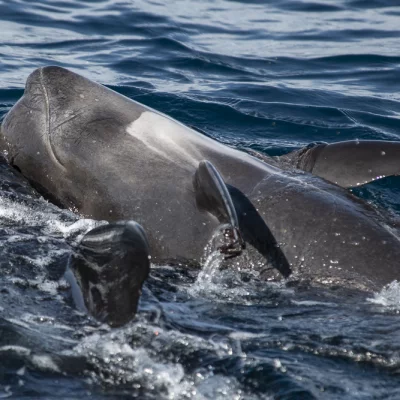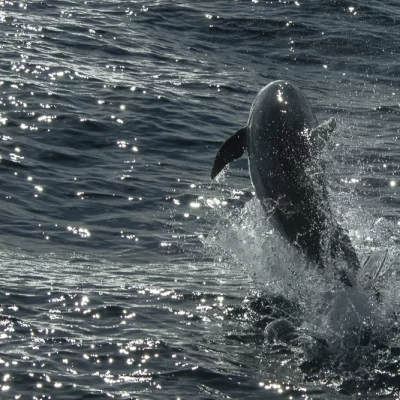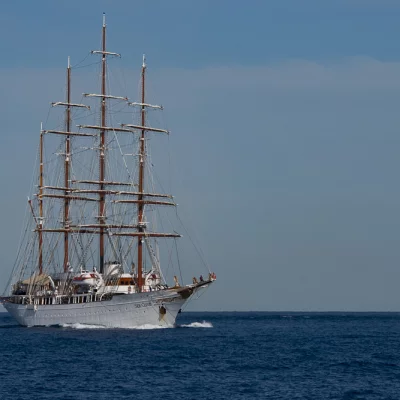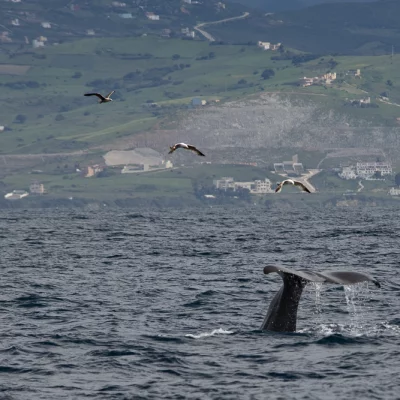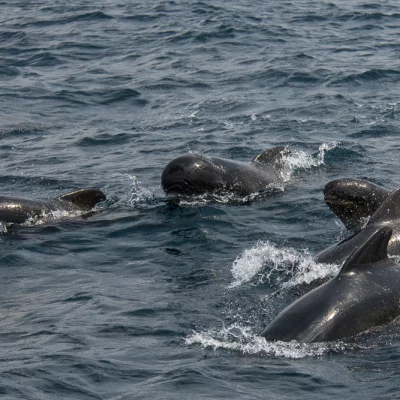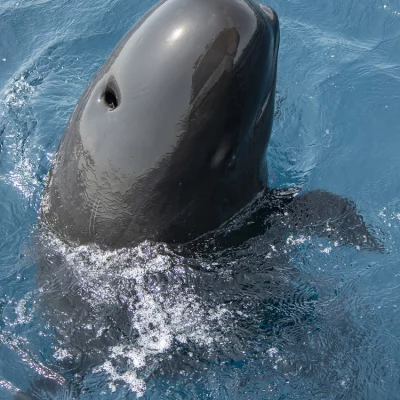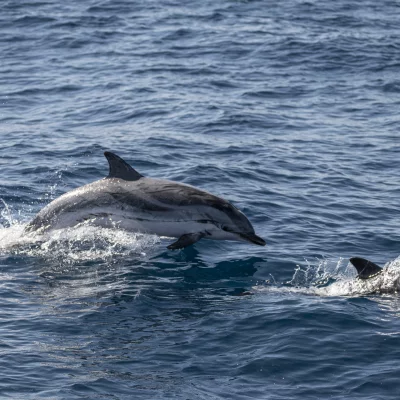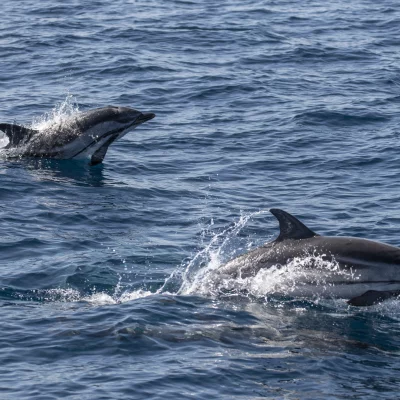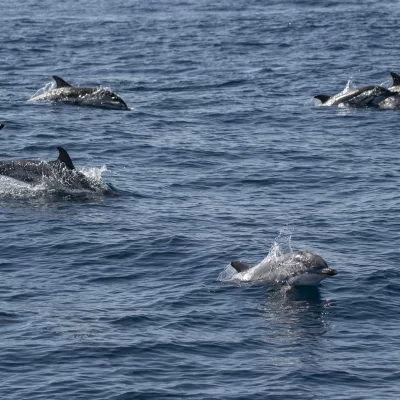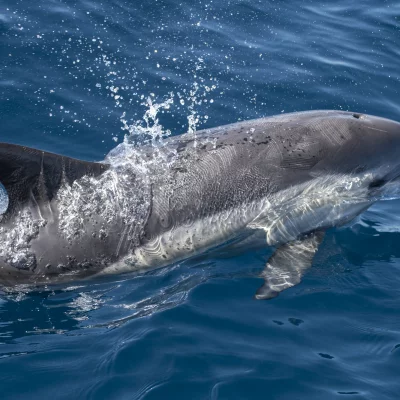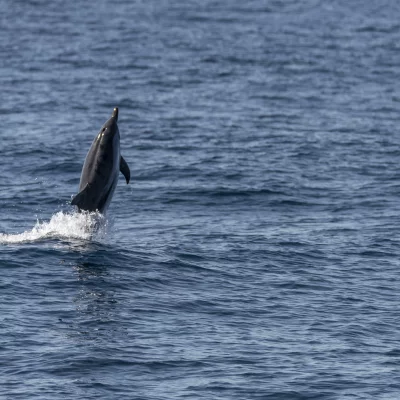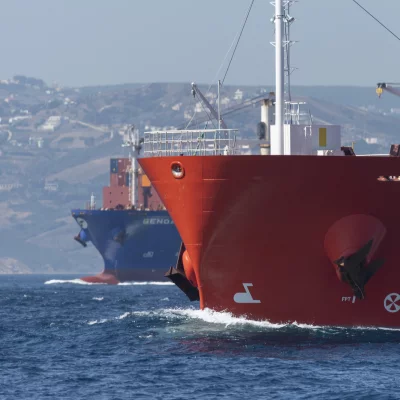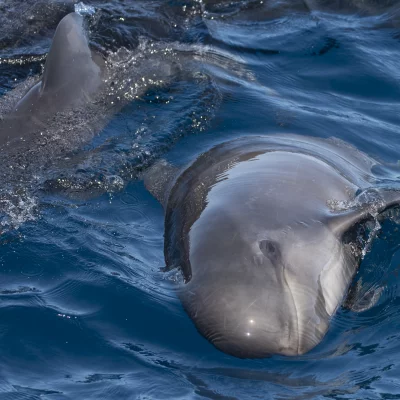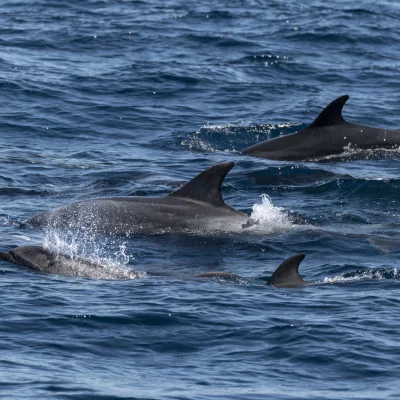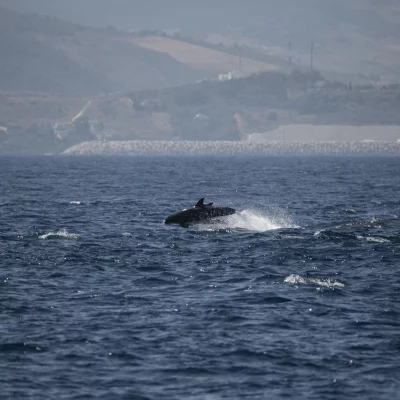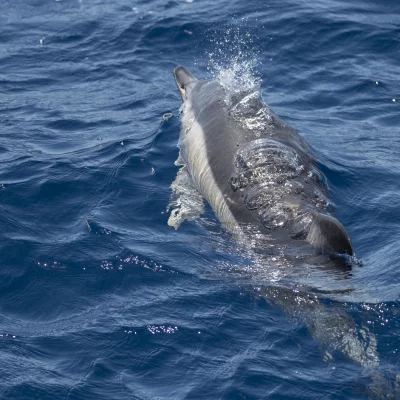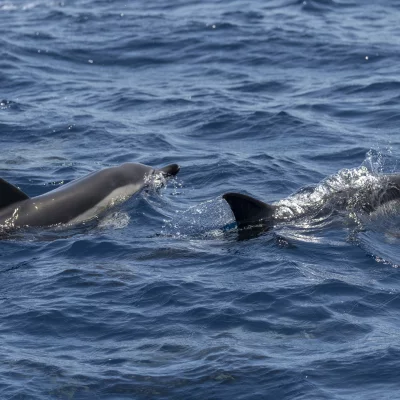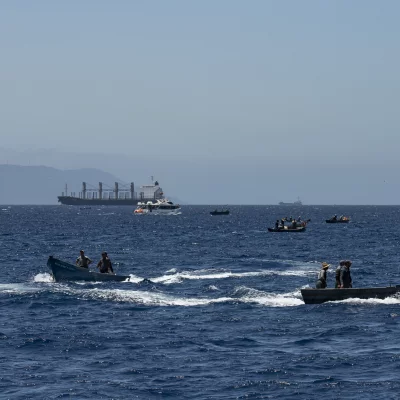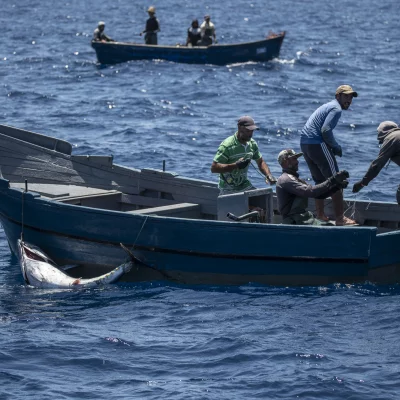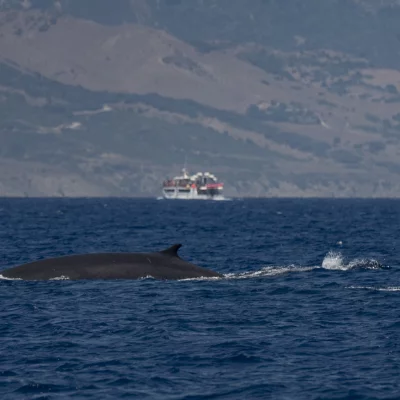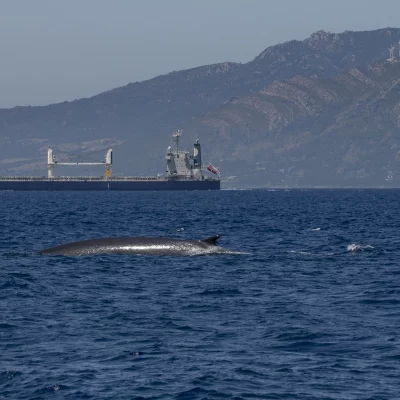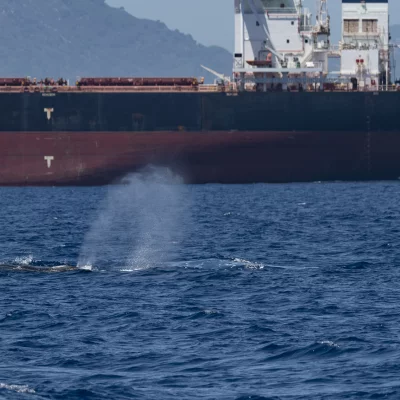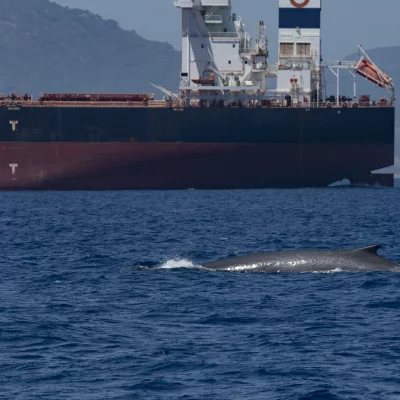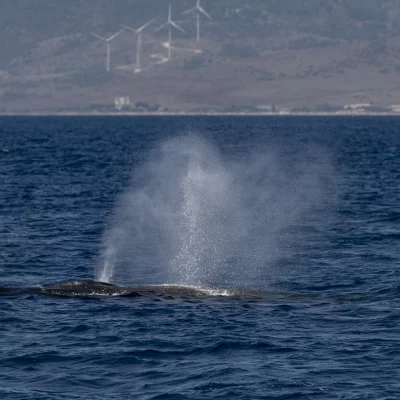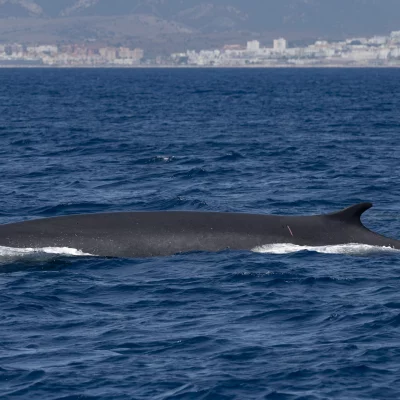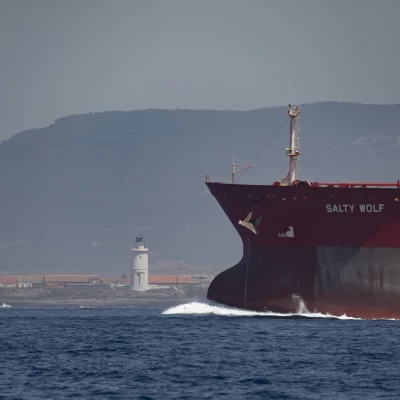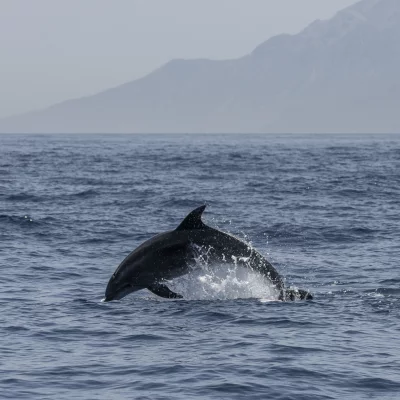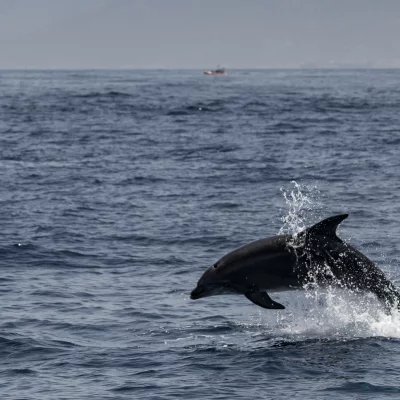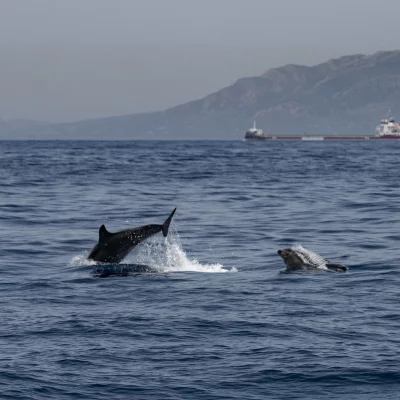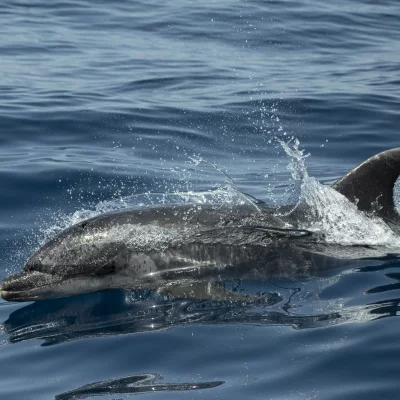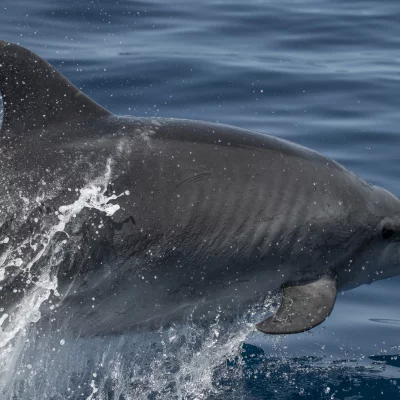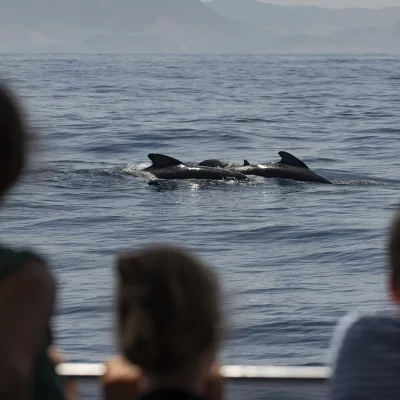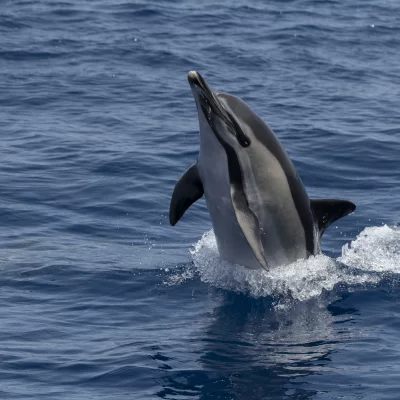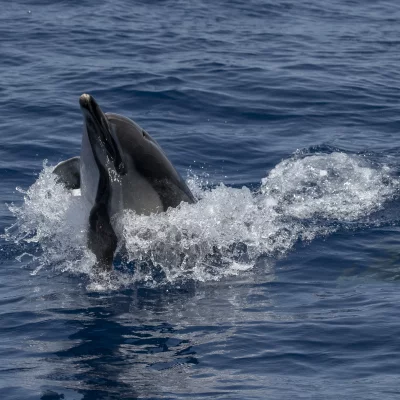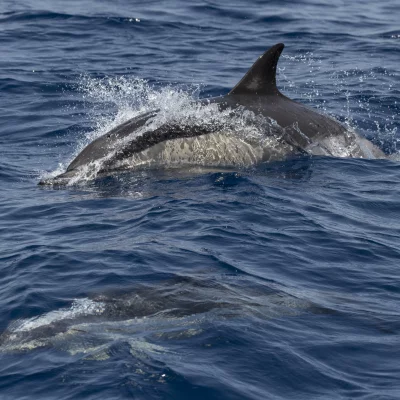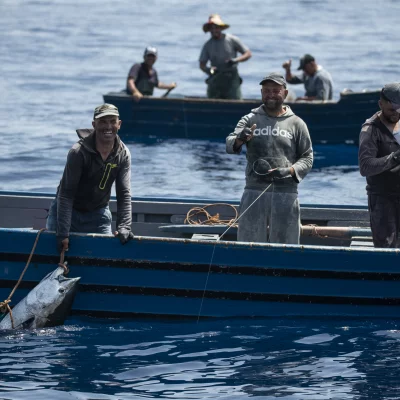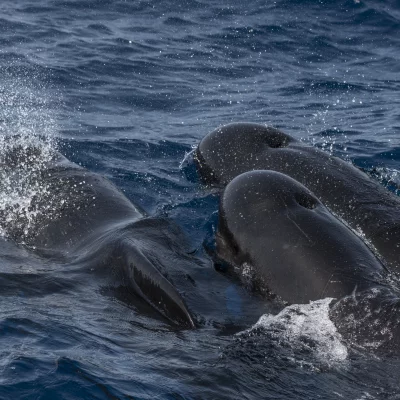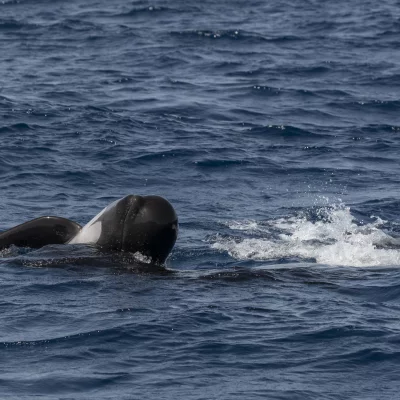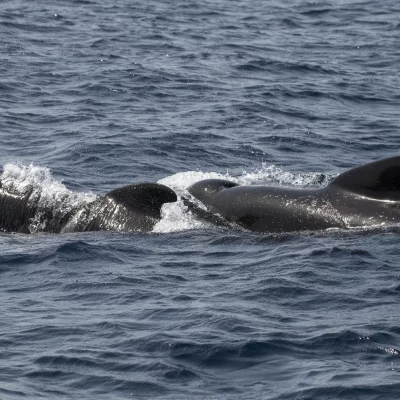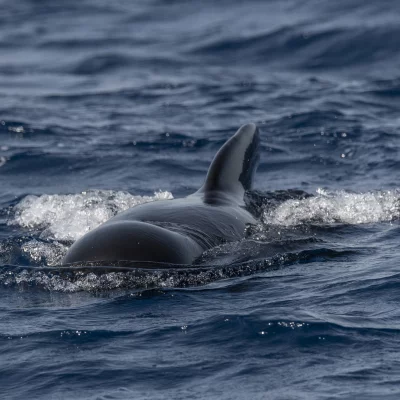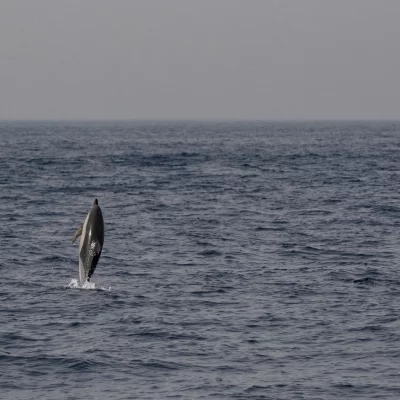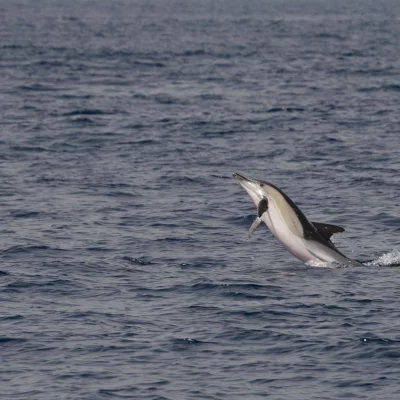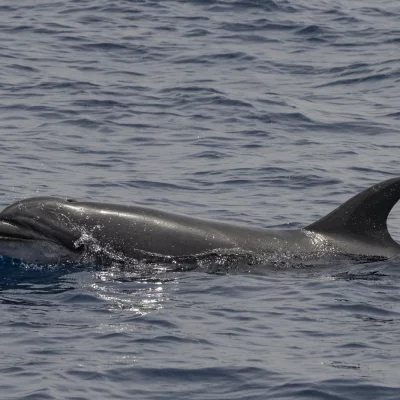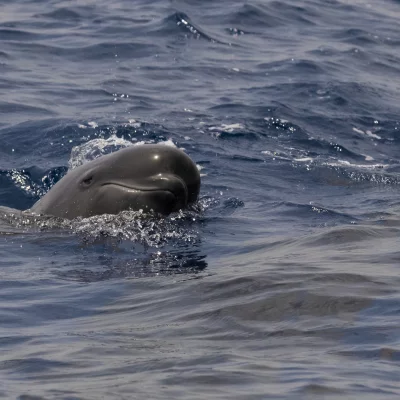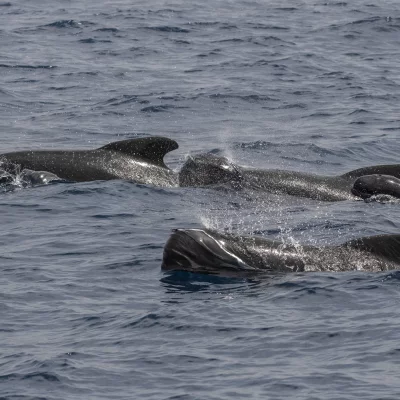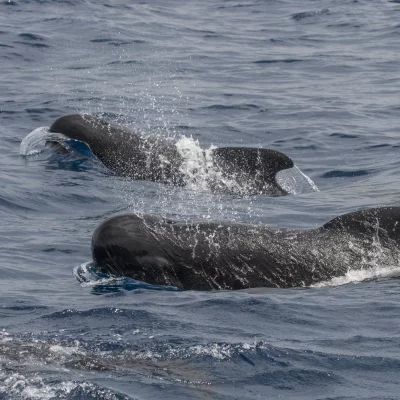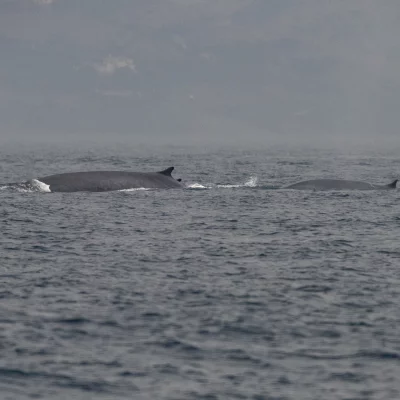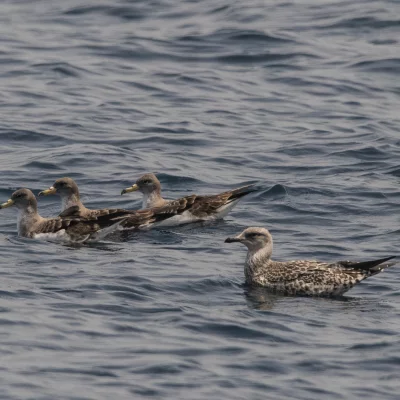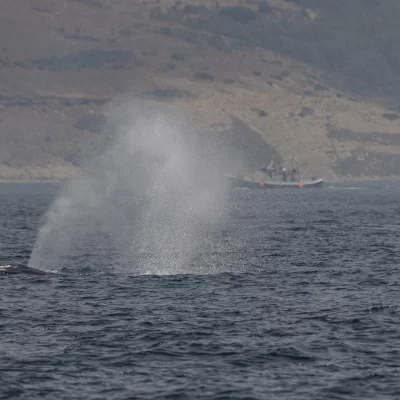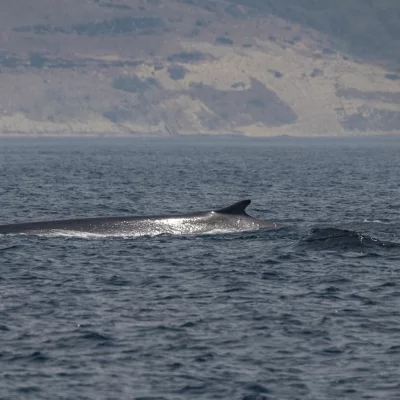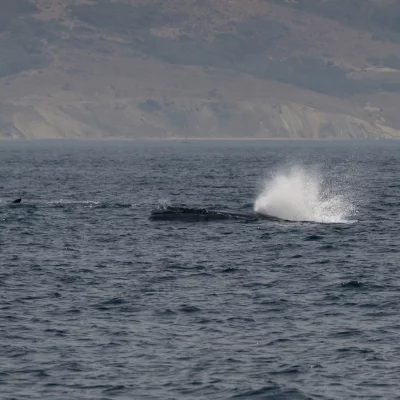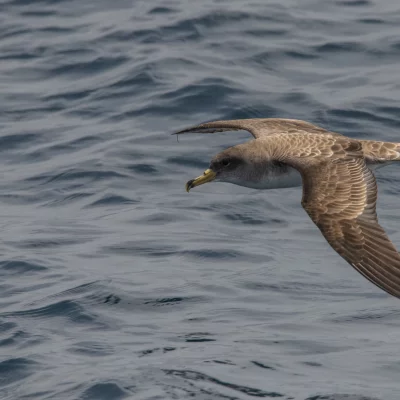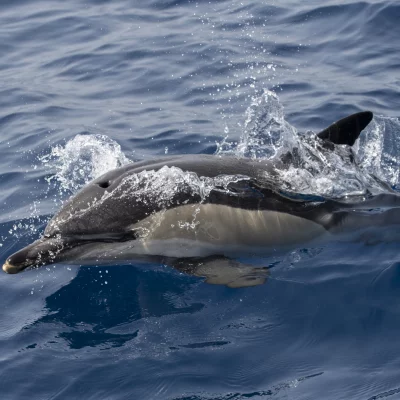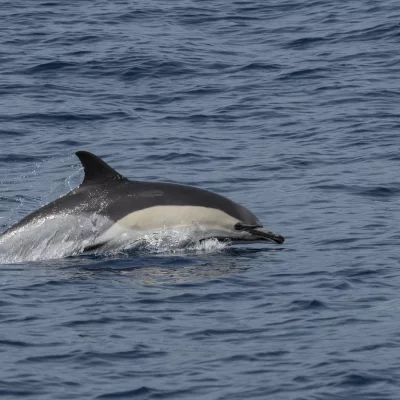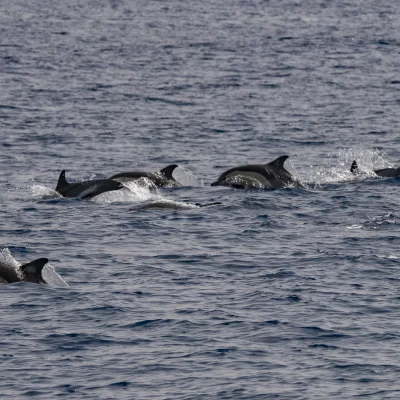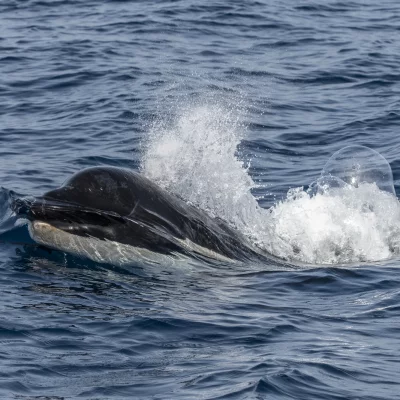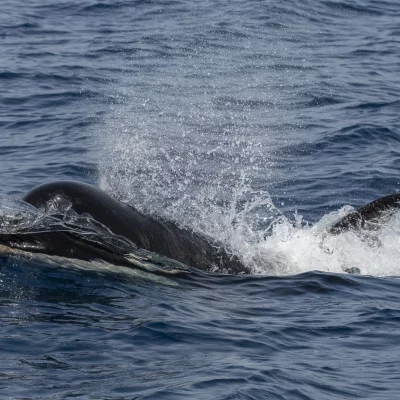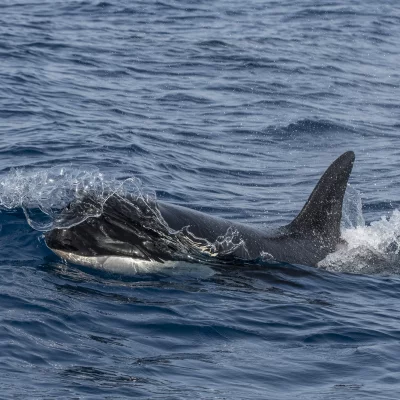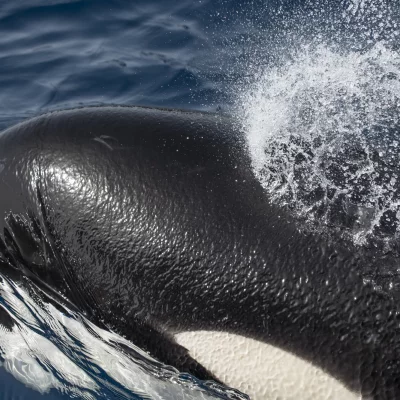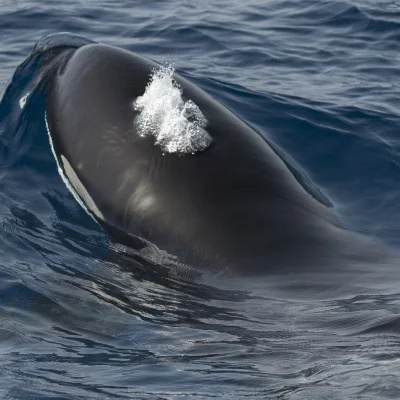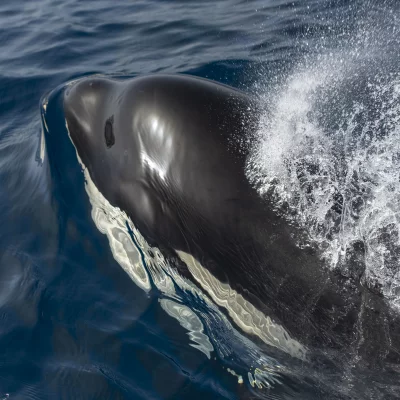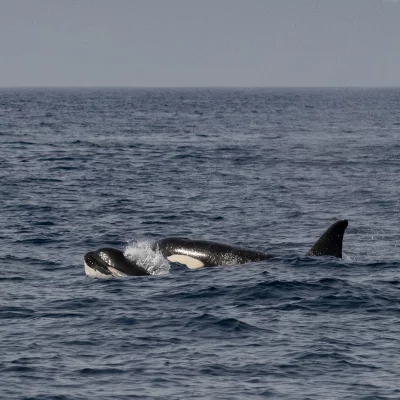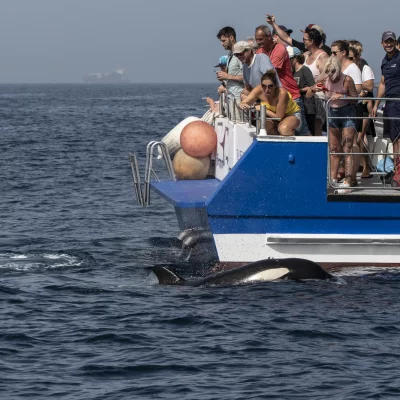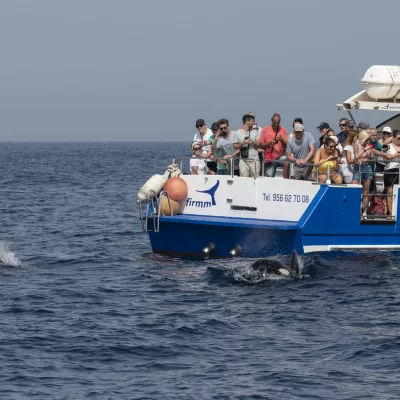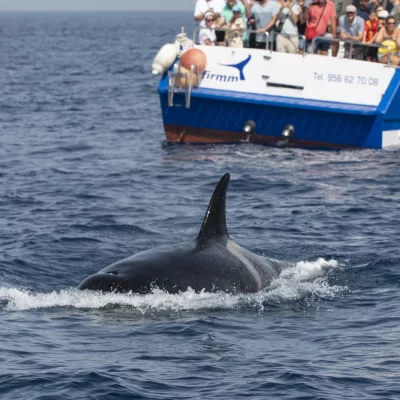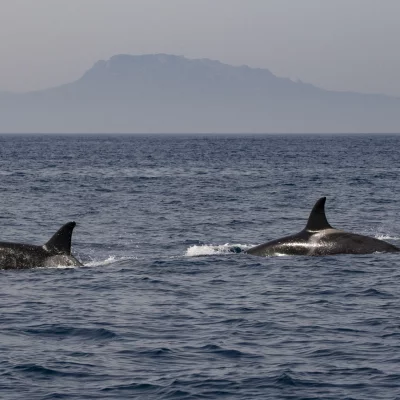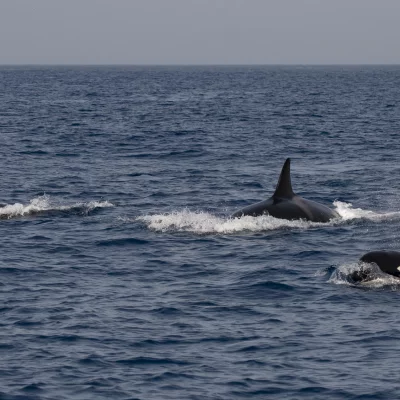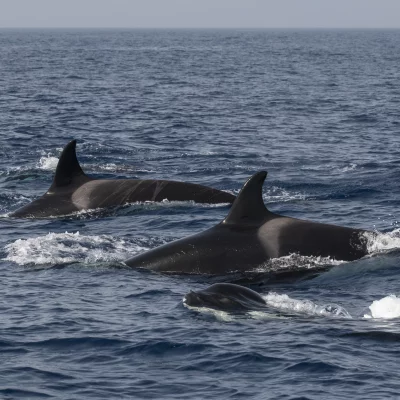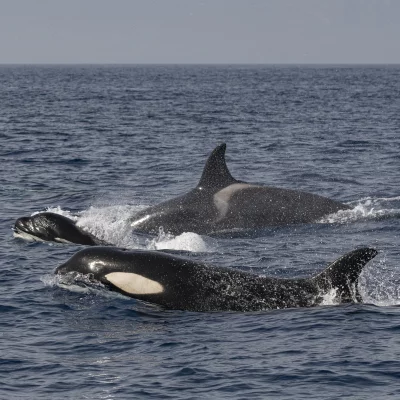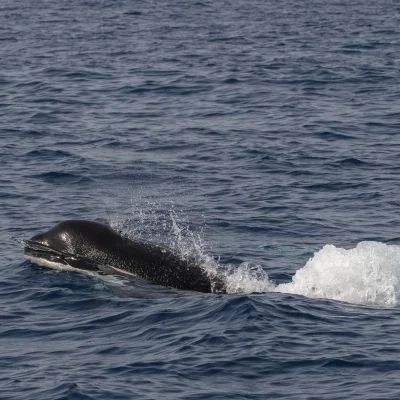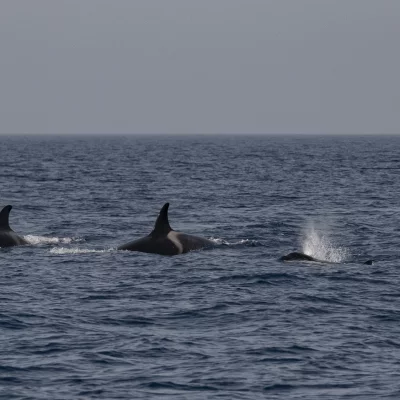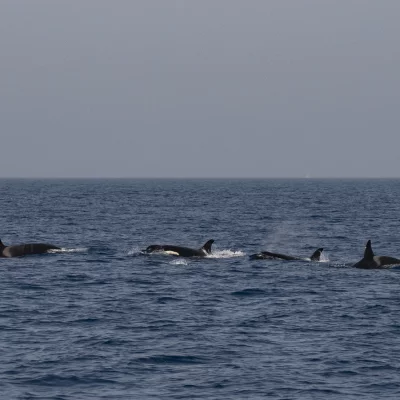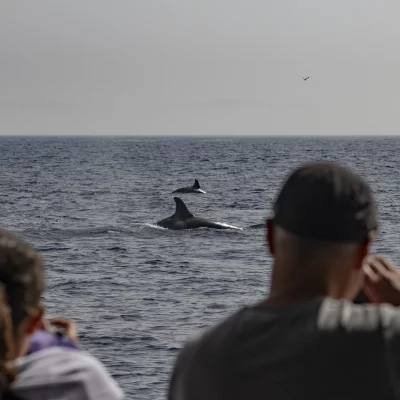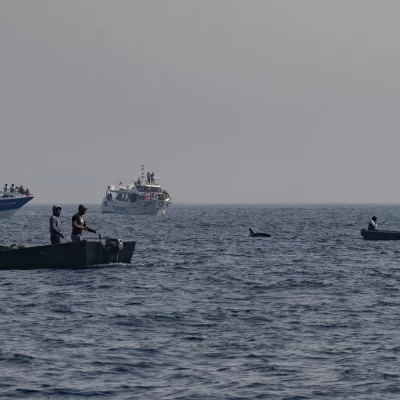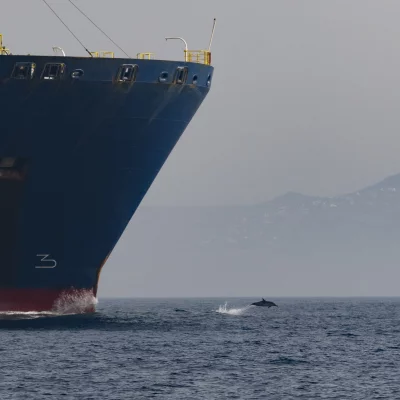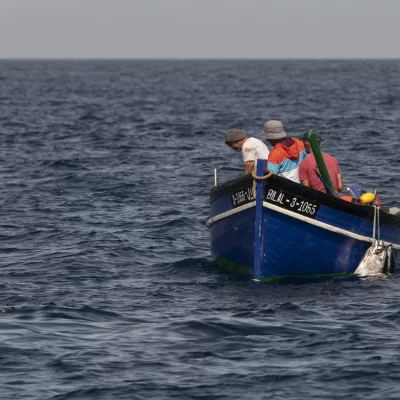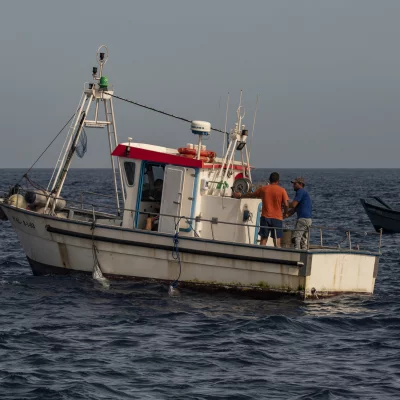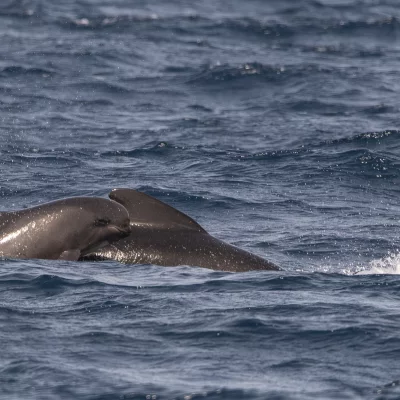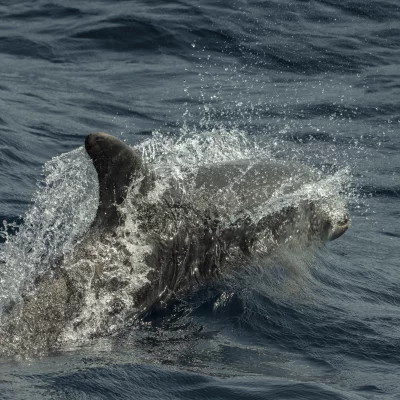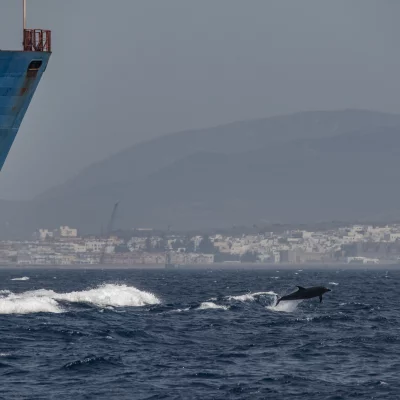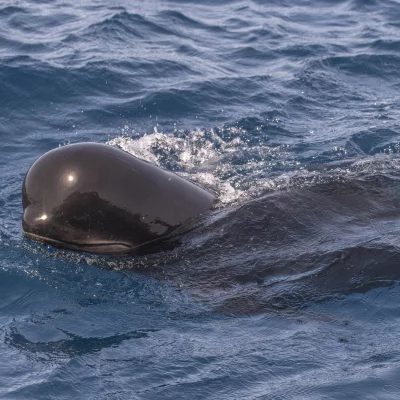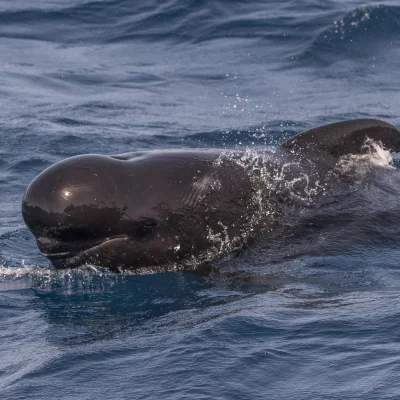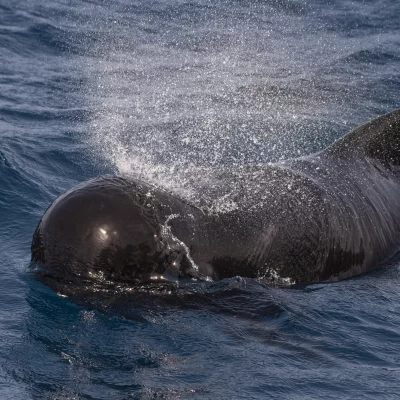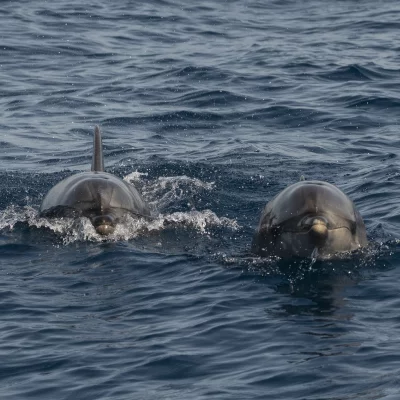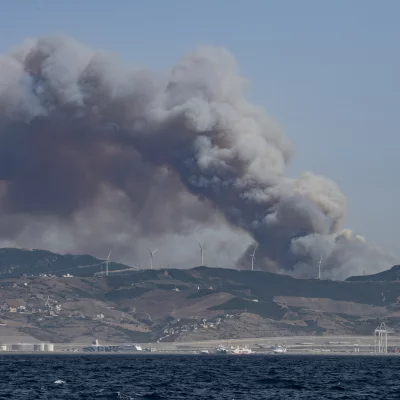Tarifa, Spain
The pictures in this album have been made in Tarifa and the Strait of Gibraltar during a one week course about whale and dolphin observation of the Swiss foundation FIRMM . Thanks to Katharina Heyer and all who are working for this project. I can highly recommend this experience.
Fig. 1 : A bug on a flower — Nikon D70, Nikkor Micro 105mm 1:2.8, Tarifa, Spain, May 2005 — EXIF: Nikon D70; Δt=1/500 s; f=105 mm; f/14.0; ISO 200; 2005-05-02 14:17:52
Fig. 2 : image200505-d70-4254.jpg — EXIF: Nikon D70; Δt=1/500 s; f=38 mm; f/11.0; 2005-05-02 16:51:24
Fig. 3 : Moroccan refugees on their failed crossing of the Strait of Gibraltar. The engine of their small, completely overloaded rubber boat probably gave out when they tried to cross over at night. They were probably discovered by a Moroccan freighter named "Atlas Casablanca", which turned around in the middle of the journey. We were unsuccessful on the Firmm boat on this overcast morning in search of whales and dolphins. The picture was taken on May 5, 2005 at 10:18 am and is an enlarged detail — Nikon D70, AF-S Nikkor 80-200mm 1:2.8 D, 1/1000s at 1:4.5 at ISO 400, Tarifa, Spain — EXIF: Nikon D70; Δt=1/1000 s; f=200 mm; f/4.5; 2005-05-05 10:17:39
Fig. 4 : image200505-d70-4269.jpg — EXIF: Nikon D70; Δt=1/1000 s; f=200 mm; f/4.5; 2005-05-05 10:18:13
Fig. 5 : Ships circle the refugee boat to protect it from oncoming ships. — EXIF: Nikon D70; Δt=1/3200 s; f=200 mm; f/3.2; 2005-05-05 10:33:16
Fig. 6 : Reception of Moroccan refugees by the Red Cross and police in Tarifa port — Nikon D70, AF-S Nikkor 80-200mm 1:2.8, Tarifa, Spain, May 5, 2005 — EXIF: Nikon D70; Δt=1/640 s; f=200 mm; f/5.0; 2005-05-05 11:20:33
Fig. 7 : Reception of the Moroccan refugees by the Red Cross and the police in the port of Tarifa — Nikon D70, AF-S Nikkor 80-200mm 1:2.8, Tarifa, Spain, May 5, 2005 — EXIF: Nikon D70; Δt=1/500 s; f=200 mm; f/4.5; 2005-05-05 11:21:46
Fig. 8 : Reception of the Moroccan refugees by the Red Cross and the police in the port of Tarifa — Nikon D70, AF-S Nikkor 80-200mm 1:2.8, Tarifa, Spain, May 5, 2005 — EXIF: Nikon D70; Δt=1/1000 s; f=200 mm; f/6.3; 2005-05-05 11:24:00
Fig. 9 : Reception of the Moroccan refugees by the Red Cross and the police in the port of Tarifa — Nikon D70, AF-S Nikkor 80-200mm 1:2.8, Tarifa, Spain, May 5, 2005 — EXIF: Nikon D70; Δt=1/800 s; f=200 mm; f/5.6; 2005-05-05 11:27:55
Fig. 10 : Reception of the Moroccan refugees by the Red Cross and the police in the port of Tarifa — Nikon D70, AF-S Nikkor 80-200mm 1:2.8, Tarifa, Spain, May 5, 2005 — EXIF: Nikon D70; Δt=1/1000 s; f=200 mm; f/6.3; 2005-05-05 11:30:07
Fig. 11 : Reception of the Moroccan refugees by the Red Cross and the police in the port of Tarifa — Nikon D70, AF-S Nikkor 80-200mm 1:2.8, Tarifa, Spain, May 5, 2005 — EXIF: Nikon D70; Δt=1/250 s; f=200 mm; f/4.0; 2005-05-05 11:34:13
Fig. 12 : Reception of Moroccan refugees by Red Cross and police in Tarifa port — Nikon D70, AF-S Nikkor 80-200mm 1:2.8, Tarifa, Spain, May 5 2005 — EXIF: Nikon D70; Δt=1/1250 s; f=130 mm; f/9.0; 2005-05-05 11:34:40
Fig. 13 : The catamaran ferry "El Tarifa Jet" between Tarifa and Tangier of the FRS . A beautiful ship, but unfortunately the horn sounds so shabby, like someone blowing their nose in a megaphone — Nikon D70, AF Nikkor Micro 105mm f/2.8, Tarifa, Spain, May 2005 — EXIF: Nikon D70; Δt=1/1250 s; f=105 mm; f/9.0; 2005-05-05 16:50:23
Fig. 14 : A sea gull glides on the wind — Nikon D70, AF Nikkor Micro 105mm 1:2.8, Tarifa, Spain, May 2005 — EXIF: Nikon D70; Δt=1/640 s; f=105 mm; f/8.0; 2005-05-05 16:59:04
Fig. 15 : My footprint in the sand — Nikon D70, AF Nikkor Micro 105mm 1:2.8, Tarifa, Spain, May 2005 — EXIF: Nikon D70; Δt=1/1000 s; f=105 mm; f/8.0; ISO 200; 2005-05-05 17:18:09
Fig. 16 : Barnacles on a rock during low tide. These small crustaceans cling to a rock and use their fan-like claws to row plankton into their mouths when the tide is in. — Nikon D70, AF Nikkor Micro 105mm 1:2.8, Tarifa, Spain, May 2005 — EXIF: Nikon D70; Δt=1/400 s; f=105 mm; f/11.0; 2005-05-05 17:31:12
Fig. 17 : A half shell of a cockle washed up on the beach — Nikon D70, AF Nikkor Micro 105mm f/2.8, Tarifa, Spain, May 2005 — EXIF: Nikon D70; Δt=1/400 s; f=105 mm; f/16.0; ISO 200; 2005-05-05 17:38:12
Fig. 18 : A slightly battered bee that probably went swimming in the sea unintentionally — Nikon D70, AF Micro Nikkor 105mm f/2.8, Tarifa, Spain, May 2005 — EXIF: Nikon D70; Δt=1/250 s; f=105 mm; f/16.0; ISO 200; 2005-05-05 17:41:22
Fig. 19 : A fishing net in Tarifa port — Nikon D70, AF Micro Nikkor 105mm f/2.8, Tarifa, Spain, May 2005 — EXIF: Nikon D70; Δt=1/1250 s; f=105 mm; f/5.6; 2005-05-05 17:56:52
Fig. 20 : Fishing boats in the port of Tarifa. It's Sunday and all fishermen stay at home. — Nikon F100, AF-S Nikkor 28-70mm 1:2.8, Fujichrome Velvia 100F, Tarifa, Spain, May 2005
Fig. 21 : A row of anchors in Tarifa harbor — Nikon F100, AF-S Nikkor 28-70mm 1:2.8, Fujichrome Velvia 100F, Tarifa, Spain, May 2005
Fig. 22 : It is low tide on the Mediterranean coast at the causeway to the island, the southernmost point of mainland Europe. — Nikon F100, AF-S Nikkor 28-70mm 1:2.8, Fujichrome Velvia 100F, Tarifa, Spain, May 2005
Fig. 23 : The islet with the lighthouse on the southern tip of Tarifa is unfortunately occupied by the military and closed to the public. This is facing the Atlantic. — Nikon F100, AF-S Nikkor 28-70mm 1:2.8, Fujichrome Velvia 100F, Tarifa, Spain, May 2005
Fig. 24 : The beautiful long sandy beach on the Atlantic coast of Tarifa is a Mecca for surfers from all over Europe. — Nikon F100, AF-S Nikkor 28-70mm 1:2.8, Fujichrome Velvia 100F, Tarifa, Spain, May 2005
Fig. 25 : Stones covered by green algae in the Mediterranean Wadden Sea zone. — Nikon F100, AF-S Nikkor 28-70mm 1:2.8, Fujichrome Velvia 100F, Tarifa, Spain, May 2005
Fig. 26 : "Es materia orgánica, pero aquí no sirve. No te cagues!!!" (It's organic material, but it doesn't serve here. Don't poop!!!:. Probably the most beautiful no shit sign in the world — Nikon F100, AF-S Nikkor 28-70mm 1:2.8, Fujichrome Velvia 100F, Tarifa, Spain, May 2005
Fig. 27 : The harbor wall of Tarifa on the Mediterranean beach is decorated with paintings. — Nikon F100, AF-S Nikkor 28-70mm 1:2.8, Fujichrome Velvia 100F, Tarifa, Spain, May 2005
Fig. 28 : Beautiful flowers thrive without organic fertilizer. — Nikon F100, AF-S Nikkor 28-70mm 1:2.8, Fujichrome Velvia 100F, Tarifa, Spain, May 2005
Fig. 29 : The main square of Tarifa, right by the port — Nikon F100, AF-S Nikkor 28-70mm 1:2.8, Fujichrome Velvia 100F, Tarifa, Spain, May 2005
Fig. 30 : One of the many pretty alleys in Tarifa's old town — Nikon F100, AF-S Nikkor 28-70mm 1:2.8, Fujichrome Velvia 100F, Tarifa, Spain, May 2005
Fig. 31 : Another pretty alley in Tarifa's old town — Nikon F100, AF-S Nikkor 28-70mm 1:2.8, Fujichrome Velvia 100F, Tarifa, Spain, May 2005
Fig. 32 : A door — Nikon F100, AF-S Nikkor 28-70mm 1:2.8, Fujichrome Velvia 100F, Tarifa, Spain, May 2005
Fig. 33 : A sunny alleyway with someone reading a book — Nikon F100, AF-S Nikkor 28-70mm f/2.8, Fujichrome Provia 100F, Tarifa, Spain, May 2005
Fig. 34 : A door — Nikon F100, AF-S Nikkor 28-70mm 1:2.8, Fujichrome Provia 100F, Tarifa, Spain, May 2005
Fig. 35 : The highest house in the old town of Tarifa. When the Levant blows, there is probably a strong draft up there. — Nikon F100, AF-S Nikkor 28-70mm 1:2.8, Fujichrome Provia 100F, Tarifa, Spain, May 2005
Fig. 36 : A well head, but someone turned off the water. — Nikon F100, AF-S Nikkor 28-70mm 1:2.8, Fujichrome Provia 100F, Tarifa, Spain, May 2005
Fig. 37 : image200505-f100-b07.jpg
Fig. 38 : Fishing boats in port — Nikon F100, AF-S Nikkor 28-70mm 1:2.8, Fujichrome Provia 100F, Tarifa, Spain, May 2005
Fig. 39 : A derelict fishing boat in port — Nikon F100, AF-S Nikkor 28-70mm 1:2.8, Fujichrome Provia 100F, Tarifa, Spain, May 2005
Fig. 40 : image200505-f100-b10.jpg
Fig. 41 : A baby pilot whale jumps out of the water — Nikon F100, AF-S Nikkor 80-200mm 1:2.8, Fujichrome Provia 100F, Tarifa, Spain, May 2005
Fig. 42 : image200505-f100-d05.jpg
Fig. 43 : image200505-f100-d07.jpg
Fig. 44 : A sperm whale (Physeter macrocephalus) about to dive. The Sperm Whale can be easily recognized by its blowhole, which is slanted to the side. — Nikon F100, AF-S Nikkor 80-200mm 1:2.8, Fujichrome Velvia 100F, Strait of Gibraltar, Tarifa, Spain, May 2005
Fig. 45 : The fluke of a sperm whale (Physeter macrocephalus) diving down — Nikon F100, AF-S Nikkor 80-200mm 1:2.8, Fujichrome Velvia 100F, Strait of Gibraltar, Tarifa, Spain, May 2005
Fig. 46 : image200505-f100-d21.jpg
Fig. 47 : The fluke of a sperm whale (Physeter macrocephalus) diving down — Nikon F100, AF-S Nikkor 80-200mm 1:2.8, Fujichrome Velvia 100F, Strait of Gibraltar, Tarifa, Spain, May 2005
Fig. 48 : Katharina Heyer keeps an eye out for whales and dolphins. She is the founder of the Swiss foundation FIRMM , dedicated to the study and protection of marine mammals, particularly those in the Strait of Gibraltar. — Nikon F100, AF-S Nikkor 17-35mm, Fujichrome Velvia 100F, Strait of Gibraltar, Tarifa, Spain, May 2005
Fig. 49 : Dolphins ride on the bow wave of the freighter Pleione and jump exuberantly out of the water. — Nikon F100, AF-S Nikkor 80-200mm 1:2.8, Fujichrome Velvia 100F, Strait of Gibraltar, Tarifa, Spain, May 2005
Fig. 50 : image200505-f100-f20.jpg
Fig. 51 : image200505-f100-f23.jpg
Fig. 52 : image200505-f100-f26.jpg
Fig. 53 : A bottlenose dolphin jumping out of the water in front of our boat — Nikon F100, AF-S Nikkor 28-70mm 1:2.8, Fujichrome Velvia 100F, Strait of Gibraltar, Tarifa, Spain, May 2005
Fig. 54 : image200505-f100-f28.jpg
Fig. 55 : image200505-f100-f29.jpg
Fig. 56 : image200505-f100-f30.jpg
Fig. 57 : Two seagulls — Nikon F100, AF-S Nikkor 80-200mm 1:2.8, Fujichrome Velvia 100F, Strait of Gibraltar, Tarifa, Spain, May 2005
Fig. 58 : A pilot whale (Globicephala melas) peers curiously out of the water. The sun and the boat are reflected on his head. — Nikon F100, AF-S Nikkor 28-70mm 1:2.8, Fujichrome Velvia 100F, Strait of Gibraltar, Tarifa, Spain, May 2005
Fig. 59 : image200505-f100-i20.jpg
Fig. 60 : image200505-f100-i36.jpg
Fig. 61 : image200505-f100-j15.jpg
Fig. 62 : image200505-f100-j28.jpg
Fig. 63 : A seagull about to take off — Nikon F100, AF-S Nikkor 80-200mm 1:2.8, Fujichrome Velvia 100F, Tarifa, Spain, May 2005
Fig. 64 : A bollard well fertilized by seagulls in the port of Tarifa — Nikon F100, Fujichrome Velvia 100F, Tarifa, Spain, May 2005
Fig. 65 : The FIRMM's boat returning from a trip — Nikon F100, Fujichrome Velvia 100F, Tarifa, Spain, May 2005
Fig. 66 : image200505-f100-l07.jpg
Fig. 67 : image200505-f100-l08.jpg
Fig. 68 : image200505-f100-l14.jpg
Fig. 69 : Tarifa is the city of the wind. All around there are numerous wind power plants on every crest of the hill in order to make optimal use of the constantly blowing winds. — Nikon F100, Fujichrome Velvia 100F, Strait of Gibraltar, Tarifa, Spain, May 2005
Fig. 70 : Some sort of sacred figure at the port entrance of Tarifa — Nikon F100, Fujichrome Velvia 100F, Strait of Gibraltar, Tarifa, Spain, May 2005
Fig. 71 : image200505-f100-m05.jpg
Fig. 72 : image200505-f100-m06.jpg
Fig. 73 : Although the animals are sometimes close enough to touch, you shouldn't touch them, as this will frighten you, as their skin is very sensitive. — Nikon F100, Fujichrome Velvia 100F, Strait of Gibraltar, Tarifa, Spain, May 2005
Fig. 74 : image200505-f100-n30.jpg
Fig. 75 : image200505-f100-n31.jpg
Fig. 76 : image200505-f100-o05.jpg
Fig. 77 : image200505-f100-o06.jpg
Fig. 78 : image200505-f100-o07.jpg
Fig. 79 : image200505-f100-o18.jpg
Fig. 80 : image200505-f100-o22.jpg
Fig. 81 : An Indian cargo ship announces a message with smoke signals: "Help, our ship's diesel has no particle filter!". — Nikon F100, AF-S Nikkor 80-200mm 1:2.8, Fujichrome Velvia 100F, Strait of Gibraltar, Tarifa, Spain, May 2005
Fig. 82 : Another alley in Tarifa's old town — Nikon F100, Fujichrome Velvia 100F, Strait of Gibraltar, Tarifa, Spain, May 2005
Fig. 83 : The market hall in Tarifa old town — Nikon F100, AF-S Nikkor 17-35mm 1:2.8, Fujichrome Provia 100F, Tarifa, Spain, May 2005
Fig. 84 : The fish market in Tarifa's market hall — Nikon F100, AF-S Nikkor 17-35mm 1:2.8, Fujichrome Provia 100F, Tarifa, Spain, May 2005
Fig. 85 : Fishing boats in the port of Tarifa — Nikon F100, AF-S Nikkor 17-35mm 1:2.8, Fujichrome Provia 100F, Tarifa Spain, May 2005
Fig. 86 : A carving on a door — Nikon F100, AF-S Nikkor 17-35mm 1:2.8, Fujichrome Provia 100F, Tarifa, Spain, May 2005
Fig. 87 : TV antennas over the roofs of Tarifa — Nikon D70, Nikkor AF-S 80-200mm 1:2.8, Tarifa, Spain, August 2005
Fig. 88 : Tarifa Castle — Nikon D70, Nikkor AF-S 28-70mm 1:2.8, Tarifa, Strait of Gibraltar, Spain, August 2005 — EXIF: Nikon D70; Δt=1/400 s; f=52 mm; f/10.0; 2005-08-10 19:58:05
Fig. 89 : The rocky Mediterranean coast near Tarifa — Nikon D70, Nikkor AF-S 28-70mm 1:2.8, Tarifa, Strait of Gibraltar, Spain, August 2005
Fig. 90 : The Castle of Tarifa in the light of the setting sun — Nikon D70, Nikkor AF-S 28-70mm 1:2.8, Tarifa, Strait of Gibraltar, Spain, August 2005 — EXIF: Nikon D70; Δt=1/250 s; f=48 mm; f/8.0; 2005-08-10 20:07:29
Fig. 91 : When the Levante blows, no car stays clean for long. — Nikon D70, Nikkor AF-S 28-70mm 1:2.8, Tarifa, Strait of Gibraltar, Spain, August 2005 — EXIF: Nikon D70; Δt=1/200 s; f=65 mm; f/7.1; 2005-08-10 20:09:55
Fig. 92 : A TV antenna on a roof — Nikon D70, Nikkor AF-S 28-70mm 1:2.8, Tarifa, Strait of Gibraltar, Spain, August 2005
Fig. 93 : Don't know what kind of shrub this is, but I took a picture of it. — Nikon D70, Nikkor AF-S 28-70mm 1:2.8, Tarifa, Strait of Gibraltar, Spain, August 2005 — EXIF: Nikon D70; Δt=1/200 s; f=70 mm; f/11.0; 2005-08-12 9:42:43
Fig. 94 : Fishermen repairing their net in Tarifa port — Nikon D70, Nikkor AF-S 28-70mm 1:2.8, Tarifa, Strait of Gibraltar, Spain, August 2005 — EXIF: Nikon D70; Δt=1/5000 s; f=70 mm; f/2.8; 2005-08-12 10:12:11
Fig. 95 : The port of Tarifa — Nikon D70, Nikkor AF-S 28-70mm 1:2.8, Tarifa, Strait of Gibraltar, Spain, August 2005
Fig. 96 : Plenty of anchors are stored in the port of Tarifa. I wonder what they are used for. They are much too big and heavy for the fishing boats. They are believed to be used for the Almadraba, a gigantic bottom-anchored net off Spain's coast used to catch vast quantities of tuna before they can make their way to the Mediterranean to spawn. This is the height of human stupidity and short-sightedness. In this way, all tuna are wiped out within a very short time. In addition to all this, the Japanese participate very massively in this, because they have already fished their own seas dry. — Nikon D70, Nikkor AF-S 28-70mm 1:2.8, Tarifa, Spain, August 2005 — EXIF: Nikon D70; Δt=1/125 s; f=28 mm; f/14.0; 2005-08-12 10:16:20
Fig. 97 : Fishermen on their boat in Tarifa harbor — Nikon D70, Nikkor AF-S 28-70mm 1:2.8, Tarifa, Strait of Gibraltar, Spain, August 2005
Fig. 98 : Sailing ships anchored in the Mediterranean Bay of Tarifa — Nikon D70, Nikkor AF-S 28-70mm 1:2.8, Tarifa, Strait of Gibraltar, Spain, August 2005
Fig. 99 : Tarifa's long Atlantic beach — Nikon D70, Nikkor AF-S 28-70mm 1:2.8, Tarifa, Strait of Gibraltar, Spain, August 2005 — EXIF: Nikon D70; Δt=1/400 s; f=28 mm; f/10.0; 2005-08-12 10:41:41
Fig. 100 : A sailing ship anchored in the Mediterranean bay of Tarifa — Nikon D70, Nikkor AF-S 28-70mm 1:2.8, Tarifa, Strait of Gibraltar, Spain, August 2005 — EXIF: Nikon D70; Δt=1/640 s; f=60 mm; f/13.0; 2005-08-12 10:42:37
Fig. 101 : The giant catamaran entering Tarifa harbor — Nikon D70, Nikkor AF-S 28-70mm 1:2.8, Tarifa, Strait of Gibraltar, Spain, August 2005 — EXIF: Nikon D70; Δt=1/500 s; f=70 mm; f/11.0; 2005-08-12 11:01:24
Fig. 102 : Well, we were unlucky that day: first an hour and a half late due to engine failure and then we didn't find a single dolphin in the Bay of Algeciras. Well, that's nature. A reason to come again. — Nikon D70, Nikkor AF-S 80-200mm 1:2.8, Algeciras, Spain, August 13, 2005 — EXIF: Nikon D70; Δt=1/3200 s; f=130 mm; f/2.8; 2005-08-13 13:34:10
Fig. 103 : Hmmm .... surfing without ADSL? Is the? — Nikon D70, Nikko AF-S 80-200mm 1:2.8, Tarifa, Spain, August 14, 2005
Fig. 104 : Windsurfers playing with the Levant in an Atlantic bay north of Tarifa — Nikon D70, Nikko AF-S 80-200mm 1:2.8, Tarifa, Spain, August 14, 2005
Fig. 105 : A windsurfer struggles through the Levantine sandstorm on the beach of an Atlantic bay north of Tarifa — Nikon D70, Nikko AF-S 80-200mm 1:2.8, Tarifa, Spain, August 14, 2005
Fig. 106 : Windsurfers playing with the Levant in an Atlantic bay north of Tarifa — Nikon D70, Nikko AF-S 80-200mm 1:2.8, Tarifa, Spain, August 14, 2005
Fig. 107 : Windsurfers playing with the Levant in an Atlantic bay north of Tarifa — Nikon D70, Nikko AF-S 80-200mm 1:2.8, Tarifa, Spain, August 14, 2005
Fig. 108 : Windsurfers playing with the Levant in an Atlantic bay north of Tarifa — Nikon D70, Nikko AF-S 80-200mm 1:2.8, Tarifa, Spain, August 14, 2005
Fig. 109 : Calling all web surfing geeks, this is what real surfing looks like! Windsurfers playing with the Levant in an Atlantic bay north of Tarifa — Nikon D70, Nikko AF-S 80-200mm 1:2.8, Tarifa, Spain, August 14, 2005
Fig. 110 : port entrance
Fig. 111 : roofs
Fig. 112 : image200508-f100-a04.jpg
Fig. 113 : Dolphins ride on the bow wave of a cargo ship. We had to go full throttle with our small boat to be able to keep up and we couldn't have gotten any closer. — Nikon D70, Nikkor AF-S 80-200mm 1:2.8, Strait of Gibraltar, Tarifa, Spain, August 2005
Fig. 114 : reader in port
Fig. 115 : image200508-f100-e09.jpg
Fig. 116 : image200508-f100-g20.jpg
Fig. 117 : image200508-f100-g23.jpg
Fig. 118 : image200508-f100-g26.jpg
Fig. 119 : image200508-f100-h32.jpg
Fig. 120 : image200508-f100-i02.jpg
Fig. 121 : Bottlenose dolphins gasping for air — Nikon F100, Nikkor AF-S 80-200 1:2.8, Fujichrome Velvia 100F, Tarifa, Strait of Gibraltar, Spain, August 2005
Fig. 122 : image200508-f100-j13.jpg
Fig. 123 : image200508-f100-j23.jpg
Fig. 124 : image200508-f100-j25.jpg
Fig. 125 : image200508-f100-j26.jpg
Fig. 126 : image200508-f100-k13.jpg
Fig. 127 : A Greek warship in the Strait of Gibraltar. — Nikon F100, Nikkor AF-S 80-200mm 1:2.8, Fujichrome Velvia 100F, Tarifa, Strait of Gibraltar, Spain, August 2005
Fig. 128 : A pilot whale swims on its back. He wasn't run over by the scout boat of the commercial competition Turmares in the background, but this is probably more as a sign of affection for the < a href="http://www.firmm.org/">Foundation FIRMM. They don't drive their boat right into the middle of the groups of whales and dolphins, but pull alongside and let the animals decide whether they want to come to the boat or not. — Nikon F100, Nikkor AF-S 80-200mm 1:2.8, Fujichrome Velvia 100F, Tarifa, Strait of Gibraltar, Spain, August 2005
Fig. 129 : image200508-f100-l09.jpg
Fig. 130 : image200508-f100-l10.jpg
Fig. 131 : image200508-f100-l16.jpg
Fig. 132 : image200508-f100-l20.jpg
Fig. 133 : image200508-f100-l29.jpg
Fig. 134 : image200508-f100-l31.jpg
Fig. 135 : The Mediterranean wind Levante blows over the Atlantic beach near Tarifa and causes a dust storm. We were very lucky with the weather this week and had a smooth ride almost every day. A big thank you to the weather gods. — Nikon F100, Nikkor AF-S 80-200 1:2.8, Fujichrome Velvia 100F, Tarifa, Spain, August 2005
Fig. 136 : The small castle of Tarifa in the light of the morning sun. This morning we wanted to go out to see the orcas for the first time, but the dense fog over the Strait of Gibraltar didn't allow us to leave. Not even the fishermen went out. Well, if nature doesn't want it, there's nothing you can do. — Nikon D200, Nikkor AF-S 80-200 1:2.8, Tarifa, Spain, July 2006
Fig. 137 : A striped dolphin jumps out of the water. — Strait of Gibraltar
Fig. 138 : Three bottlenose dolphins emerge from the water and gasp. — Strait of Gibraltar
Fig. 139 : The high-speed catamaran of the ferry connection between Tarifa (Spain) and Tangier (Morocco) of the FRS . — Strait of Gibraltar
Fig. 140 : A bottlenose dolphin gasps for air. Note that the dolphins always close their eyes when they briefly emerge from the water. — Strait of Gibraltar
Fig. 141 : A Pilot Whale appears right next to the boat and gasps for air. — Strait of Gibraltar
Fig. 142 : Three pilot whales. The large, torpedo-like head serves as a sonar transmitter and receiver for underwater squid hunting. — Strait of Gibraltar
Fig. 143 : A common dolphin gasps for air. This species of dolphin is smaller than the striped and bottlenose dolphins. — Strait of Gibraltar
Fig. 144 : A common dolphin (also: common dolphin) slices through the water surface. — Strait of Gibraltar
Fig. 145 : The larger boat of the FIRMM . — Strait of Gibraltar
Fig. 146 : A dolphin jumps out of the water in high spirits. — Strait of Gibraltar
Fig. 147 : A bottlenose dolphin emerges from the water. — Strait of Gibraltar
Fig. 148 : A bottlenose dolphin just surfacing. Just before they cut through the water surface, the animals exhale and as soon as the breathing hole is above water, they inhale again. — Strait of Gibraltar
Fig. 149 : Water splashes as a bottlenose dolphin surfaces to breathe. — Strait of Gibraltar
Fig. 150 : A bottlenose dolphin appears in front of the boat and the water splashes break the sunlight into a rainbow. — Strait of Gibraltar
Fig. 151 : A bottlenose dolphin appears in front of the boat and the water splashes break the sunlight into a rainbow. — Strait of Gibraltar
Fig. 152 : Two porpoises swim with the boat just below the surface of the water. — Strait of Gibraltar
Fig. 153 : Three bottlenose dolphins swim with the boat. — Strait of Gibraltar
Fig. 154 : Eye to eye with a bottlenose dolphin swimming with the boat just below the surface of the water. In contrast to other whale watching companies, FIRMM never drives the boat directly into a group of whales or dolphins, but always parallel to it so as not to disturb them. If the animals want to, they come to the boat themselves. — Strait of Gibraltar
Fig. 155 : A pilot whale pushes through the water surface, exhales and produces air bubbles. — Strait of Gibraltar
Fig. 156 : A Pilot Whale surfaces and splutters the water to inhale. — Strait of Gibraltar
Fig. 157 : One of the many alleys of Tarifa. — Nikon D200, Nikkor AF-S 28-70 1:2.8, Tarifa, Spain, July 2006
Fig. 158 : A palm tree in Tarifa — Nikon D200, Nikkor AF-S 28-70 1:2.8, Tarifa, Spain, July 2006
Fig. 159 : A pillar and in the background is Africa. — Nikon D200, Nikkor AF-S 28-70 1:2.8, Tarifa, Spain, July 2006
Fig. 160 : The fountain in the square above next to the castle. — Nikon D200, Nikkor AF-S 28-70 1:2.8, Tarifa, Spain, July 2006
Fig. 161 : A seagull in flight — Nikon D200, Nikkor AF-S 28-70 1:2.8, Tarifa, Spain, July 2006
Fig. 162 : The "Zhen Hua 8", An impressive crane ship from ZPMC struggles through the Strait of Gibraltar. Even the Marinero Diego of the FIRMM boat has rarely seen anything like this. The ship transports port cranes to unload and load containers. I wonder how much draft the ship has that it doesn't tip over. — Strait of Gibraltar
Fig. 163 : Finally, after two attempts because of fog in the Strait of Gibraltar, it worked this morning. We spot a group of orcas swimming straight towards the tuna fishermen. The male's long, straight dorsal fin on the left gave these animals their second name: killer whales. The other three are probably females or young males. — Strait of Gibraltar — EXIF: Nikon D200; Δt=1/1000 s; f=200 mm; f/9.0; ISO 400; 2006-07-27 8:52:10
Fig. 164 : A killer whale (lat. Orcinus orca) surfaces in the Strait of Gibraltar and gasps for air. Where's the nearest fishing boat with fresh, delicious tuna? Whale watching with the Swiss foundation FIRMM in Tarifa. — EXIF: Nikon D200; Δt=1/1000 s; f=200 mm; f/2.8; ISO 200; 2006-07-27 9:11:01
Fig. 165 : Excited about the forthcoming tuna feast, this orca does a backswim and shows its large, round fins. I skipped the following pics this morning as the light wasn't great and the pics from the next day's ride are much better. — Strait of Gibraltar — EXIF: Nikon D200; Δt=1/1000 s; f=200 mm; f/3.5; ISO 200; 2006-07-27 9:18:01
Fig. 166 : Orca diving — EXIF: Nikon D200; Δt=1/1000 s; f=200 mm; f/3.5; ISO 200; 2006-07-27 9:18:09
Fig. 167 : Group of orcas — EXIF: Nikon D200; Δt=1/1000 s; f=200 mm; f/4.5; ISO 200; 2006-07-27 9:28:06
Fig. 168 : Group of orcas — EXIF: Nikon D200; Δt=1/1000 s; f=200 mm; f/4.5; ISO 200; 2006-07-27 9:38:45
Fig. 169 : The fluke of a sperm whale diving in the distance. — Strait of Gibraltar — EXIF: Nikon D200; Δt=1/1000 s; f=200 mm; f/4.5; ISO 200; 2006-07-27 9:45:13
Fig. 170 : Group of orcas — EXIF: Nikon D200; Δt=1/1000 s; f=80 mm; f/5.0; ISO 200; 2006-07-27 9:57:30
Fig. 171 : Two bottlenose dolphins emerge briefly from the water and gasp for air. — Strait of Gibraltar
Fig. 172 : Two bottlenose dolphins emerge briefly from the water and gasp for air. — Strait of Gibraltar
Fig. 173 : A pilot whale emerges and splashes water. — Strait of Gibraltar
Fig. 174 : A pilot whale baby jumps out of the water and grins at the camera. — Strait of Gibraltar
Fig. 175 : Orcas between fishing boats — EXIF: Nikon D200; Δt=1/1000 s; f=200 mm; f/5.0; ISO 200; 2006-07-28 11:52:07
Fig. 176 : Ocas with fishing boat — EXIF: Nikon D200; Δt=1/1000 s; f=200 mm; f/5.0; ISO 200; 2006-07-28 11:56:18
Fig. 177 : Three orcas and a fishing boat. The orcas come to the Strait of Giraltar every year from July to August, because that is when the fishermen of Spain and Morocco catch the tuna swimming out of the Mediterranean Sea with long fishing lines. The animals have noticed that someone else is doing the tedious work of catching them for them. In addition, tuna are usually too quick for the orcas. They wait for the tuna to bite, tire and be pulled up by the fishermen before nibbling them off the line in a flash. They knowingly leave the heads with the fishing hooks behind. — Strait of Gibraltar — EXIF: Nikon D200; Δt=1/1000 s; f=200 mm; f/5.0; ISO 200; 2006-07-28 11:56:40
Fig. 178 : A baby orca jumps out of the water. The light spots are not yet white, but orange-brown. — Strait of Gibraltar — EXIF: Nikon D200; Δt=1/1000 s; f=200 mm; f/5.0; ISO 200; 2006-07-28 11:56:55
Fig. 179 : Spanish fishermen have cast out two lines and are waiting for a tuna to bite. Then the race with the orcas begins. Who gets the fish first? The orcas or the fishermen? It's understandable that the fishermen are angry with the orcas, especially since this type of fishing does not threaten the tuna population ... in contrast to the "Armadraba", the huge fishing labyrinth of nets in spring. The Spanish fishermen, on behalf of the Japanese, catch the tuna in bulk before they can swim to the Mediterranean Sea to spawn. — Strait of Gibraltar — EXIF: Nikon D200; Δt=1/1000 s; f=200 mm; f/5.0; ISO 200; 2006-07-28 12:10:19
Fig. 180 : Moroccan fishermen on their small nutshell in the middle of the sea. It's backbreaking work, but the prospect of a €2,500 tuna catch is enticing - especially by Moroccan standards. — Strait of Gibraltar — EXIF: Nikon D200; Δt=1/1000 s; f=200 mm; f/4.5; ISO 200; 2006-07-28 12:11:26
Fig. 181 : An orca pops up between the many fishing boats (sometimes up to 80 in the same place) a few times to get some air. Then they disappeared again for a few minutes to eat. Next time they'll show up somewhere else entirely. Very difficult to photograph as you are either on the wrong side of the boat or you are too far away or there is another boat in front of you. But this makes things all the more exciting. — Strait of Gibraltar — EXIF: Nikon D200; Δt=1/1000 s; f=200 mm; f/4.5; ISO 200; 2006-07-28 12:17:52
Fig. 182 : An orca appears briefly between the many fishing boats to get a breath of air. — Strait of Gibraltar — EXIF: Nikon D200; Δt=1/1000 s; f=200 mm; f/4.0; ISO 200; 2006-07-28 12:18:08
Fig. 183 : An orca comes up for air a few times between its tuna feasts. — Strait of Gibraltar — EXIF: Nikon D200; Δt=1/1000 s; f=200 mm; f/4.5; ISO 200; 2006-07-28 12:18:11
Fig. 184 : Orca gasps — EXIF: Nikon D200; Δt=1/1000 s; f=200 mm; f/4.5; ISO 200; 2006-07-28 13:10:05
Fig. 185 : A small common dolphin jumps out of the water at right angles to two others. The whole group must have included more than 100 animals. You didn't know where to look and where to aim. Photography is just a matter of luck. — Strait of Gibraltar
Fig. 186 : a striped dolphin pierces the water surface to breathe. — Strait of Gibraltar
Fig. 187 : A striped dolphin jumps out of the water with a high leap and rotates around its longitudinal axis. The autofocus hardly likes that, especially because you almost never know beforehand when and where a dolphin will jump out of the water. — Strait of Gibraltar
Fig. 188 : Striped dolphins are jumping out of the water. An earlier picture from this series showed three dolphins, but unfortunately the autofocus hadn't focused yet. The reject rate for this type of photography is around 90 percent or more - depending on how demanding you are. :-) — Strait of Gibraltar
Fig. 189 : A striped dolphin is jumping out of the water and that too in full focus and with the light from the right side. Here, photography with serial images and release priority is necessary. — Strait of Gibraltar
Fig. 190 : Smiley in the sand — EXIF: K750i; Δt=1/2500 s; f/2.8; ISO 100; 2007-07-21 19:34:53
Fig. 191 : Fins on the beach — EXIF: K750i; Δt=1/3200 s; f/2.8; ISO 100; 2007-07-22 15:56:44
Fig. 192 : A nice little container ship. He probably has cars on board, because many containers are labeled "Hyundai". — Strait of Gibraltar — EXIF: Nikon D200; Δt=1/1000 s; f=200 mm; f/9.0; ISO 400; 2007-07-23 8:56:53
Fig. 193 : Yes, finally a jumping bottlenose dolphin in the right light, moment with everything and caught sharply. The best show usually takes place at the front of the boat. — Strait of Gibraltar — EXIF: Nikon D200; Δt=1/1000 s; f=92 mm; f/5.0; ISO 400; 2007-07-23 9:08:41
Fig. 194 : And another picture of the same jump. Had to rotate and crop it a bit as the horizon was crooked. — Strait of Gibraltar — EXIF: Nikon D200; Δt=1/1000 s; f=92 mm; f/5.0; ISO 400; 2007-07-23 9:08:41
Fig. 195 : Well, as is so often the case, the bottlenose dolphin here is a bit too far away to capture his jump nicely. — Strait of Gibraltar — EXIF: Nikon D200; Δt=1/1000 s; f=200 mm; f/6.3; ISO 400; 2007-07-23 9:13:10
Fig. 196 : A bottlenose dolphin with its head above water — Strait of Gibraltar — EXIF: Nikon D200; Δt=1/1000 s; f=200 mm; f/5.0; ISO 400; 2007-07-23 17:47:33
Fig. 197 : A bottlenose dolphin shooting out of the sea. — Strait of Gibraltar — EXIF: Nikon D200; Δt=1/1000 s; f=105 mm; f/5.6; ISO 400; 2007-07-23 17:53:17
Fig. 198 : This bottlenose dolphin jumped out of the water several times in a row and threw itself to one side. In the background you can still see Tarifa, the southernmost town in Europe. — Strait of Gibraltar — EXIF: Nikon D200; Δt=1/1000 s; f=200 mm; f/5.0; ISO 400; 2007-07-23 17:55:37
Fig. 199 : A bottlenose dolphin jumping out of the water and throwing itself onto its side. In the background you can still see Tarifa, the southernmost town in Europe. — Strait of Gibraltar — EXIF: Nikon D200; Δt=1/1000 s; f=200 mm; f/6.3; ISO 400; 2007-07-23 17:56:35
Fig. 200 : A bottlenose dolphin (Tursiops truncatus) — Strait of Gibraltar — EXIF: Nikon D200; Δt=1/1000 s; f=200 mm; f/5.6; ISO 400; 2007-07-24 10:45:37
Fig. 201 : A bottlenose dolphin (Tursiops truncatus) — Strait of Gibraltar — EXIF: Nikon D200; Δt=1/1000 s; f=80 mm; f/5.0; ISO 400; 2007-07-24 10:55:34
Fig. 202 : Katharina Heyer, the founder of the FIRMM Foundation — Strait of Gibraltar — EXIF: Nikon D200; Δt=1/1000 s; f=80 mm; f/7.1; ISO 400; 2007-07-24 11:04:16
Fig. 203 : A common pilot whale (Globicephala melas) — Strait of Gibraltar — EXIF: Nikon D200; Δt=1/1000 s; f=200 mm; f/7.1; ISO 400; 2007-07-24 11:10:27
Fig. 204 : A bottlenose dolphin (Tursiops truncatus) — Strait of Gibraltar — EXIF: Nikon D200; Δt=1/1000 s; f=200 mm; f/5.6; ISO 400; 2007-07-24 11:10:50
Fig. 205 : A bottlenose dolphin (Tursiops truncatus). This is the follow-up image of an almost perfect shot of a jump. Unfortunately, the nose was cut off in the picture. — Strait of Gibraltar — EXIF: Nikon D200; Δt=1/1000 s; f=200 mm; f/6.3; ISO 400; 2007-07-24 11:13:14
Fig. 206 : A young pilot whale with its mother. — Strait of Gibraltar — EXIF: Nikon D200; Δt=1/1000 s; f=185 mm; f/6.3; ISO 400; 2007-07-24 11:22:17
Fig. 207 : A young pilot whale with its mother. — Strait of Gibraltar — EXIF: Nikon D200; Δt=1/1000 s; f=92 mm; f/5.6; ISO 400; 2007-07-24 11:22:24
Fig. 208 : A bottlenose dolphin (Tursiops truncatus) — Strait of Gibraltar — EXIF: Nikon D200; Δt=1/1000 s; f=175 mm; f/5.0; ISO 400; 2007-07-24 11:28:33
Fig. 209 : The tanker Filikon. As you will see in the next few pictures, there are a few bottlenose dolphins riding in its bow wave. — Strait of Gibraltar — EXIF: Nikon D200; Δt=1/1000 s; f=80 mm; f/10.0; ISO 400; 2007-07-24 11:29:30
Fig. 210 : Bottlenose dolphins riding waves in the bow wave of a large tanker. Morocco is in the background. — Strait of Gibraltar — EXIF: Nikon D200; Δt=1/1000 s; f=200 mm; f/9.0; ISO 400; 2007-07-24 11:30:12
Fig. 211 : Bottlenose dolphins riding waves in the bow wave of a large tanker. In the background you can see Morocco. — Strait of Gibraltar — EXIF: Nikon D200; Δt=1/1000 s; f=200 mm; f/11.0; ISO 400; 2007-07-24 11:30:25
Fig. 212 : A bottlenose dolphin diving — Strait of Gibraltar — EXIF: Nikon D200; Δt=1/1000 s; f=80 mm; f/9.0; ISO 400; 2007-07-24 15:38:30
Fig. 213 : A baby pilot whale — Strait of Gibraltar — EXIF: Nikon D200; Δt=1/1000 s; f=200 mm; f/5.6; ISO 400; 2007-07-24 18:38:52
Fig. 214 : Moroccan fishermen on their small nutshell try to catch a tuna in the evening sun. In the background the mainland of Morocco. — Strait of Gibraltar — EXIF: Nikon D200; Δt=1/1000 s; f=200 mm; f/8.0; ISO 400; 2007-07-24 19:07:06
Fig. 215 : Moroccan fishermen on their small nutshell try to catch a tuna in the evening sun. — Strait of Gibraltar — EXIF: Nikon D200; Δt=1/1000 s; f=86 mm; f/7.1; ISO 400; 2007-07-24 19:07:24
Fig. 216 : Moroccan fishermen on their small nutshell try to catch a tuna in the evening sun. — Strait of Gibraltar — EXIF: Nikon D200; Δt=1/800 s; f=200 mm; f/22.0; ISO 400; 2007-07-24 19:08:50
Fig. 217 : The small boat by FIRMM . On the left of the picture on the railing is Jörn Selling, one of the marine biologists who has been with us for many years. — Strait of Gibraltar — EXIF: Nikon D200; Δt=1/1000 s; f=200 mm; f/10.0; ISO 400; 2007-07-27 10:37:59
Fig. 218 : The Stella Maris Film film crew at work on the film "The Last Giants - when the sea dies " about the whales and dolphins in the Strait of Gibraltar. The underwater film camera is presented to the diver. — Strait of Gibraltar — EXIF: Nikon D200; Δt=1/1000 s; f=200 mm; f/9.0; ISO 400; 2007-07-27 10:45:58
Fig. 219 : The Stella Maris Film film crew at work on the film "The Last Giants - when the sea dies " about the whales and dolphins in the Strait of Gibraltar. Snorkeling in the Strait of Gibraltar is not without its dangers. As you can see here, there is constant traffic with large ships. There are also strong currents. — Strait of Gibraltar — EXIF: Nikon D200; Δt=1/1000 s; f=130 mm; f/9.0; ISO 400; 2007-07-27 10:48:01
Fig. 220 : The Stella Maris Film film crew at work on the film "The Last Giants - when the sea dies " about the whales and dolphins in the Strait of Gibraltar. A snorkeler can still be seen among the pilot dwales. In the background a gigantic container freighter. — Strait of Gibraltar — EXIF: Nikon D200; Δt=1/1000 s; f=200 mm; f/10.0; ISO 400; 2007-07-27 10:49:36
Fig. 221 : Just be careful not to get under the ferry. Stella Maris Film film crew at work on the film "The Last Giants - when the sea dies ". — Strait of Gibraltar — EXIF: Nikon D200; Δt=1/1000 s; f=200 mm; f/7.1; ISO 400; 2007-07-27 10:57:30
Fig. 222 : Whale-Watchers watch the film crew of Stella Maris Film as they film "The Last Giants - when the sea dies ". — Strait of Gibraltar — EXIF: Nikon D200; Δt=1/1000 s; f=80 mm; f/9.0; ISO 400; 2007-07-27 10:59:09
Fig. 223 : The Stella Maris Film film crew at work on the film "The Last Giants - when the sea dies " about the whales and dolphins in the Strait of Gibraltar. Camerawoman Kathleen Herbst films a pilot whale by the rubber dinghy. — Strait of Gibraltar — EXIF: Nikon D200; Δt=1/1000 s; f=200 mm; f/7.1; ISO 400; 2007-07-27 11:00:34
Fig. 224 : Scuba Plankton. The two cameramen from Stella Maris Film in the middle of the Strait of Gibraltar. — Strait of Gibraltar — EXIF: Nikon D200; Δt=1/1000 s; f=200 mm; f/7.1; ISO 400; 2007-07-27 11:01:11
Fig. 225 : The film team from Stella Maris Film with Michael Weyhers, Daniele Grieco, Kathleen Herbst (from left to right) is visibly over the moon about the close encounter with pilot whales underwater in the Strait of Gibraltar. The film "The Last Giants - When the Sea Dies " shot here opened in September 2009 in cinemas. — Strait of Gibraltar — EXIF: Nikon D200; Δt=1/1000 s; f=100 mm; f/8.0; ISO 400; 2007-07-27 11:11:29
Fig. 226 : The Stella Maris Film film crew at the photoshoot. The film "The Last Giants - When the Sea Dies " shot here opened in September 2009 in cinemas. — Strait of Gibraltar — EXIF: Nikon D200; Δt=1/1000 s; f=105 mm; f/9.0; ISO 400; 2007-07-27 11:12:31
Fig. 227 : A kitesurfer rides the waves on the Atlantic beach of Tarifa. — Nikon D200, Tarifa, Spain, April 2009 — EXIF: Nikon D200; Δt=1/640 s; f=200 mm; f/13.0; ISO 200; 2009-04-19 11:14:47
Fig. 228 : A kitesurfer flies through the air. — Nikon D200, Nikkor AF-S 80-200mm 1:2.8, Tarifa, Spain, April 2009 — EXIF: Nikon D200; Δt=1/500 s; f=200 mm; f/11.0; ISO 200; 2009-04-19 11:14:54
Fig. 229 : A kitesurfer flies through the air. — Nikon D200, Nikkor AF-S 80-200mm 1:2.8, Tarifa, Spain, April 2009 — EXIF: Nikon D200; Δt=1/500 s; f=200 mm; f/11.0; ISO 200; 2009-04-19 11:14:55
Fig. 230 : A kitesurfer flies over the waves. — Nikon D200, Tarifa, Spain, April 2009 — EXIF: Nikon D200; Δt=1/1000 s; f=200 mm; f/9.0; ISO 200; 2009-04-19 11:40:34
Fig. 231 : The Almadraba off the Atlantic coast of Tarifa with which the Spaniards, on behalf of the Japanese, completed the entire eradicate tuna. They catch the pregnant tuna before they can swim to spawn in the Mediterranean Sea. The flesh of pregnant tuna is said to be more tender. In a few years there will be no more tuna. How stupid mankind is! — Nikon D200, Nikkor AF-S 80-200mm 1:2.8, Tarifa, Spain, April 2009 — EXIF: Nikon D200; Δt=1/1000 s; f=200 mm; f/6.3; ISO 200; 2009-04-20 9:01:02
Fig. 232 : The 10km long Atlantic beach of Tarifa. Get a free scrub when the wind blows — Nikon D200, Nikkor AF-S 80-200mm f/2.8, Tarifa, Spain, April 2009 — EXIF: Nikon D200; Δt=1/640 s; f=200 mm; f/5.0; ISO 200; 2009-04-20 9:23:52
Fig. 233 : A bottlenose dolphin shows his fluke just before he slaps it on the water and splashes everyone wet. — Strait of Gibraltar — EXIF: Nikon D200; Δt=1/1000 s; f=80 mm; f/4.0; ISO 200; 2009-04-20 12:50:53
Fig. 234 : A bottlenose dolphin pushes through a wave. — Strait of Gibraltar — EXIF: Nikon D200; Δt=1/1000 s; f=80 mm; f/2.8; ISO 200; 2009-04-20 12:54:50
Fig. 235 : A young pilot whale — Strait of Gibraltar — EXIF: Nikon D200; Δt=1/1000 s; f=155 mm; f/2.8; ISO 200; 2009-04-20 14:49:34
Fig. 236 : A mola mola (sunfish). We met at least one of them on every trip. — Strait of Gibraltar — EXIF: Nikon D200; Δt=1/1000 s; f=200 mm; f/2.8; ISO 200; 2009-04-20 14:52:08
Fig. 237 : Bottlenose dolphins leaping in the colorless Strait of Gibraltar as the sun hides behind a cloud. — Strait of Gibraltar — EXIF: Nikon D200; Δt=1/1000 s; f=200 mm; f/6.3; ISO 200; 2009-04-21 10:59:04
Fig. 238 : Two bottlenose dolphins against the light. — Strait of Gibraltar — EXIF: Nikon D200; Δt=1/1000 s; f=200 mm; f/9.0; ISO 200; 2009-04-21 10:59:26
Fig. 239 : A pilot whale approaches the boat — Strait of Gibraltar — EXIF: Nikon D200; Δt=1/1000 s; f=165 mm; f/4.0; ISO 200; 2009-04-21 14:03:21
Fig. 240 : A dolphin approaches the boat — Strait of Gibraltar — EXIF: Nikon D200; Δt=1/1000 s; f=200 mm; f/3.5; ISO 200; 2009-04-21 14:03:28
Fig. 241 : Three pilot whales approach the boat, snorting. — Strait of Gibraltar — EXIF: Nikon D200; Δt=1/1000 s; f=130 mm; f/5.0; ISO 200; 2009-04-21 14:06:03
Fig. 242 : Dolphins exhale just before they emerge from the water surface. — Strait of Gibraltar — EXIF: Nikon D200; Δt=1/1000 s; f=80 mm; f/2.8; ISO 200; 2009-04-21 14:15:31
Fig. 243 : A dolphin looks out of the water. — Strait of Gibraltar — EXIF: Nikon D200; Δt=1/1000 s; f=80 mm; f/2.8; ISO 200; 2009-04-21 14:15:56
Fig. 244 : A poor injured Pilot Whale that probably had half of its dorsal fin ripped off by a fishing hook or a ship's propeller. Compared to the other pilot whales, this one moved more slowly through the water. — Strait of Gibraltar — EXIF: Nikon D200; Δt=1/1000 s; f=200 mm; f/4.0; ISO 200; 2009-04-21 15:43:39
Fig. 245 : — Strait of Gibraltar — EXIF: Nikon D200; Δt=1/1000 s; f=112 mm; f/3.5; ISO 200; 2009-04-21 16:17:06
Fig. 246 : — Strait of Gibraltar — EXIF: Nikon D200; Δt=1/1000 s; f=155 mm; f/3.5; ISO 200; 2009-04-21 16:17:09
Fig. 247 : Two bottlenose dolphins jumping in front of the cargo ship "Good Hope Max" — Strait of Gibraltar — EXIF: Nikon D200; Δt=1/1000 s; f=200 mm; f/6.3; ISO 200; 2009-04-22 11:43:56
Fig. 248 : Two bottlenose dolphins jump and do somersaults in front of the cargo ship "Good Hope Max". — Strait of Gibraltar — EXIF: Nikon D200; Δt=1/1000 s; f=200 mm; f/7.1; ISO 200; 2009-04-22 11:44:31
Fig. 249 : Two bottlenose dolphins jump and do somersaults in front of the cargo ship "Good Hope Max". — Strait of Gibraltar — EXIF: Nikon D200; Δt=1/1000 s; f=200 mm; f/7.1; ISO 200; 2009-04-22 11:44:31
Fig. 250 : One of the rare days without wind in the Strait of Gibraltar. The sea was smooth as glass and you could watch the animals in the clear water like in a huge aquarium. — Strait of Gibraltar — EXIF: Nikon D200; Δt=1/1000 s; f=200 mm; f/2.8; ISO 200; 2009-04-22 11:56:04
Fig. 251 : A pregnant bottlenose dolphin lady who proudly showed us her big belly over and over again. — Strait of Gibraltar — EXIF: Nikon D200; Δt=1/1000 s; f=80 mm; f/4.0; ISO 200; 2009-04-22 11:56:40
Fig. 252 : The pregnant female bottlenose dolphin swims on her back and smacks her fluke on the water surface. — Strait of Gibraltar — EXIF: Nikon D200; Δt=1/1000 s; f=112 mm; f/4.5; ISO 200; 2009-04-22 11:58:52
Fig. 253 : Rarely is the water in the Strait of Gibraltar so smooth that you can watch the animals like in an aquarium. — Strait of Gibraltar — EXIF: Nikon D200; Δt=1/1000 s; f=80 mm; f/4.0; ISO 200; 2009-04-22 12:00:18
Fig. 254 : A bottlenose dolphin swims through the calm surface of the water — Strait of Gibraltar — EXIF: Nikon D200; Δt=1/1000 s; f=130 mm; f/3.5; ISO 200; 2009-04-22 12:02:22
Fig. 255 : — Strait of Gibraltar — EXIF: Nikon D200; Δt=1/1000 s; f=80 mm; f/2.8; ISO 200; 2009-04-22 12:02:51
Fig. 256 : Two bottlenose dolphins swim in front of the boat and smack the surface of the water with their flukes. — Strait of Gibraltar — EXIF: Nikon D200; Δt=1/1000 s; f=80 mm; f/3.5; ISO 200; 2009-04-22 12:03:23
Fig. 257 : A bottlenose dolphin swims through the clear water almost within reach in front of the bow of the ship "Firmm Sprit" — Strait of Gibraltar — EXIF: Nikon D200; Δt=1/1000 s; f=80 mm; f/4.0; ISO 200; 2009-04-22 12:04:27
Fig. 258 : Two bottlenose dolphins swim side by side. — Strait of Gibraltar — EXIF: Nikon D200; Δt=1/1000 s; f=200 mm; f/3.5; ISO 200; 2009-04-22 12:05:19
Fig. 259 : Two bottlenose dolphins swim back to back in the crystal clear calm water. — Strait of Gibraltar — EXIF: Nikon D200; Δt=1/1000 s; f=145 mm; f/5.0; ISO 200; 2009-04-22 12:05:21
Fig. 260 : A young bottlenose dolphin jumps a little out of the water — Strait of Gibraltar — EXIF: Nikon D200; Δt=1/1000 s; f=80 mm; f/4.5; ISO 200; 2009-04-22 12:06:19
Fig. 261 : A bottlenose dolphin swims on its back and smacks the surface of the water with its fluke. — Strait of Gibraltar — EXIF: Nikon D200; Δt=1/1000 s; f=200 mm; f/5.0; ISO 200; 2009-04-22 12:06:36
Fig. 262 : A bottlenose dolphin shows its belly just below the surface of the water. The calm water makes it look almost like an underwater shot. Unfortunately, I have not yet had the opportunity to photograph dolphins while diving. — Strait of Gibraltar — EXIF: Nikon D200; Δt=1/1000 s; f=200 mm; f/4.5; ISO 200; 2009-04-22 12:07:02
Fig. 263 : A tumulus pierces the mirror-smooth surface of the water. It is rarely so windless in the Strait of Gibraltar. — Strait of Gibraltar — EXIF: Nikon D200; Δt=1/1000 s; f=80 mm; f/3.5; ISO 200; 2009-04-22 12:09:44
Fig. 264 : The water was so calm that day that it was like watching the animals in an aquarium. — Strait of Gibraltar — EXIF: Nikon D200; Δt=1/1000 s; f=80 mm; f/2.8; ISO 200; 2009-04-22 12:10:14
Fig. 265 : Another bottlenose dolphin pierces the mirror-smooth surface of the water. It is rarely so windless in the Strait of Gibraltar. — Strait of Gibraltar — EXIF: Nikon D200; Δt=1/1000 s; f=200 mm; f/5.0; ISO 200; 2009-04-22 12:10:34
Fig. 266 : Two bottlenose dolphins under water. The calm surface makes it almost look like an aquarium. — Strait of Gibraltar — EXIF: Nikon D200; Δt=1/1000 s; f=80 mm; f/3.2; ISO 200; 2009-04-22 14:37:28
Fig. 267 : Another bottlenose dolphin pierces the mirror-smooth surface of the water. It is rarely so windless in the Strait of Gibraltar. — Strait of Gibraltar — EXIF: Nikon D200; Δt=1/1000 s; f=80 mm; f/2.8; ISO 200; 2009-04-22 14:39:47
Fig. 268 : Another bottlenose dolphin pierces the surface of the water to breathe. — Strait of Gibraltar — EXIF: Nikon D200; Δt=1/1000 s; f=135 mm; f/4.0; ISO 200; 2009-04-22 14:40:10
Fig. 269 : Another bottlenose dolphin pierces the surface of the water to breathe. — Strait of Gibraltar — EXIF: Nikon D200; Δt=1/1000 s; f=200 mm; f/5.6; ISO 200; 2009-04-22 14:40:31
Fig. 270 : A bottlenose dolphin gasps for air just below the surface of the water. — Strait of Gibraltar — EXIF: Nikon D200; Δt=1/1000 s; f=200 mm; f/3.5; ISO 200; 2009-04-22 15:10:58
Fig. 271 : El Santo, patron saint of fishermen and guardian of the port of Tarifa. — Nikon D200, Tarifa, Spain, April 2009 — EXIF: Nikon D200; Δt=1/1000 s; f=135 mm; f/7.1; ISO 200; 2009-04-22 15:57:20
Fig. 272 : Wind turbines near Tarifa. A wind is constantly blowing here. Either from the east (Levante: or from the west (Poniente:. Ideal for wind energy. It's just stupid that some wind turbines don't turn and stand still when the wind blows from the wrong side. — Nikon D200, Nikkor AF-S 28-70mm 1:2.8, Tarifa, Spain, April 2009 — EXIF: Nikon D200; Δt=1/31 s; f=70 mm; f/18.0; ISO 200; 2009-04-23 8:59:29
Fig. 273 : Two striped dolphins cut through the water surface. These certainly swim twice as fast as bottlenose dolphins and are therefore difficult to photograph. — Strait of Gibraltar — EXIF: Nikon D200; Δt=1/1000 s; f=80 mm; f/4.5; ISO 250; 2009-04-24 17:03:33
Fig. 274 : Nice how this striped dolphin literally cuts through the water surface with its snout. — Strait of Gibraltar — EXIF: Nikon D200; Δt=1/1000 s; f=120 mm; f/2.8; ISO 250; 2009-04-24 17:06:13
Fig. 275 : Striped Dolphin taking a breath. — Strait of Gibraltar — EXIF: Nikon D200; Δt=1/1000 s; f=80 mm; f/3.2; ISO 250; 2009-04-24 17:16:47
Fig. 276 : How lucky! A striped dolphin jumps out of the water and the picture is even more sharp! This species is more difficult to photograph as they are smaller than the bottlenose dolphin and are probably twice as fast and lively. — Strait of Gibraltar — EXIF: Nikon D200; Δt=1/1000 s; f=145 mm; f/4.0; ISO 250; 2009-04-24 17:19:19
Fig. 277 : A leaping striped dolphin. This is the same jump as the previous picture and I held the shutter button down. But the Nikon D200 only manages 5 frames per second. The perfect photo at the apex of the jump would have been somewhere in between. — Strait of Gibraltar — EXIF: Nikon D200; Δt=1/1000 s; f=145 mm; f/4.5; ISO 250; 2009-04-24 17:19:19
Fig. 278 : Snorting pilot whale, where you can clearly see the eye and the mouth. They don't usually get that far out of the water. — Strait of Gibraltar — EXIF: Nikon D200; Δt=1/1000 s; f=200 mm; f/4.0; ISO 250; 2009-04-24 17:32:29
Fig. 279 : Two pilot whales approach the boat. — Strait of Gibraltar — EXIF: Nikon D200; Δt=1/1000 s; f=165 mm; f/4.0; ISO 250; 2009-04-24 17:39:15
Fig. 280 : A mother pilot whale proudly showed us her recently born baby. It was still wrinkled from the labor pains and was still gasping for air a little awkwardly. I guess it was only a few hours old. — Strait of Gibraltar — EXIF: Nikon D200; Δt=1/1000 s; f=200 mm; f/4.5; ISO 250; 2009-04-24 17:40:32
Fig. 281 : Two bottlenose dolphins leap out of the water in the far distance. — Strait of Gibraltar — EXIF: Nikon D200; Δt=1/1000 s; f=200 mm; f/9.0; ISO 400; 2009-04-24 18:47:03
Fig. 282 : A bottlenose dolphin jumps out of the water. Well caught, but unfortunately too far away. The picture is greatly enlarged. — Strait of Gibraltar — EXIF: Nikon D200; Δt=1/1000 s; f=200 mm; f/5.6; ISO 400; 2009-04-24 18:52:57
Fig. 283 : A bottlenose dolphin jumps out of the water. Well caught, but unfortunately too far away. The picture is greatly enlarged. — Strait of Gibraltar — EXIF: Nikon D200; Δt=1/1000 s; f=200 mm; f/5.6; ISO 400; 2009-04-24 18:52:58
Fig. 284 : Ruins on the Mediterranean coast of Tarifa. Some are occupied by beggars. — Nikon D200, Tarifa, Spain, April 2009 — EXIF: Nikon D200; Δt=1/500 s; f=17 mm; f/11.0; ISO 200; 2009-04-18 19:07:05
Fig. 285 : Sailing ships anchor in the Mediterranean bay off Tarifa. Behind it is Mount Moses (Jebel Musa: in Morocco. Along with the Rock of Gibraltar, it was known in ancient times as "Herakles' Halls". — Nikon D200, Tarifa, Spain, April 2009 — EXIF: Nikon D200; Δt=1/160 s; f=50 mm; f/6.3; ISO 100; 2009-04-19 17:03:04
Fig. 286 : Fences on the Atlantic beach hold the sand that is otherwise blown away by the wind. — Nikon D200, Tarifa, Spain, April 2009 — EXIF: Nikon D200; Δt=1/180 s; f=45 mm; f/7.1; ISO 100; 2009-04-19 17:04:27
Fig. 287 : The Mediterranean bay with ship and snorkelers. — Nikon D200, Tarifa, Spain, April 2009 — EXIF: Nikon D200; Δt=1/125 s; f=34 mm; f/5.6; ISO 100; 2009-04-19 17:08:32
Fig. 288 : Kitesurfer on the Atlantic beach — Nikon D200, Tarifa, Spain, April 2009 — EXIF: Nikon D200; Δt=1/200 s; f=70 mm; f/7.1; ISO 100; 2009-04-19 17:10:29
Fig. 289 : El Santo, the patron saint of fishermen and guardian of the port of Tarifa and a lonely fisherman looking for a good spot with his rod. — Nikon D200, Tarifa, Spain, April 2009 — EXIF: Nikon D200; Δt=1/180 s; f=70 mm; f/7.1; ISO 100; 2009-04-19 17:18:59
Fig. 290 : Tarifa Jet, the fast FRS ferry that connects Tarifa and Tangier in just 35 minutes . — Nikon D200, Tarifa, Spain, April 2009 — EXIF: Nikon D200; Δt=1/200 s; f=70 mm; f/8.0; ISO 100; 2009-04-19 17:24:04
Fig. 291 : A bottlenose dolphin with nice saltwater bladders on its back. One of my friend Sandra's first dolphin photos — Strait of Gibraltar — EXIF: Nikon D200; Δt=1/1000 s; f=70 mm; f/3.5; ISO 200; 2009-04-20 14:10:47
Fig. 292 : Two pilot whales. The upper one is still a juvenile, recognizable by its grayish color. Sandra's photo. — Strait of Gibraltar — EXIF: Nikon D200; Δt=1/1000 s; f=70 mm; f/4.5; ISO 200; 2009-04-20 14:18:41
Fig. 293 : Dolphin with freighter. Photo © Sandra — Strait of Gibraltar — EXIF: Nikon D200; Δt=1/1000 s; f=70 mm; f/5.0; ISO 200; 2009-04-21 12:16:05
Fig. 294 : photo © Sandra — Strait of Gibraltar — EXIF: Nikon D200; Δt=1/1000 s; f=70 mm; f/3.5; ISO 200; 2009-04-21 15:07:30
Fig. 295 : Young Pilot Whale. Photo © Sandra — Strait of Gibraltar — EXIF: Nikon D200; Δt=1/1000 s; f=70 mm; f/4.0; ISO 200; 2009-04-21 15:08:55
Fig. 296 : Pilot whales. Photo © Sandra — Strait of Gibraltar — EXIF: Nikon D200; Δt=1/1000 s; f=70 mm; f/2.8; ISO 200; 2009-04-21 15:09:25
Fig. 297 : Pilot whale with porpoise. Photo © Sandra — Strait of Gibraltar — EXIF: Nikon D200; Δt=1/1000 s; f=28 mm; f/3.5; ISO 200; 2009-04-21 15:10:19
Fig. 298 : Two Porpoises. Photo © Sandra — Strait of Gibraltar — EXIF: Nikon D200; Δt=1/1000 s; f=28 mm; f/2.8; ISO 200; 2009-04-21 15:21:21
Fig. 299 : Two Porpoises with rainbow in the spray. Photo © Sandra — Strait of Gibraltar — EXIF: Nikon D200; Δt=1/1000 s; f=28 mm; f/3.2; ISO 200; 2009-04-21 15:21:21
Fig. 300 : A dreamy image of a bottlenose dolphin gasping for air in the clear calm water and donning a silvery crown of bubbles. Photo © Sandra — Strait of Gibraltar — EXIF: Nikon D200; Δt=1/1000 s; f=70 mm; f/4.5; ISO 200; 2009-04-22 13:01:55
Fig. 301 : Two bottlenose dolphins swim back to back close to the surface of the water. Photo © Sandra — Strait of Gibraltar — EXIF: Nikon D200; Δt=1/1000 s; f=70 mm; f/5.0; ISO 200; 2009-04-22 13:11:07
Fig. 302 : Two bottlenose dolphins swim back to back close to the water surface. Photo © Sandra — Strait of Gibraltar — EXIF: Nikon D200; Δt=1/1000 s; f=70 mm; f/5.6; ISO 200; 2009-04-22 13:11:07
Fig. 303 : A dreamlike image of a Bottlenose Dolphin gasping for air in the clear calm water and donning a silvery crown of air bubbles. Photo © Sandra — Strait of Gibraltar — EXIF: Nikon D200; Δt=1/1000 s; f=28 mm; f/2.8; ISO 200; 2009-04-22 15:44:17
Fig. 304 : Two bottlenose dolphins in calm water. Photo © Sandra — Strait of Gibraltar — EXIF: Nikon D200; Δt=1/1000 s; f=34 mm; f/2.8; ISO 200; 2009-04-22 16:17:13
Fig. 305 : The Atlantic beach north of Tarifa. In the background behind Tarifa, Mount Moses (Jebel Musa: rises and shows how close Africa is. — Nikon D200, Tarifa, Spain, April 2009 — EXIF: Nikon D200; Δt=1/200 s; f=62 mm; f/8.0; ISO 100; 2009-04-22 20:09:50
Fig. 306 : The beach on the Atlantic a little further north of Tarifa. Africa can still be seen on the horizon. — Nikon D200, Tarifa, Spain, April 2009 — EXIF: Nikon D200; Δt=1/500 s; f=48 mm; f/5.6; ISO 100; 2009-04-22 20:11:09
Fig. 307 : My friend Sandra was luckier and caught the pilot whale baby from the front. — Strait of Gibraltar — EXIF: Nikon D200; Δt=1/1000 s; f=70 mm; f/5.0; ISO 250; 2009-04-24 18:45:42
Fig. 308 : A crack in the evening light, unfortunately not from the most advantageous perspective. Photo © Sandra — Strait of Gibraltar — EXIF: Nikon D200; Δt=1/1000 s; f=28 mm; f/10.0; ISO 400; 2009-04-24 20:05:00
Fig. 309 : Splash! A bottlenose dolphin drops on its side onto the water surface. Photo © Sandra — Strait of Gibraltar — EXIF: Nikon D200; Δt=1/1000 s; f=28 mm; f/8.0; ISO 400; 2009-04-24 20:05:05
Fig. 310 : Two striped dolphins — EXIF: Nikon D200; Δt=1/1000 s; f=45 mm; f/5.0; ISO 400; 2012-06-04 13:33:51
Fig. 311 : Sperm Whale — EXIF: Nikon D200; Δt=1/1000 s; f=70 mm; f/8.0; ISO 400; 2012-06-05 10:43:28
Fig. 312 : Striped Dolphin — EXIF: Nikon D200; Δt=1/1000 s; f=70 mm; f/5.0; ISO 400; 2012-06-06 14:24:44
Fig. 313 : Striped Dolphin — EXIF: Nikon D200; Δt=1/1000 s; f=70 mm; f/8.0; ISO 400; 2012-06-06 14:26:03
Fig. 314 : In the new FIRMM office on the newly designed harbor promenade of Tarifa — EXIF: Nikon D200; Δt=1/160 s; f=28 mm; f/6.3; ISO 400; 2012-06-07 10:00:09
Fig. 315 : The newly designed harbor promenade of Tarifa. In the past there were only old, broken ships. — EXIF: Nikon D200; Δt=1/751 s; f=40 mm; f/14.0; ISO 400; 2012-06-07 10:01:02
Fig. 316 : Please board — EXIF: Nikon D200; Δt=1/640 s; f=34 mm; f/13.0; ISO 400; 2012-06-07 10:15:10
Fig. 317 : whale watching tourists — EXIF: Nikon D200; Δt=1/400 s; f=40 mm; f/11.0; ISO 400; 2012-06-07 10:15:33
Fig. 318 : Porpoise — EXIF: Nikon D200; Δt=1/1000 s; f=28 mm; f/5.0; ISO 400; 2012-06-07 11:04:49
Fig. 319 : Porpoise — EXIF: Nikon D200; Δt=1/1000 s; f=28 mm; f/7.1; ISO 400; 2012-06-07 11:06:20
Fig. 320 : Porpoise — EXIF: Nikon D200; Δt=1/1000 s; f=70 mm; f/5.6; ISO 400; 2012-06-07 11:08:47
Fig. 321 : Porpoise — EXIF: Nikon D200; Δt=1/1000 s; f=70 mm; f/5.6; ISO 400; 2012-06-07 11:08:48
Fig. 322 : Porpoise — EXIF: Nikon D200; Δt=1/1000 s; f=28 mm; f/4.5; ISO 400; 2012-06-07 11:09:07
Fig. 323 : The sign over the small peninsula in the south of Tarifa, the southernmost point of mainland Europe. — EXIF: Nikon D3; Δt=1/250 s; f=30 mm; f/8.0; ISO 200; 2012-06-03 9:30:56
Fig. 324 : Catherine Heyer — EXIF: Nikon D3; Δt=1/2000 s; f=80 mm; f/13.0; ISO 800; 2012-06-04 9:20:20
Fig. 325 : Porpoise — EXIF: Nikon D3; Δt=1/2000 s; f=180 mm; f/5.3; ISO 800; 2012-06-04 9:53:13
Fig. 326 : Sperm Whale — EXIF: Nikon D3; Δt=1/2000 s; f=80 mm; f/8.0; ISO 800; 2012-06-04 10:09:23
Fig. 327 : Sperm whale with ship — EXIF: Nikon D3; Δt=1/2000 s; f=145 mm; f/9.0; ISO 800; 2012-06-04 10:10:54
Fig. 328 : Sperm Whale — EXIF: Nikon D3; Δt=1/2000 s; f=400 mm; f/8.0; ISO 800; 2012-06-04 10:13:59
Fig. 329 : Civil Guard — EXIF: Nikon D3; Δt=1/2000 s; f=80 mm; f/9.0; ISO 800; 2012-06-04 10:50:45
Fig. 330 : Fishing boat — EXIF: Nikon D3; Δt=1/2000 s; f=400 mm; f/10.0; ISO 800; 2012-06-04 13:09:39
Fig. 331 : Fishing boats — EXIF: Nikon D3; Δt=1/2000 s; f=400 mm; f/9.0; ISO 800; 2012-06-04 13:10:25
Fig. 332 : Striped Dolphins — EXIF: Nikon D3; Δt=1/2000 s; f=240 mm; f/7.1; ISO 800; 2012-06-04 13:22:32
Fig. 333 : Porpoise — EXIF: Nikon D3; Δt=1/2000 s; f=400 mm; f/7.1; ISO 800; 2012-06-04 13:24:25
Fig. 334 : Here you can clearly see that the blowhole of the sperm whale points asymmetrically to its left side. — EXIF: Nikon D3; Δt=1/1000 s; f=400 mm; f/14.0; ISO 800; 2012-06-04 13:49:30
Fig. 335 : A Sperm Whale sticks its snout out of the water. — EXIF: Nikon D3; Δt=1/1000 s; f=400 mm; f/13.0; ISO 800; 2012-06-04 14:02:52
Fig. 336 : Sperm Whale — EXIF: Nikon D3; Δt=1/1000 s; f=230 mm; f/11.0; ISO 800; 2012-06-04 16:11:26
Fig. 337 : Sperm Whale — EXIF: Nikon D3; Δt=1/1000 s; f=400 mm; f/11.0; ISO 800; 2012-06-04 16:26:53
Fig. 338 : Sperm Whale — EXIF: Nikon D3; Δt=1/1000 s; f=260 mm; f/11.0; ISO 640; 2012-06-05 10:30:12
Fig. 339 : Striped Dolphins — EXIF: Nikon D3; Δt=1/1000 s; f=400 mm; f/13.0; ISO 800; 2012-06-06 14:07:20
Fig. 340 : Striped Dolphin — EXIF: Nikon D3; Δt=1/1000 s; f=300 mm; f/10.0; ISO 800; 2012-06-06 14:08:14
Fig. 341 : Striped Dolphin — EXIF: Nikon D3; Δt=1/1000 s; f=80 mm; f/8.0; ISO 800; 2012-06-06 14:09:33
Fig. 342 : Striped Dolphin — EXIF: Nikon D3; Δt=1/1000 s; f=80 mm; f/6.3; ISO 800; 2012-06-06 14:09:40
Fig. 343 : Common dolphin — EXIF: Nikon D3; Δt=1/1000 s; f=280 mm; f/13.0; ISO 800; 2012-06-06 14:13:00
Fig. 344 : Striped Dolphins — EXIF: Nikon D3; Δt=1/1000 s; f=400 mm; f/13.0; ISO 800; 2012-06-06 14:36:36
Fig. 345 : Porpoise — EXIF: Nikon D3; Δt=1/1000 s; f=80 mm; f/10.0; ISO 800; 2012-06-07 10:41:28
Fig. 346 : Porpoise — EXIF: Nikon D3; Δt=1/1000 s; f=80 mm; f/9.0; ISO 800; 2012-06-07 10:46:26
Fig. 347 : Porpoise — EXIF: Nikon D3; Δt=1/1000 s; f=80 mm; f/9.0; ISO 800; 2012-06-07 10:51:33
Fig. 348 : Porpoise — EXIF: Nikon D3; Δt=1/1000 s; f=80 mm; f/14.0; ISO 800; 2012-06-07 10:53:04
Fig. 349 : This bottlenose dolphin capers and falls backwards onto the water surface. — EXIF: Nikon D3; Δt=1/1000 s; f=80 mm; f/13.0; ISO 800; 2012-06-07 10:53:05
Fig. 350 : A jumping bottlenose dolphin. In English they are called "Bottlenose Dolphin". — EXIF: Nikon D3; Δt=1/1000 s; f=130 mm; f/11.0; ISO 800; 2012-06-07 10:53:58
Fig. 351 : The sister ship of the Costa Concordia, which was sunk in January 2012 by the total idiot Francesco Schettino off the coast of Giglio. — EXIF: Nikon D3; Δt=1/1000 s; f=240 mm; f/18.0; ISO 800; 2012-06-07 11:27:40
Fig. 352 : The fluke of a diving Sperm Whale, which is probably trying to escape from one of the many cargo ships. — EXIF: Nikon D3; Δt=1/1000 s; f=160 mm; f/14.0; ISO 800; 2012-06-07 13:48:10
Fig. 353 : The dorsal fin of a sperm whale is only stubby. On the horizon a huge container ship from MOL (Mitsui O.S.K Lines) . — EXIF: Nikon D3; Δt=1/1000 s; f=135 mm; f/11.0; ISO 800; 2012-06-07 14:16:44
Fig. 354 : Pilot whale with baby — EXIF: Nikon D3; Δt=1/1000 s; f=250 mm; f/9.0; ISO 800; 2012-06-08 11:04:14
Fig. 355 : Two bottlenose dolphins sew head to head on the boat. — EXIF: Nikon D3; Δt=1/1000 s; f=400 mm; f/9.0; ISO 800; 2012-06-08 11:20:15
Fig. 356 : The fluke of a Sperm Whale diving in the distance. Either we scared him away or more likely he's running to safety from one of the many huge cargo ships in the Strait of Gibraltar. — EXIF: Nikon D3; Δt=1/1000 s; f=400 mm; f/13.0; ISO 800; 2012-06-08 13:21:02
Fig. 357 : Finally a nice pilot whale photo. He swims towards the camera, sticking his head out of the water so you can see one eye and the mouth. — EXIF: Nikon D3; Δt=1/1000 s; f=400 mm; f/9.0; ISO 800; 2012-06-10 10:54:37
Fig. 358 : Porpoise — EXIF: Nikon D3; Δt=1/1000 s; f=135 mm; f/7.1; ISO 800; 2012-06-10 10:57:05
Fig. 359 : Porpoise — EXIF: Nikon D3; Δt=1/1000 s; f=80 mm; f/8.0; ISO 800; 2012-06-10 11:06:27
Fig. 360 : Two pilot whales — EXIF: Nikon D3; Δt=1/1000 s; f=80 mm; f/5.0; ISO 800; 2012-06-11 11:12:28
Fig. 361 : Laundry dry with Hello Kitty on a house wall. — EXIF: Nikon D3; Δt=1/640 s; f=62 mm; f/13.0; ISO 200; 2012-06-11 17:29:21
Fig. 362 : stairs to the beach — EXIF: Nikon D3; Δt=1/500 s; f=35 mm; f/11.0; ISO 200; 2012-06-11 17:36:35
Fig. 363 : Rental apartments with balconies near the beach. — EXIF: Nikon D3; Δt=1/640 s; f=56 mm; f/13.0; ISO 200; 2012-06-11 17:39:50
Fig. 364 : walkway to the beach — EXIF: Nikon D3; Δt=1/400 s; f=70 mm; f/10.0; ISO 200; 2012-06-11 17:43:00
Fig. 365 : Atlantic beach — EXIF: Nikon D3; Δt=1/400 s; f=56 mm; f/11.0; ISO 200; 2012-06-11 17:48:02
Fig. 366 : A jumping dolphin (porpoise) is shown from behind. — EXIF: Nikon D3; Δt=1/1000 s; f=80 mm; f/5.0; ISO 1000; 2012-06-12 9:47:17
Fig. 367 : The small Mediterranean beach with a view of the Jbel Musa (Mountain of Moses: in Morocco. — EXIF: Nikon D3; Δt=1/200 s; f=70 mm; f/7.1; ISO 200; 2012-06-12 14:29:52
Fig. 368 : Beach with castle — EXIF: Nikon D3; Δt=1/320 s; f=70 mm; f/9.0; ISO 200; 2012-06-12 14:32:14
Fig. 369 : The pride of firmm. The new boat "Fly Blue". — EXIF: Nikon D3; Δt=1/1000 s; f=400 mm; f/9.0; ISO 200; 2012-06-12 14:45:43
Fig. 370 : A Sunfish (Mola Mola) stretches its dorsal fin out of the water. You can spot them from afar because their dorsal fin wiggles from left to right, not up and down like dolphins. — EXIF: Nikon D3; Δt=1/1000 s; f=130 mm; f/5.0; ISO 800; 2012-06-13 9:51:59
Fig. 371 : Two pilot whales swim close to each other. — EXIF: Nikon D3; Δt=1/1000 s; f=200 mm; f/9.0; ISO 800; 2012-06-13 10:19:56
Fig. 372 : A pilot whale sticks its head out of the water. They are beautiful animals, but as photogenic as a car tire. — EXIF: Nikon D3; Δt=1/1000 s; f=80 mm; f/8.0; ISO 800; 2012-06-13 10:21:12
Fig. 373 : print200508-d70-5272.jpg — EXIF: Nikon D70; Δt=1/1000 s; f=200 mm; f/4.0; 2005-08-10 17:11:22
Fig. 374 : Very young pilot whales take a clumsy breath and often jump out of the water. The chance to photograph something more than just the back and forehead. — EXIF: Nikon D850; Δt=1/1600 s; f=240 mm; f/5.3; ISO 250; 2019-04-14 14:19:23
Fig. 375 : The vertical stripes reveal that it must be a newborn a few days old. — EXIF: Nikon D850; Δt=1/1600 s; f=80 mm; f/4.5; ISO 220; 2019-04-14 14:20:53
Fig. 376 : Pilot whale babies who are just a few days old often jump out of the water when they take a breath. — EXIF: Nikon D850; Δt=1/1600 s; f=400 mm; f/5.6; ISO 110; 2019-04-14 17:34:36
Fig. 377 : Sperm whales make a hump just before diving. Then they fall straight down and stretch their fluke far out of the water. — EXIF: Nikon D850; Δt=1/1600 s; f=400 mm; f/10.0; ISO 400; 2019-04-15 11:48:00
Fig. 378 : A bottlenose dolphin rides on the bow wave of the LPG tanker "Epic Barbados". For such shots, a focal length of more than 400 mm is an advantage, since the boat is not allowed to get so close to the cargo ships. — EXIF: Nikon D850; Δt=1/1600 s; f=400 mm; f/10.0; ISO 400; 2019-04-15 12:04:18
Fig. 379 : A large group of striped dolphins swoops by so quickly it's hard to know where to point the lens. It's a lucky hit as the Nikon AF 80-400mm's autofocus isn't the fastest. — EXIF: Nikon D850; Δt=1/1600 s; f=175 mm; f/6.3; ISO 400; 2019-04-15 17:06:24
Fig. 380 : A pod of striped dolphins pass by. In the background the Moroccan coast with fuel tanks. — EXIF: Nikon D850; Δt=1/1600 s; f=210 mm; f/8.0; ISO 400; 2019-04-15 17:06:45
Fig. 381 : A bottlenose dolphin rides on the bow wave of a passing cargo ship. In the background the Moroccan coast. — EXIF: Nikon D850; Δt=1/1600 s; f=400 mm; f/11.0; ISO 400; 2019-04-16 11:47:36
Fig. 382 : A curious young pilot whale looks far out of the water so that you can see the beautifully marked underside of its neck. — EXIF: Nikon D850; Δt=1/1600 s; f=400 mm; f/10.0; ISO 400; 2019-04-16 11:58:03
Fig. 383 : A curious young Pilot Whale sticks its head out of the water. — EXIF: Nikon D850; Δt=1/1600 s; f=400 mm; f/10.0; ISO 400; 2019-04-16 11:58:04
Fig. 384 : Moroccan fishermen are hoping for some of the few tuna that have escaped the net maze of the Almadraba on the Spanish coast and are so confused and hungry that they are crossing the Strait of Gibraltar swim to the Mediterranean Sea to spawn. In the background a cargo ship that stayed there for a few days. — EXIF: Nikon D850; Δt=1/1600 s; f=400 mm; f/11.0; ISO 400; 2019-04-16 12:11:04
Fig. 385 : Moroccan fishermen are hoping for some of the few tuna that escaped the net labyrinth of the Almadraba on the Spanish coast and are so confused and hungry that they are across the Strait from Swimming Gibraltar into the Mediterranean to spawn. — EXIF: Nikon D850; Δt=1/1600 s; f=185 mm; f/8.0; ISO 400; 2019-04-16 12:13:16
Fig. 386 : Unfortunately not quite sharp because the autofocus of the Nikon AF 80-400mm is too slow. — EXIF: Nikon D850; Δt=1/1600 s; f=400 mm; f/11.0; ISO 400; 2019-04-16 12:19:27
Fig. 387 : Dolphins exhale just below the water surface as they surface, creating these beautiful bubbles. — EXIF: Nikon D850; Δt=1/1600 s; f=85 mm; f/4.8; ISO 400; 2019-04-16 12:21:04
Fig. 388 : Sperm whale fluke — EXIF: Nikon D850; Δt=1/1600 s; f=400 mm; f/11.0; ISO 400; 2019-04-16 13:45:21
Fig. 389 : Sperm whale — EXIF: Nikon D850; Δt=1/1600 s; f=400 mm; f/11.0; ISO 400; 2019-04-16 13:47:26
Fig. 390 : Sperm whale fluke — EXIF: Nikon D850; Δt=1/1600 s; f=210 mm; f/10.0; ISO 400; 2019-04-16 13:49:03
Fig. 391 : Two bottlenose dolphins on bow wave Halki — EXIF: Nikon D850; Δt=1/1600 s; f=400 mm; f/10.0; ISO 400; 2019-04-16 14:03:08
Fig. 392 : Young pilot whale looks from below — EXIF: Nikon D850; Δt=1/1600 s; f=175 mm; f/5.0; ISO 640; 2019-04-16 14:15:39
Fig. 393 : Young pilot whale looks out of the water — EXIF: Nikon D850; Δt=1/1600 s; f=175 mm; f/5.0; ISO 500; 2019-04-16 14:15:40
Fig. 394 : Mola Mola — EXIF: Nikon D850; Δt=1/1600 s; f=92 mm; f/4.8; ISO 560; 2019-04-16 14:26:20
Fig. 395 : When will there finally be an emissions standard for ocean-going ships? Cargo ships and cruise ships emit up to a million times more exhaust fumes than a car. A brownish haze hangs constantly over the Strait of Gibraltar with around 300 cargo ships per day passing through here. — EXIF: Nikon D850; Δt=1/1600 s; f=185 mm; f/13.0; ISO 400; 2019-04-16 17:46:22
Fig. 396 : Probably all empty containers in which all the useless plastic and electronic waste from China were transported earlier. And the ship blows tons of smelly exhaust gases and pollutes the atmosphere of our planet. — EXIF: Nikon D850; Δt=1/1600 s; f=300 mm; f/7.1; ISO 400; 2019-04-18 13:34:18
Fig. 397 : The caudal fin (fluke) of a diving sperm whale. In the background the Spanish coast. — EXIF: Nikon D850; Δt=1/1600 s; f=400 mm; f/7.1; ISO 400; 2019-04-19 11:02:40
Fig. 398 : If this ship had wheels, it probably wouldn't get a license anymore, but everything is still allowed on the sea. — EXIF: Nikon D850; Δt=1/1600 s; f=110 mm; f/11.0; ISO 400; 2019-04-19 11:32:00
Fig. 399 : Two pilot whales — EXIF: Nikon D850; Δt=1/1600 s; f=85 mm; f/4.5; ISO 500; 2019-04-19 13:38:59
Fig. 400 : Two pilot whales with rainbow — EXIF: Nikon D850; Δt=1/1600 s; f=80 mm; f/5.6; ISO 400; 2019-04-19 13:40:58
Fig. 401 : Three pilot whales taking a breath — EXIF: Nikon D850; Δt=1/1600 s; f=85 mm; f/6.3; ISO 400; 2019-04-19 13:41:24
Fig. 402 : Two pilot whales catching their breath — EXIF: Nikon D850; Δt=1/1600 s; f=80 mm; f/5.6; ISO 400; 2019-04-19 13:42:02
Fig. 403 : Bottlenose dolphins taking a breath — EXIF: Nikon D850; Δt=1/1600 s; f=150 mm; f/6.3; ISO 400; 2019-04-19 13:57:58
Fig. 404 : Moroccan fishermen with pilot whale — EXIF: Nikon D850; Δt=1/1600 s; f=200 mm; f/11.0; ISO 400; 2019-04-19 14:17:27
Fig. 405 : Two pilot whales with water drops — EXIF: Nikon D850; Δt=1/1600 s; f=116 mm; f/5.6; ISO 400; 2019-04-19 18:04:57
Fig. 406 : Young pilot whale — EXIF: Nikon D850; Δt=1/1600 s; f=260 mm; f/5.3; ISO 500; 2019-04-19 18:05:02
Fig. 407 : Pilot whale belly — EXIF: Nikon D850; Δt=1/1600 s; f=260 mm; f/8.0; ISO 400; 2019-04-19 18:05:16
Fig. 408 : Pilot whale rolling — EXIF: Nikon D850; Δt=1/1600 s; f=400 mm; f/6.3; ISO 400; 2019-04-19 18:05:24
Fig. 409 : Jumping bottlenose dolphin — EXIF: Nikon D850; Δt=1/1600 s; f=80 mm; f/14.0; ISO 400; 2019-04-19 18:25:09
Fig. 410 : Motor ship with brake sail — EXIF: Nikon D850; Δt=1/1600 s; f=220 mm; f/13.0; ISO 400; 2019-04-20 10:38:04
Fig. 411 : Diving sperm whale with gulls — EXIF: Nikon D850; Δt=1/1600 s; f=400 mm; f/10.0; ISO 400; 2019-04-20 16:40:11
Fig. 412 : Group of pilot whales with young — EXIF: Nikon D850; Δt=1/1600 s; f=145 mm; f/6.3; ISO 400; 2019-04-22 11:23:37
Fig. 413 : Pilot whale spy hopping — EXIF: Nikon D850; Δt=1/1600 s; f=80 mm; f/4.5; ISO 900; 2019-04-22 14:41:34
Fig. 414 : Striped dolphins (Stenella coeruleoalba) in the Strait of Gibraltar — EXIF: Nikon D850; Δt=1/2000 s; f=150 mm; f/6.3; ISO 400; 2023-07-08 11:18:26
Fig. 415 : Striped dolphins (Stenella coeruleoalba) in the Strait of Gibraltar — EXIF: Nikon D850; Δt=1/2000 s; f=150 mm; f/6.3; ISO 400; 2023-07-08 11:18:32
Fig. 416 : Striped dolphins (Stenella coeruleoalba) in the Strait of Gibraltar — EXIF: Nikon D850; Δt=1/2000 s; f=150 mm; f/7.1; ISO 400; 2023-07-08 11:19:32
Fig. 417 : Common dolphin (Delphinus delphis) in the Strait of Gibraltar — EXIF: Nikon D850; Δt=1/2000 s; f=150 mm; f/5.0; ISO 720; 2023-07-08 11:24:15
Fig. 418 : Common dolphin (Delphinus delphis) in the Strait of Gibraltar — EXIF: Nikon D850; Δt=1/2000 s; f=150 mm; f/5.0; ISO 450; 2023-07-08 11:24:33
Fig. 419 : Common dolphin (Delphinus delphis) in the Strait of Gibraltar — EXIF: Nikon D850; Δt=1/2000 s; f=330 mm; f/7.1; ISO 400; 2023-07-08 11:27:47
Fig. 420 : Heavy traffic with cargo ships in the Strait of Gibraltar — EXIF: Nikon D850; Δt=1/2000 s; f=600 mm; f/6.3; ISO 400; 2023-07-08 11:50:16
Fig. 421 : A juvenile pilot whale (Globicephala melas) looks out of the water in the Strait of Gibraltar — EXIF: Nikon D850; Δt=1/2000 s; f=150 mm; f/5.0; ISO 500; 2023-07-08 11:52:23
Fig. 422 : Bottlenose dolphins (Tursiops truncatus) in the Strait of Gibraltar — EXIF: Nikon D850; Δt=1/2000 s; f=270 mm; f/5.6; ISO 400; 2023-07-08 12:02:45
Fig. 423 : Common pilot whales (Globicephala melas) in the Strait of Gibraltar — EXIF: Nikon D850; Δt=1/2000 s; f=150 mm; f/5.0; ISO 640; 2023-07-08 12:14:50
Fig. 424 : Bottlenose dolphins (Tursiops truncatus) riding bow waves in front of freighters in the Strait of Gibraltar — EXIF: Nikon D850; Δt=1/2000 s; f=600 mm; f/8.0; ISO 400; 2023-07-08 12:21:20
Fig. 425 : Common dolphin (Delphinus delphis) in the Strait of Gibraltar — EXIF: Nikon D850; Δt=1/2000 s; f=150 mm; f/5.6; ISO 400; 2023-07-08 13:54:44
Fig. 426 : Common dolphin (Delphinus delphis) in the Strait of Gibraltar — EXIF: Nikon D850; Δt=1/2000 s; f=220 mm; f/6.3; ISO 400; 2023-07-08 13:58:22
Fig. 427 : Moroccan fishermen in the Strait of Gibraltar — EXIF: Nikon D850; Δt=1/2000 s; f=150 mm; f/9.0; ISO 400; 2023-07-08 14:13:39
Fig. 428 : Moroccan fishermen with a caught tuna in the Strait of Gibraltar — EXIF: Nikon D850; Δt=1/2000 s; f=165 mm; f/5.6; ISO 400; 2023-07-08 14:19:43
Fig. 429 : One of a group of four fin whales (Balaenoptera physalus) crossing the Strait of Gibraltar. — EXIF: Nikon D850; Δt=1/2000 s; f=490 mm; f/8.0; ISO 400; 2023-07-08 15:17:44
Fig. 430 : One of the group of four fin whales (Balaenoptera physalus) that crossed the Strait of Gibraltar. — EXIF: Nikon D850; Δt=1/2000 s; f=220 mm; f/11.0; ISO 640; 2023-07-08 15:28:20
Fig. 431 : Blow of one of the group of four fin whales (Balaenoptera physalus) that crossed the Strait of Gibraltar. — EXIF: Nikon D850; Δt=1/2000 s; f=320 mm; f/9.0; ISO 640; 2023-07-08 15:29:05
Fig. 432 : One of the group of four fin whales (Balaenoptera physalus) that crossed the Strait of Gibraltar. — EXIF: Nikon D850; Δt=1/2000 s; f=320 mm; f/10.0; ISO 640; 2023-07-08 15:29:08
Fig. 433 : Blow of one of the group of four fin whales (Balaenoptera physalus) that crossed the Strait of Gibraltar. — EXIF: Nikon D850; Δt=1/2000 s; f=390 mm; f/11.0; ISO 800; 2023-07-08 15:37:33
Fig. 434 : One of the group of four fin whales (Balaenoptera physalus) that crossed the Strait of Gibraltar. — EXIF: Nikon D850; Δt=1/2000 s; f=320 mm; f/10.0; ISO 800; 2023-07-08 15:38:13
Fig. 435 : Cargo ship in the Strait of Gibraltar with the lighthouse of Tarifa — EXIF: Nikon D850; Δt=1/2500 s; f=550 mm; f/9.0; ISO 640; 2023-07-09 13:18:34
Fig. 436 : Bottlenose dolphin (Tursiops truncatus) jumping in the Strait of Gibraltar — EXIF: Nikon D850; Δt=1/3200 s; f=150 mm; f/9.0; ISO 640; 2023-07-09 13:36:24
Fig. 437 : Bottlenose dolphin (Tursiops truncatus) jumps in the Strait of Gibraltar — EXIF: Nikon D850; Δt=1/3200 s; f=150 mm; f/9.0; ISO 640; 2023-07-09 13:36:30
Fig. 438 : Bottlenose dolphins (Tursiops truncatus) jumping in the Strait of Gibraltar — EXIF: Nikon D850; Δt=1/3200 s; f=150 mm; f/9.0; ISO 640; 2023-07-09 13:39:31
Fig. 439 : Bottlenose dolphin (Tursiops truncatus) in the Strait of Gibraltar — EXIF: Nikon D850; Δt=1/3200 s; f=150 mm; f/6.3; ISO 640; 2023-07-09 13:40:31
Fig. 440 : Bottlenose dolphin (Tursiops truncatus) jumping in the Strait of Gibraltar — EXIF: Nikon D850; Δt=1/3200 s; f=150 mm; f/6.3; ISO 640; 2023-07-09 13:40:53
Fig. 441 : Common pilot whales (Globicephala melas) in the Strait of Gibraltar — EXIF: Nikon D850; Δt=1/3200 s; f=150 mm; f/8.0; ISO 640; 2023-07-09 13:49:34
Fig. 442 : Common dolphin (Delphinus delphis) jumping in the Strait of Gibraltar — EXIF: Nikon D850; Δt=1/2000 s; f=175 mm; f/8.0; ISO 640; 2023-07-09 15:23:02
Fig. 443 : Common dolphin (Delphinus delphis) jumping in the Strait of Gibraltar — EXIF: Nikon D850; Δt=1/2000 s; f=175 mm; f/9.0; ISO 640; 2023-07-09 15:23:02
Fig. 444 : Common dolphins (Delphinus delphis) in the Strait of Gibraltar — EXIF: Nikon D850; Δt=1/2000 s; f=210 mm; f/8.0; ISO 640; 2023-07-09 15:24:17
Fig. 445 : Proud Moroccan fishermen with a caught tuna in the Strait of Gibraltar — EXIF: Nikon D850; Δt=1/2000 s; f=220 mm; f/6.3; ISO 640; 2023-07-09 16:05:30
Fig. 446 : Common pilot whales (Globicephala melas) in the Strait of Gibraltar — EXIF: Nikon D850; Δt=1/2000 s; f=150 mm; f/8.0; ISO 640; 2023-07-09 16:52:15
Fig. 447 : A common pilot whale (Globicephala melas) turns on its back — Strait of Gibraltar — EXIF: Nikon D850; Δt=1/2000 s; f=150 mm; f/9.0; ISO 640; 2023-07-09 16:53:16
Fig. 448 : Common pilot whales (Globicephala melas) in the Strait of Gibraltar — EXIF: Nikon D850; Δt=1/2000 s; f=150 mm; f/9.0; ISO 640; 2023-07-09 16:54:19
Fig. 449 : Common pilot whales (Globicephala melas) in the Strait of Gibraltar — EXIF: Nikon D850; Δt=1/2000 s; f=150 mm; f/9.0; ISO 640; 2023-07-09 16:54:37
Fig. 450 : Common pilot whale (Globicephala melas) in the Strait of Gibraltar — EXIF: Nikon D850; Δt=1/2000 s; f=450 mm; f/8.0; ISO 640; 2023-07-09 17:33:00
Fig. 451 : Jumping common dolphin (Delphinus delphis) in the Strait of Gibraltar — EXIF: Nikon D850; Δt=1/2000 s; f=220 mm; f/11.0; ISO 800; 2023-07-11 12:10:14
Fig. 452 : Jumping common dolphin (Delphinus delphis) in the Strait of Gibraltar — EXIF: Nikon D850; Δt=1/2000 s; f=350 mm; f/11.0; ISO 800; 2023-07-11 12:10:25
Fig. 453 : A very young pilot whale (Globicephala melas) with its mother in the Strait of Gibraltar — EXIF: Nikon D850; Δt=1/2000 s; f=290 mm; f/11.0; ISO 800; 2023-07-11 12:39:00
Fig. 454 : Bottlenose dolphin (Tursiops truncatus) — Strait of Gibraltar — EXIF: Nikon D850; Δt=1/2000 s; f=240 mm; f/13.0; ISO 800; 2023-07-11 12:41:57
Fig. 455 : A young pilot whale (Globicephala melas) looking out of the water — Strait of Gibraltar — EXIF: Nikon D850; Δt=1/2000 s; f=400 mm; f/11.0; ISO 800; 2023-07-11 12:50:50
Fig. 456 : A young pilot whale (Globicephala melas) looks out of the water — Strait of Gibraltar — EXIF: Nikon D850; Δt=1/2000 s; f=290 mm; f/11.0; ISO 800; 2023-07-11 12:51:01
Fig. 457 : Four pilot whales (Globicephala melas). One of them is a recently born baby and still very wrinkly — Strait of Gibraltar — EXIF: Nikon D850; Δt=1/2000 s; f=150 mm; f/10.0; ISO 800; 2023-07-11 13:01:47
Fig. 458 : Common pilot whale (Globicephala melas) — Strait of Gibraltar — EXIF: Nikon D850; Δt=1/2000 s; f=150 mm; f/11.0; ISO 800; 2023-07-11 13:02:39
Fig. 459 : Three of the group of four fin whales (Balaenoptera physalus) — Strait of Gibraltar — EXIF: Nikon D850; Δt=1/2000 s; f=600 mm; f/11.0; ISO 800; 2023-07-11 13:20:50
Fig. 460 : Sea gulls swimming on the water — Strait of Gibraltar — EXIF: Nikon D850; Δt=1/2000 s; f=600 mm; f/11.0; ISO 800; 2023-07-11 13:28:38
Fig. 461 : The blow of a fin whale (Balaenoptera physalus) of the group of four — Strait of Gibraltar — EXIF: Nikon D850; Δt=1/2000 s; f=600 mm; f/13.0; ISO 800; 2023-07-11 13:28:59
Fig. 462 : Two of the group of four fin whales (Balaenoptera physalus) — Strait of Gibraltar — EXIF: Nikon D850; Δt=1/2000 s; f=600 mm; f/13.0; ISO 800; 2023-07-11 13:29:29
Fig. 463 : Two of the group of four fin whales (Balaenoptera physalus) — Strait of Gibraltar — EXIF: Nikon D850; Δt=1/2000 s; f=270 mm; f/13.0; ISO 800; 2023-07-11 13:29:45
Fig. 464 : Flying sea gull above the water surface in the Strait of Gibraltar — EXIF: Nikon D850; Δt=1/2000 s; f=600 mm; f/11.0; ISO 800; 2023-07-11 13:32:17
Fig. 465 : Common dolphin (Delphinus delphis) in the Strait of Gibraltar — EXIF: Nikon D850; Δt=1/2000 s; f=150 mm; f/8.0; ISO 800; 2023-07-11 16:39:52
Fig. 466 : Common dolphin (Delphinus delphis) in the Strait of Gibraltar — EXIF: Nikon D850; Δt=1/2000 s; f=210 mm; f/11.0; ISO 800; 2023-07-11 16:42:59
Fig. 467 : Common dolphin (Delphinus delphis) in the Strait of Gibraltar — EXIF: Nikon D850; Δt=1/2000 s; f=340 mm; f/11.0; ISO 800; 2023-07-11 16:44:11
Fig. 468 : Killer whale (Orcinus orca) in the Strait of Gibraltar — EXIF: Nikon D850; Δt=1/2000 s; f=150 mm; f/10.0; ISO 800; 2023-07-11 17:28:22
Fig. 469 : Killer whale (Orcinus orca) in the Strait of Gibraltar — EXIF: Nikon D850; Δt=1/2000 s; f=150 mm; f/11.0; ISO 800; 2023-07-11 17:28:22
Fig. 470 : Killer whale (Orcinus orca) in the Strait of Gibraltar — EXIF: Nikon D850; Δt=1/2000 s; f=150 mm; f/10.0; ISO 800; 2023-07-11 17:28:43
Fig. 471 : Killer whale (Orcinus orca) in the Strait of Gibraltar — EXIF: Nikon D850; Δt=1/2000 s; f=150 mm; f/9.0; ISO 800; 2023-07-11 17:29:22
Fig. 472 : Killer whale (Orcinus orca) in the Strait of Gibraltar — EXIF: Nikon D850; Δt=1/2000 s; f=150 mm; f/8.0; ISO 800; 2023-07-11 17:29:32
Fig. 473 : Killer whale (Orcinus orca) in the Strait of Gibraltar — EXIF: Nikon D850; Δt=1/2000 s; f=150 mm; f/8.0; ISO 800; 2023-07-11 17:29:40
Fig. 474 : Killer whales (Orcinus orca) in the Strait of Gibraltar — EXIF: Nikon D850; Δt=1/2000 s; f=185 mm; f/13.0; ISO 800; 2023-07-11 17:34:28
Fig. 475 : An orca (Orcinus orca) near the boat Firmm Spirit in the Strait of Gibraltar — EXIF: Nikon D850; Δt=1/2000 s; f=150 mm; f/11.0; ISO 800; 2023-07-11 17:35:41
Fig. 476 : An orca (Orcinus orca) near the boat Firmm Spirit in the Strait of Gibraltar — EXIF: Nikon D850; Δt=1/2000 s; f=150 mm; f/13.0; ISO 800; 2023-07-11 17:35:58
Fig. 477 : An orca (Orcinus orca) near the boat Firmm Spirit in the Strait of Gibraltar — EXIF: Nikon D850; Δt=1/2000 s; f=150 mm; f/10.0; ISO 800; 2023-07-11 17:36:16
Fig. 478 : Killer whales (Orcinus orca) in the Strait of Gibraltar — EXIF: Nikon D850; Δt=1/2000 s; f=150 mm; f/11.0; ISO 800; 2023-07-11 17:38:40
Fig. 479 : Killer whales (Orcinus orca) in the Strait of Gibraltar — EXIF: Nikon D850; Δt=1/2000 s; f=150 mm; f/11.0; ISO 800; 2023-07-11 17:41:48
Fig. 480 : Killer whales (Orcinus orca) in the Strait of Gibraltar — EXIF: Nikon D850; Δt=1/2000 s; f=150 mm; f/10.0; ISO 800; 2023-07-11 17:42:43
Fig. 481 : Killer whales (Orcinus orca) in the Strait of Gibraltar — EXIF: Nikon D850; Δt=1/2000 s; f=150 mm; f/11.0; ISO 800; 2023-07-11 17:42:55
Fig. 482 : Killer whale (Orcinus orca) in the Strait of Gibraltar — EXIF: Nikon D850; Δt=1/2000 s; f=150 mm; f/11.0; ISO 800; 2023-07-11 17:43:03
Fig. 483 : Killer whales (Orcinus orca) in the Strait of Gibraltar — EXIF: Nikon D850; Δt=1/2000 s; f=210 mm; f/11.0; ISO 800; 2023-07-11 17:47:04
Fig. 484 : Killer whales (Orcinus orca) in the Strait of Gibraltar — EXIF: Nikon D850; Δt=1/2000 s; f=290 mm; f/13.0; ISO 800; 2023-07-11 17:47:31
Fig. 485 : Killer whales (Orcinus orca) in the Strait of Gibraltar — EXIF: Nikon D850; Δt=1/2000 s; f=150 mm; f/13.0; ISO 800; 2023-07-11 17:47:47
Fig. 486 : Killer whales (Orcinus orca) in the Strait of Gibraltar — EXIF: Nikon D850; Δt=1/2000 s; f=150 mm; f/13.0; ISO 800; 2023-07-11 17:55:47
Fig. 487 : Orca (Orcinus orca) in the middle of the fishing boats in the Strait of Gibraltar — EXIF: Nikon D850; Δt=1/2000 s; f=250 mm; f/13.0; ISO 800; 2023-07-11 18:03:46
Fig. 488 : Common dolphin (Delphinus delphis) riding a bow wave in the Strait of Gibraltar — EXIF: Nikon D850; Δt=1/2000 s; f=280 mm; f/11.0; ISO 800; 2023-07-11 18:31:33
Fig. 489 : Moroccan fishermen with two caught tuna in the Strait of Gibraltar — EXIF: Nikon D850; Δt=1/1000 s; f=500 mm; f/14.0; ISO 800; 2023-07-12 10:48:21
Fig. 490 : Spanish fishermen with two caught tuna in the Strait of Gibraltar — EXIF: Nikon D850; Δt=1/1000 s; f=270 mm; f/16.0; ISO 800; 2023-07-12 10:50:12
Fig. 491 : A young common pilot whale (Globicephala melas) with its mother in the Strait of Gibraltar — EXIF: Nikon D850; Δt=1/1000 s; f=600 mm; f/11.0; ISO 800; 2023-07-12 11:40:54
Fig. 492 : Jumping bottlenose dolphin (Tursiops truncatus) in the Strait of Gibraltar — EXIF: Nikon D850; Δt=1/2000 s; f=150 mm; f/11.0; ISO 800; 2023-07-12 12:10:28
Fig. 493 : Bottlenose dolphin (Tursiops truncatus) in the Strait of Gibraltar — EXIF: Nikon D850; Δt=1/2000 s; f=150 mm; f/11.0; ISO 800; 2023-07-12 12:11:40
Fig. 494 : One of the bottlenose dolphins (Tursiops truncatus) riding a bow wave in the Strait of Gibraltar. Tarifa in the background. — EXIF: Nikon D850; Δt=1/2000 s; f=600 mm; f/13.0; ISO 800; 2023-07-12 12:14:24
Fig. 495 : Bottlenose dolphins (Tursiops truncatus) in the Strait of Gibraltar — EXIF: Nikon D850; Δt=1/2000 s; f=200 mm; f/8.0; ISO 800; 2023-07-12 12:16:46
Fig. 496 : Common pilot whale (Globicephala melas) — Strait of Gibraltar — EXIF: Nikon D850; Δt=1/2000 s; f=150 mm; f/7.1; ISO 800; 2023-07-12 16:40:15
Fig. 497 : Pilot whale (Globicephala melas) — Strait of Gibraltar — EXIF: Nikon D850; Δt=1/2000 s; f=150 mm; f/8.0; ISO 800; 2023-07-12 16:55:35
Fig. 498 : Pilot whale (Globicephala melas) — Strait of Gibraltar — EXIF: Nikon D850; Δt=1/2000 s; f=150 mm; f/8.0; ISO 800; 2023-07-12 16:55:46
Fig. 499 : Bottlenose dolphin (Tursiops truncatus) — Strait of Gibraltar — EXIF: Nikon D850; Δt=1/2000 s; f=150 mm; f/9.0; ISO 800; 2023-07-12 17:07:35
Fig. 500 : bottlenose dolphins (Tursiops truncatus) — Strait of Gibraltar — EXIF: Nikon D850; Δt=1/2000 s; f=210 mm; f/10.0; ISO 800; 2023-07-12 17:11:34
Fig. 501 : Wildfire in Morocco — Strait of Gibraltar — EXIF: Nikon D850; Δt=1/2000 s; f=150 mm; f/13.0; ISO 800; 2023-07-12 17:24:10
CSS(
Flex | Columns | Grid )
